

Motorhoming in Spain: Your Complete Guide for 2024
This post may contain affiliate links, from which we earn an income. Click here to read our affiliate policy.
Motorhoming & Campervanning in Spain
With one of the best winter climates in Europe, beautiful natural landscapes and friendly locals, Spain is a perfect country for a motorhome road trip. With the colourful traditions, good food and wine and fabulous architecture, you have all the ingredients for an amazing tour.
We’ve spent over 18 months travelling in a motorhome in Spain, and in this campervanning and motorhoming guide you’ll find lots of practical and helpful information. From tips about driving, where to stay overnight and wild camping, to motorhome services and a round-up of the best motorhome destinations, you’ll find all the information you need for an amazing motorhome road trip in Spain.
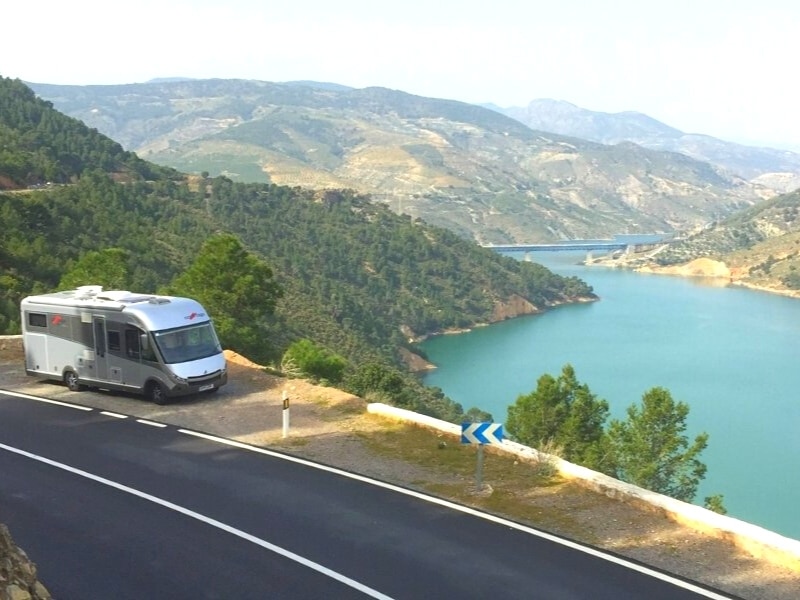
Spain Motorhome Routes
What’s the cheapest way to get to Spain in a motorhome? Do you pay for a long ferry crossing or pay for fuel and tolls doing long miles through expensive France? Your options for driving to Spain from the UK in a motorhome are these;
Sail to Spain from the UK
Sailing from Portsmouth or Plymouth to the northern Spain ports of Santander of Bilbao (depending on which day of the week you want to depart) is the only way to avoid France. This sailing does navigate the Bay of Biscay and can be choppy in autumn and winter, but in our experience, it’s more cost-effective than driving through France.
It’s a long crossing of 32 hours, but does give you the chance to have a proper night’s sleep if you book a cabin. Cabins are not mandatory, but the alternative reclining seats are uncomfortable and noisy.
This is an ideal crossing if time is of the essence, or you’re travelling with a dog (some boats have pet-friendly cabins and some have kennels) but cabins and kennel places do book up quickly.
We recommend you make your booking for the ferry to Spain with Direct Ferries , where you can compare routes and prices to ensure you get the best deal.
Top Tip: Even if you book a standard class cabin, it’s possible to book into the Commodore C-Club lounge, where free hot drinks, water and wine are served, along with generous snacks, meaning you don’t need to pay for expensive food on board.
Is this your first time visiting Spain? Get all our road trip tips in our Spain Travel Guide , including what to pack, the best time of year to go, getting there and practical tips to help you have the best campervan road trip!
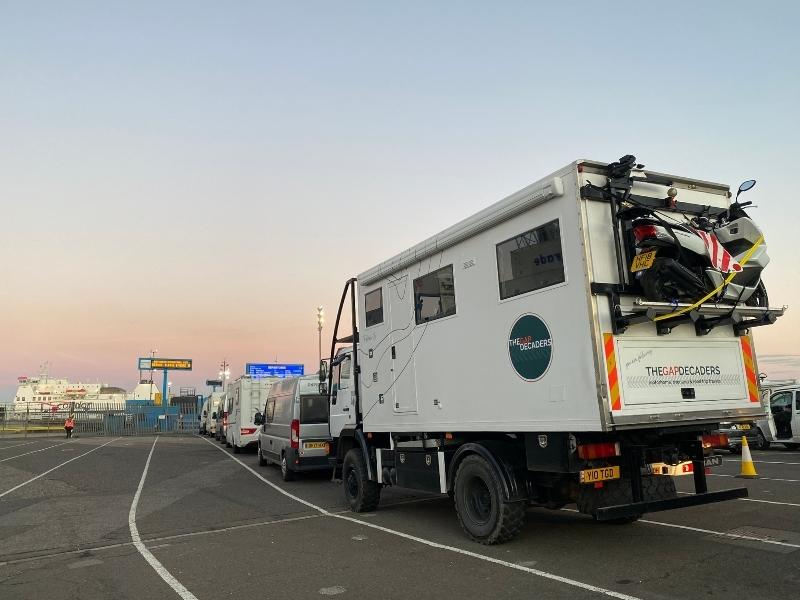
Drive Through France to Spain
Take a road trip to Spain from UK by driving through France. Once in France, head down the west side of the country, via Le Mans, Tours, Poitiers, Bordeaux and Bayonne, crossing the Spanish border at Irun.
This is one of the quickest motorhome routes through France to Spain and is the cheapest from a toll perspective. This route lends itself well to ferries which arrive from the UK in to Caen or Cherbourg.
The driving time from Caen to Irun is around nine hours in a motor home, and tolls will cost somewhere in the region of €170 in tolls, although expect more if you weigh over 3,500kgs.
Or, get to France any way you like and take a slow meander south using non-toll roads and spend some time exploring France as you travel. This is an ideal option if you have plenty of time and are planning a few months or more for your motorhoming in France and Spain trip. Check out our post about driving from the UK to Spain for scenic routes and destination ideas.
Remember if you’re driving across France, you’ll need to observe the French driving laws and road rules, which do differ from the rules in Spain. You can find out more information here .
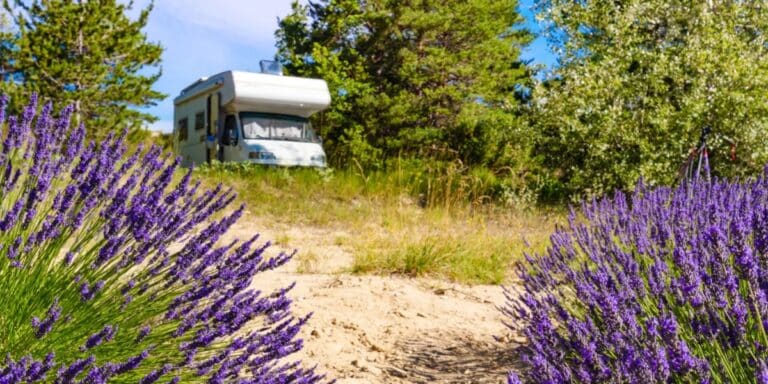
Motorhoming in France: Your Complete Touring Guide for 2024
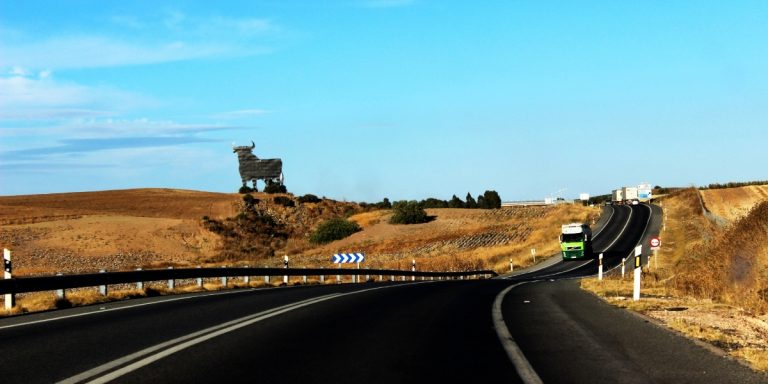
Driving to Spain from UK: Best Routes & Driving Tips
Fly & hire a motorhome, campervan & motorhome rentals spain.
Flying and hiring a motorhome is the best way to tour Spain if you don’t own one. Our recommended Spain campervan hire company is Indie Campers and they have depots in various places including Madrid, Barcelona, Malaga, Seville and Bilbao – perfect starting points to see all the best bits as you road trip Spain .
Another great campervan rental firm to check out is Activans , who specialize in campervan rental near Barcelona with sports equipment, such as surfboards, kitesurfing gear, windsurfing equipment, bicycles & e-bikes.
For Spain motorhome rental – best if you’re travelling with a family or need more room – check out Motorhome Republic , who have over 40 pick-up and drop-off locations in Spain, meaning you can plan a one-way drop-off, or access the bit of Spain you want to see really easily.
An aggregate motohome and campervan booking site, Motorhome Republic pull together all the best deals from a number of renters, to offer you a wide choice of options alongside an excellent English speaking expert motorhome Concierge Team.
You can also hire a motorhome in the UK and drive it across to Spain. Most hire companies allow their motorhome rentals to be taken overseas, including our recommended hirer, Spaceship Rentals . With a depot in London, top-notch customer service and all the equipment you need for an easy holiday, Spaceship offers the best deals for Europe.
Motorhome Spain & Brexit
Although the UK left the EU at the beginning of 2020, because the pandemic came swiftly on its heels, many of us are still realising the repercussions and getting used to how it affects travelling in a motorhome. You can find out all the details you need in our guide to motorhoming in Europe after Brexit . In the meantime, here are a few frequently asked questions and answers;
Do I need a visa for Europe?
Nothing changes with your passport, but from 2025, the EU will introduce the ETIAS (European Travel Information and Authorisation System), which will be an additional entry requirement for visa-exempt travellers and will involve the traveller registering their details online before travelling, mainly for security purposes.
How long can I stay in Europe?
UK citizens can only stay in the Schengen Area (a zone in Europe where countries have no internal borders and allow the free and unrestricted movement of people) for 90 days in every 180 days in the Schengen Area.
The 90 in 180 day rule works on a rolling basis and it can be difficult to work out whether you are within the rules or not, especially if you have visited the Schengen area on several occasions in the preceding 180 days. Use a Schengen calculator to ensure that you stick to the right number of days and stay within the rules.
What food can I take to Spain in my motorhome?
The European Commission says the following;
- Travellers are not allowed to bring in meat , milk or their products .
- There is an exemption for powdered infant milk, infant food, and special foods or special pet feed required for medical reasons if weighing less than 2kg and provided that: such products do not require refrigeration before opening, that they are packaged proprietary brand products for direct sale to the final consumer, and the packaging is unbroken unless in current use.
- For fishery products (including fish and certain shellfish such as prawns, lobsters, dead mussels and dead oysters), travellers are allowed to bring in up to 20kg or the weight of one fish if this is higher.
- For other animal products , such as honey, live oysters, live mussels and snails, travellers are allowed to bring in up to 2kg.
Can I use my mobile data in Spain?
It very much depends on who your mobile phone contract is with and when you started the contract. All UK providers now limit data usage in the EU in some way or another, and it’s best to check with your provider to make sure you don’t run up a big bill. You can find lots of information in our guide to the best SIM cards in Europe , especially if you’re planning to be away for more than a few weeks.
We have been using and recommend ConnectPls for cloud SIM connectivity in the UK and Europe. You can choose from unlimited data packs to just single days, depending on your needs. The device is no larger than a slimline smartphone, connects with up to ten devices, is charged easily with a USB and can be delivered within a few days of ordering. Use the code ‘thegapdecaders’ at checkout to get 50% off in the first month!
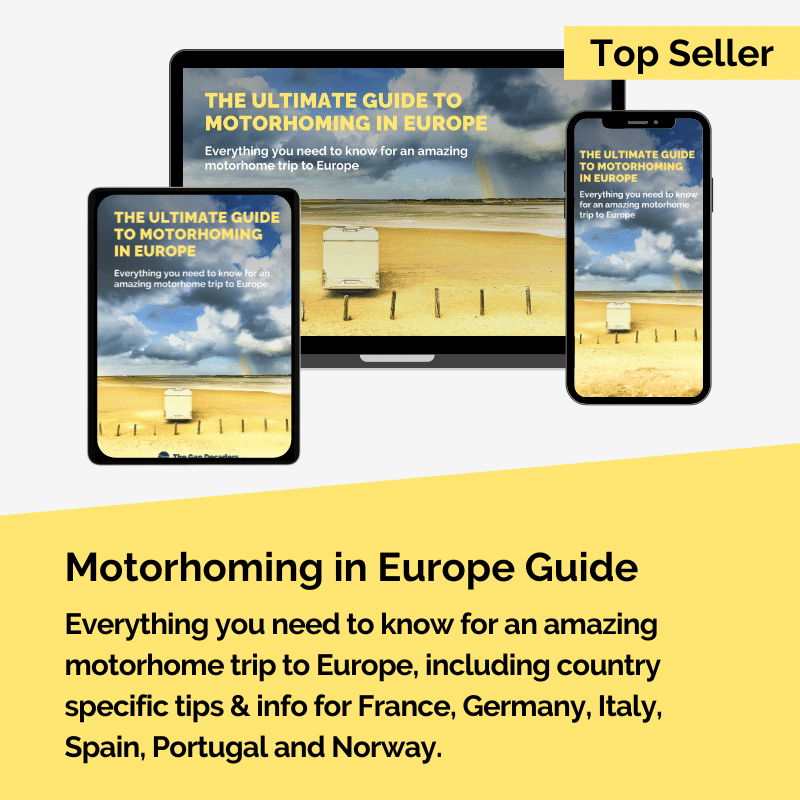
The Ultimate Guide to Motorhoming in Europe
If you’re planning a motorhome trip to Europe for the first time, our guide has tips, advice and info to help you plan your tour.
Don’t struggle trying to plan your European trip, find out everything you need to know before you go + loads of motorhoming tips for when you arrive.
Can I take a pet to Spain in my motorhome?
Yes, you can take dogs, cats and ferrets to Spain. You’ll need to book a pet-friendly cabin or kennels on the ferry or travel via the tunnel. Your pet will need a microchip, a valid rabies vaccination and an animal health certificate (AHC).
It can take some time to get all the documents together and the vaccines organised, so make sure you start the process well in advance. You can find out more about travelling with pets on the Gov.UK website .
More motorhoming in Spain travel advice and guides;
- Tips for Campervan Rental and Motorhome Hire in Spain (and the rest of Europe!)
- What Is the True Cost of Touring Europe in a Motorhome?
- How to Tour Europe in a Motorhome – Your Complete Guide
- Wintering in Spain: Best Winter Destinations in Spain
- The Best European Campsites – For Camper, By Campers
- Motorhoming Tips for Beginners: Essential Know How for Motorhome Life
- 29 of the Best Motorhome Apps – Free & Downloadable Now!
When to Visit Spain in a Motorhome
Spring and autumn are wonderful times for a Spanish road trip – from March until June will get you wildflowers and near-perfect temperatures, warm enough to swim in the sea from May onwards from the Costa Blanca south, and only a light top needed in the evenings.
In the high season of summer it can be blisteringly hot and wild camping can be a challenge without air conditioning.
September and October offer warm sunshine, with the earth and sea still warm from the heat of August.
Motorhoming in Spain in the winter months offers many benefits but be prepared as you may need to use your heating and will find it cools down as soon as the sun sets. Inland and in the Spanish mountains, nights can be chilly and in the north, you may well see snow.
The Spanish Costas can feel crowded with touring motorhomes over winter , as Northern Europeans seek a milder climate. For a more authentic Spain, head to inland rural areas away from the Costas and enjoy everything the mountains and gorgeous interior cities and small towns have to offer.
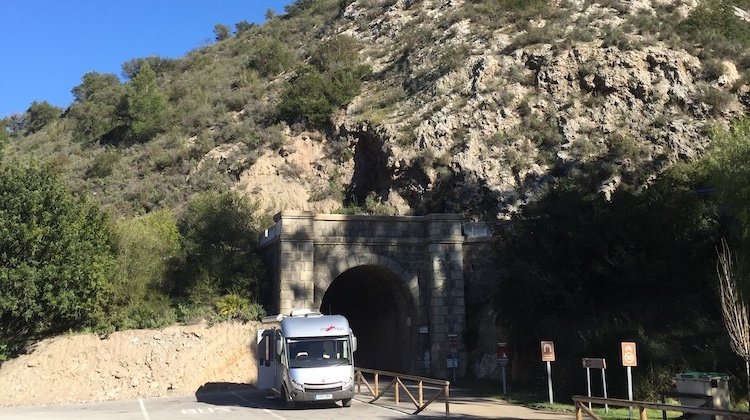
Driving a Motorhome in Spain
Spanish roads are typically well-maintained, and the drivers are considerate and relaxed.
In the interior of Spain in your motorhome, you may well have long stretches of sweeping Autopista (motorway) and autovía (dual carriageway) to yourself. The trade-off is the Costas where traffic ramps up and tailbacks are frequent.
Driving around Spain in a campervan is generally safe and easy, but be mindful of smaller towns without by-passes if you’re in a longer vehicle.
You may want to consider a sat nav or satellite navigation app which can be configured to your motorhome camper size and weight.
Spanish Speed Limits for Motorhomes
Always observe the speed limits when campervanning in Europe . There are speed cameras just as in the UK, and the Spanish (and other EU) authorities have been known to pursue Brits for non-payment of fines. This has not changed since Brexit as the information-sharing agreement with the DVLA continues.
Motorhomes < 3,500 kg (also relevant for those touring Spain by car or campervan)
- On roads where there is no pavement so that vehicles and pedestrians share the road: 20 km/h
- On roads with single carriageways, the speed limit established may not be exceeded by more 20km/h when overtaking.
- In urban areas: 30 km/h
- Outside urban areas: 80 km/h
- Main roads: 90 km/h
- Motorways and autopistas: 100 km/h
Motorhomes > 3,500 kg
- Main roads: 80 km/h
- Motorways and autopistas: 90 km/h
Documents You Need to Travel & Drive in Spain
- You must have at least three months remaining on your passport (issued in the past ten years) at your intended date of departure from Spain.
- You must have at least 3rd party motorhome insurance cover for your vehicle. Update August 2021 – you no longer require a green card to prove you have vehicle insurance cover when travelling in Europe.
- The minimum driver age for campervan and motorhome hire in Spain is 21.
- Your UK licence allows you to drive in all EU countries. If you only have a paper driving licence or a licence issued in Gibraltar, Guernsey, Jersey or the Isle of Man then you will need an International Driving Permit .
- Breakdown cover documentation (not compulsory).
- Vehicle V5 logbook or vehicle registration document (which must show your correct address).
- Trailer certification if you are towing.
- Personal travel and medical insurance along with an EHIC or GHIC card (not compulsory).
- Animal Health Certificate if you’re travelling with a pet.
Make sure you have travel insurance you can trust when motorhoming Spain . We recommend True Traveller for their 5-star TrustPilot reviews, variety of cover options, best activities cover as standard, great prices and excellent service.
Vehicle Safety Equipment in Spain
- Two warning triangles for the front and rear. These warning triangles are now being phased out and from 1st July 2021 a new law requires that a V16 flashing emergency light is used, although both means of advising other traffic will be legal until the end of 2024.
- Reflective jacket (for the driver and all passengers).
- Spare wheel and the tools to change a wheel or a tyre repair kit.
- If you wear glasses you must carry a spare pair.
- First aid kit (not compulsory).
- Spare bulbs and fuses (not compulsory).
- Fire extinguisher (not compulsory).
- Headlight beam converters (unless you can adjust yours automatically).
- From 28th September 2021, you will have to display a UK sticker on the rear of your vehicle when travelling in Spain, even if you have a new style UK numberplate which displays the Union Jack flag.
- If you are driving a motorhome or campervan in Spain and towing, and the overall length is more than 12m (which would be one large motorhome and trailer!), you must have one (130cm x 25cm) or two (50cm x 25cm) yellow reflectors at the rear.
- You may carry a load, such as bikes on a rack, extending by up to 10% of the length of the vehicle to the rear. The load must be indicated by an aluminium panel with diagonal red and white stripes, manufactured to ECE70 standard.
- The use of winter tyres in Spain is regional. Look out for traffic signs indicating that winter tyres or snow chains are compulsory where you are.
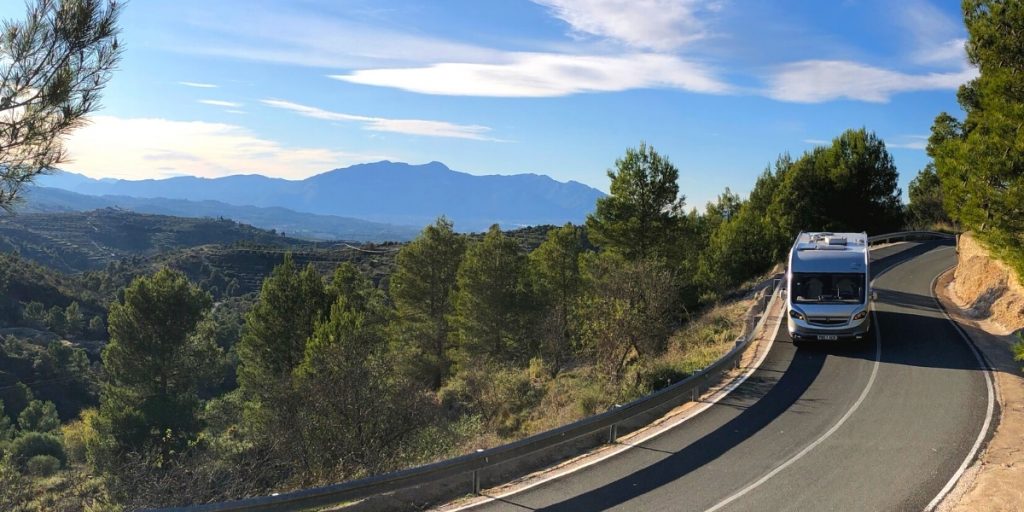
Driving a Motorhome in Spain Tips
- The Spanish drive on the right.
- The UK Department for Transport advises that A-frames are not legal for use by UK motorhomers abroad. In practice, this could mean towing your car while it’s fixed to a trailer, although there is ambiguity around this and differing advice can be found on the internet.
- Campervans or motorhomes and cars with caravans or trailers are not allowed to exceed 18.75m in total length, 4m in height and 2.55m in width.
- Anything with a screen (television, video, DVD etc.) which could distract you when driving should be positioned where you can’t see it. This doesn’t apply to a sat nav but you must not touch or program your sat nav unless parked in a safe place.
- Using radar detection equipment is prohibited under Spanish law and new regulations from January 2021 mean that it will also be illegal to be in possession of such equipment .
- Parking spaces may be used by motorhomes during the day anywhere that parking is allowed (as long as there are no signs specifically banning motorhome parking, which will say something like “ no hay estacionamiento para autocaravanas “) and as long as you aren’t overhanging a space or blocking the road.
- If you have an accident you’ll need to complete the EU Accident Statement , which you can find here to download if your insurer hasn’t provided one. Stop safely and use your hazard lights and warning triangle to alert other drivers. Exchange details (a translate app comes in handy here) and take lots of photos to add to your form when you submit it to the insurers. If the other party won’t give details or there has been an injury, you should call the police on 112.
Toll Roads in Spain
Spanish toll roads are pay-as-you-go and are very reasonably priced. You can pay with cash or credit card, or with an electronic tag system like Emovis , which also covers you in France and Portugal.
Due to the huge swathes of nothingness in the interior, tolls are definitely worth taking if you are trekking from one side of Spain to the other in your motorhome.
In January 2020 and September 2021, many tolls were removed, even for large motorhomes. The AP7 on the Costa Blanca and Costa del Sol retains some charges, but they are minimal and are no longer decided by the weight of your vehicle, making them even better value for motorhomes.
RELATED POST: Tolls for Heavy Motorhomes >3.5T in Europe: Country by Country Guide
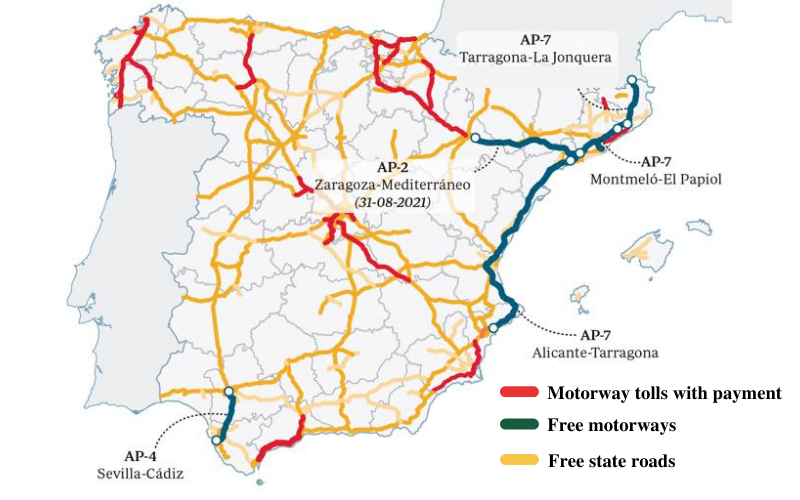
Low Emission Zones in Spain
At the end of 2023, there are 16 low emission zones in Spain.
Due to the Climate Change and Energy Transition Law , Spanish municipalities with over 50,000 residents have to implement such zones by the end of 2023. However, the definition of a Zona de Bajas Emisiones or Low Emission Zone, in the Spanish legislation is quite vague.
Cities may also undertake access regulations that are not defined by motor vehicle emissions standard, but instead reduce traffic and therefore emissions. They can also implement policies to have that same goal, without any access restriction zone.
Spanish plated vehicles will be registered and receive an LEZ sticker, but currently, foreign vehicles can’t buy stickers although they have to meet the required standards.
If you are stopped, you may be able to evidence you meet the standards with your V5C, Certificate of Conformity or LEZ sticker from another country.
The only exception is in Barcelona, where you will need to register your vehicle in order to drive within the LEZ here .
Motorhome & Campervan Services in Spain
Motorhome services are generally widely available, especially along the coast. Some garages and supermarkets will have fresh water and a place for grey water.
You’ll often see the typical pictogram sign by the side of the road pointing you to a service point, this may be a dedicated area, within an aire or another facility.
The types of built-in Flot Blu services like you find in France are few and far between. Use an app like Park4Night to locate motorhome and campervan services.
Motorhome LPG & Gas Bottles in Spain
LPG for refillable systems is available in many garages, use the myLPG app to search near where you are. In Spain, as in most of Europe, LPG is known as GPL, and both are a mix of butane and propane.
In Spain, LPG is grade C, which means the percentage mix of propane to butane is approximately 30/70. Between 1st November and 31st March every year, the mix changes to 35/65 to account for the colder weather.
You may find that if you’re in the mountains in winter, this mix causes your boiler to sound like a freight train unless you have a specific altitude setting which some models of Alde boiler have as an extra. You can find out more information here .
Gas bottles are also widely available, with butane generally being more popular because of the warmer climate (butane is more suited to milder weather conditions but propane is better for cold weather as it burns at lower temperatures).
The Spanish government caps the price of gas, and you should expect to pay around €15-18 for a replacement bottle. For Spanish gas bottles, you will need a different regulator, available from most DIY or camping shops.
Gas in bottles and at the pump is much cheaper in Spain than in France or Portugal (in fact, people often drive their motorhomes from Portugal to fill up!).
Motorhome Fuel in Spain
Most petrol stations will require you to pay electronically for fuel at the pump. Usually, you can adjust the instructions to English. The pump colours are green for petrol and black for diesel.
Sin Plomo 95 is Regular Unleaded, Sin Plomo 98 is Premium Unleaded and Gasoleo (sometimes called Gasoil A ) is Diesel – and sometimes it’s also called diesel in Spain.
Gasoleo B or Gasoil B is the equivalent of red diesel for agricultural vehicles – do not put this in your motorhome!
Diesel in Spain is some of the cheapest in Europe, especially if you fill up at the supermarket, with Cepsa and Repsol garages being the most expensive.
Motorhoming in Spain FAQs
Can you park a motorhome anywhere in spain.
You can park a motorhome or campervan on the street or in a car park provided there is no sign prohibiting this. Remember that ‘parking’ is different to ‘camping’ though, and if you’re free camping in Spain where signage forbids it, you are likely to be fined and moved on, especially if you’re on the coast.
Is Spain campervan friendly?
Yes, Spain is very campervan friendly. The country is well used to snowbirds flocking there in winter in search of the sun, and many facilities for motorhomes and campervans remain open year-round. We have seen an increase in recent years of signage forbidding vans camping and parking, especially along the coasts, but there are still plenty of places to choose from.
What is the best route to Spain in a motorhome?
For us, the best motorhome route to Spain from UK is by boat from Portsmouth to Santander because French toll roads are expensive. But, if you have time, taking a slow meander through France on toll-free roads and making the route a part of your holiday is a better way to get to Spain.
What do I need to drive motorhome in Spain?
You must have a valid driving license in your home country and your motorhome must be legal in the country of registration. If you’re motorhoming in Spain from UK, this means your van must be insured (minimum 3rd party), taxed and have a valid MOT.
Are there campsites in Spain?
Yes! All across the country you’ll find great motorhome campsites. From large campsites with pools, modern sanitary facilities and beachside locations to small rural sites in the interior, Spain has a campsite to suit every type of motorhomer !
Motorhome Stopovers in Spain
Motorhome aires.
Motorhome aires in Spain are not as plentiful as in France but they are out there! As in France, sometimes there is a fee per night but often there is no charge and basic services are provided.
Bear in mind that you are more likely to find Spanish camping aires inland than on the coast. You can read more about aires, how to find them and road trip planning here .
You cannot book aires for camping in Spain, it is advisable in the holidays and in popular places to try and get there early in the morning or just after lunchtime.
If you arrive at 6pm expecting a place, then you will probably be disappointed. Always have a second choice in reserve, one of the best resources to use is All the Aires Spain and Portugal.
RELATED POST: Motorhome Aires in Spain – All You Need to Know
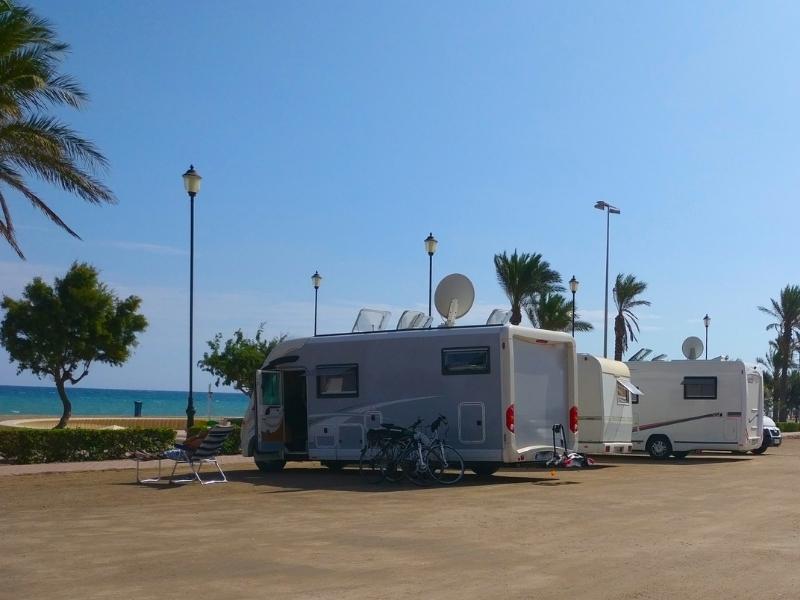
Campsites in Spain for Motorhomes
Spanish campsites range from very basic camping spots in off the beaten path tourist areas to full-on touring stops where people book motorhome pitches up for six months and enjoy entertainment every night, direct access to a sandy beach, three different bars and a covered and heated pool.
Whichever is your bag (and there is a lot of choice), if you’re heading south in your camper in Spain for several months of the winter and a long site stay, make sure you book in advance! Book with Eurocampings for the best deals on over 520 campsites in Spain.
For more information about over-wintering, check out our post about whether you should take your motorhome to Spain for winter .
In the southeast of the country, water is in very short supply. Many camping sites will provide desalinated water instead of potable water.
In the short term, this is fine but you may want to clean out your fresh water tank with a high-pressure hose once you have moved away from this part of Spain due to the sediment found in desalinated water.
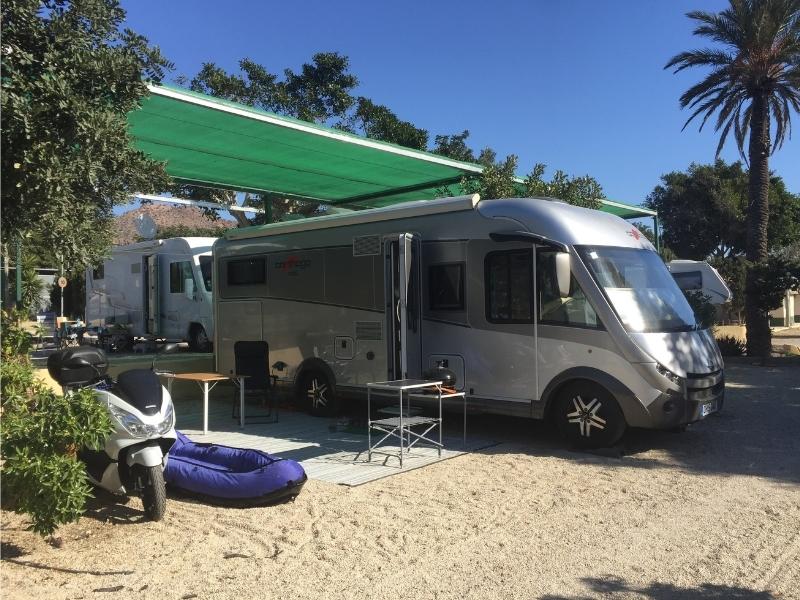
Do I need an ACSI card?
In Spain, your ACSI CampingCard will come into its own if you’re planning on touring and stopping for less than seven nights at sites. Out of season, you can get over 60% discount on ACSI sites.
If you are staying longer, then it is likely that the site’s own rate will be better value – the longer you stay the cheaper it becomes. If you are stopping for over 30 nights it is possible to stay at a good quality site for €10 a night including electricity.
Some larger sites or those run by corporates will have a fixed number of ACSI pitches which will have EHU but no water or drainage.
They will probably be smaller than other pitches and perhaps not as favourably placed. If you want a different pitch, you will be charged a supplement which often wipes out the benefit of the ACSI card, so pick smaller sites for the best experience.
Wild Camping in Spain for Motorhomes
Wild camping for motorhomes in Spain (sometimes called free camping or wild parking) is generally tolerated away from busy beaches, towns and cities, and outside of national parks and and coastal regions.
Free motorhome parking in Spain is easy and safe as long as you follow a few basic guidelines. Make sure your wild camping spot is not on private property and that you have parked respectfully of residents and other wild campers nearby.
The main thing to know about wild camping in Spain is that you must not display any signs of ‘camping’, such as leaving chairs out or having your step out when you go to bed. Thus you are ‘parking’ not ‘camping’ which is allowed and considered a legal activity, even if you intend on sleeping in your van. The infographic below explains the difference.
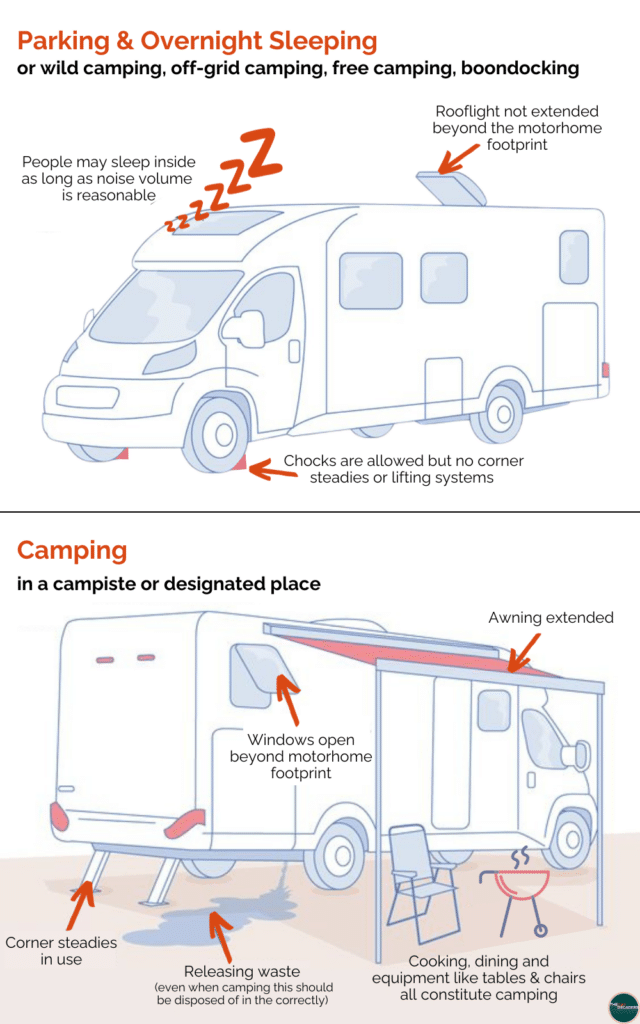
Before motorhome overnight parking, do your usual checks and add an extra one. Look for Pine Processionary Caterpillars when in Spain, which make their nests in those lovely shady pine trees we all like to park under. These caterpillars can kill dogs and small children, and will most definitely spoil your motorhome trip if you bump into one!
Use Camper Contact and Park4Night to find the best wild camping spots for motorhomes and campervans in Spain.
Motorhome wild camping in the Valencia Community is no longer permitted. The Valencia region passed a new law which came into effect on 8th May 2021, which prohibits motorhomes from parking or camping, unless in designated areas. The new decree aims to level the rules whether you’re in a motorhome or tent but there is some acknowledged ambiguity around the wording, you can find out more in this article .
RELATED POST: Motorhome Wild Camping – Your Complete Guide
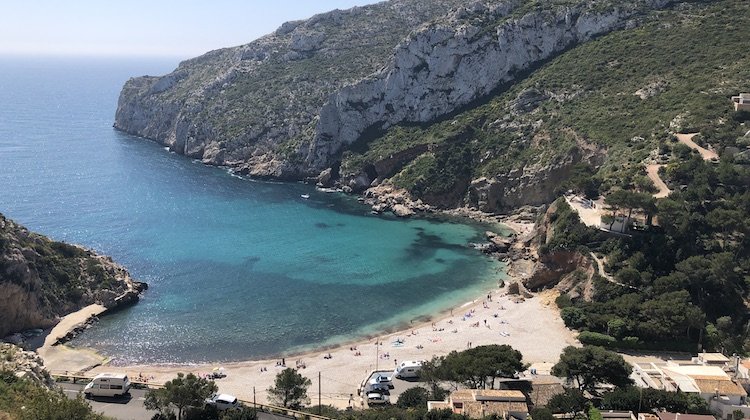
España Discovery
A similar scheme to France Passion, Espana Discovery provides motorhomers with stopovers at over 206 off-the-beaten-path farms, bodegas (vineyards) and producers.
Buy the guide online and get full access to 24-hour stays. There is no obligation to buy any produce, but our experience when we have bought has been really positive.
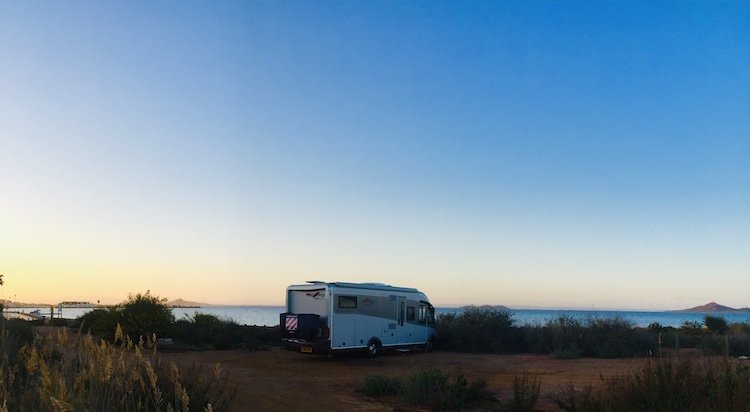
Spain Travel Books

Top Motorhome Destinations in Spain
The pyrenees.
The Spanish Pyrenees are absolutely stunning. Look out for Ainsa, a beautiful medieval hilltop town in Aragón, with incredible mountain views.
If you like to hike, head for the Ordesa y Monte Perdido National Park, to hike the famous Circo de Soaso . This is one of our favourite Spanish national parks, for its dramatic landscape and fantastic hiking.
The Pyrenees is best visited between May and October, unless you want to ski, as outside these times you will definitely encounter snow.
RELATED POST: A Seven Day Pyrenees Hiking Tour
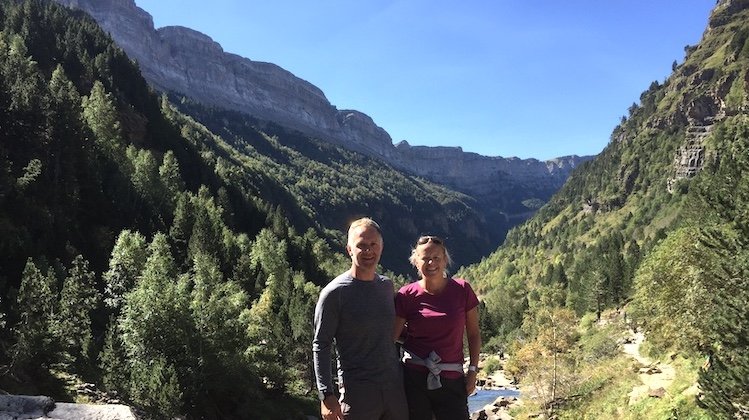
Picos de Europa
Halfway between San Sebastian and Santiago de Compostela, the Picos are a miniature masterpiece. 40km across and wedged between three great river gorges, the Picos’ snowy mountains are a natural paradise.
The Peaks of Europe, so called because they were the first landmark to be seen by sailors of old on approaching the continent, are well worth a visit. There is a lot of diverse hiking here but the weather can be unstable and the terrain unforgiving.
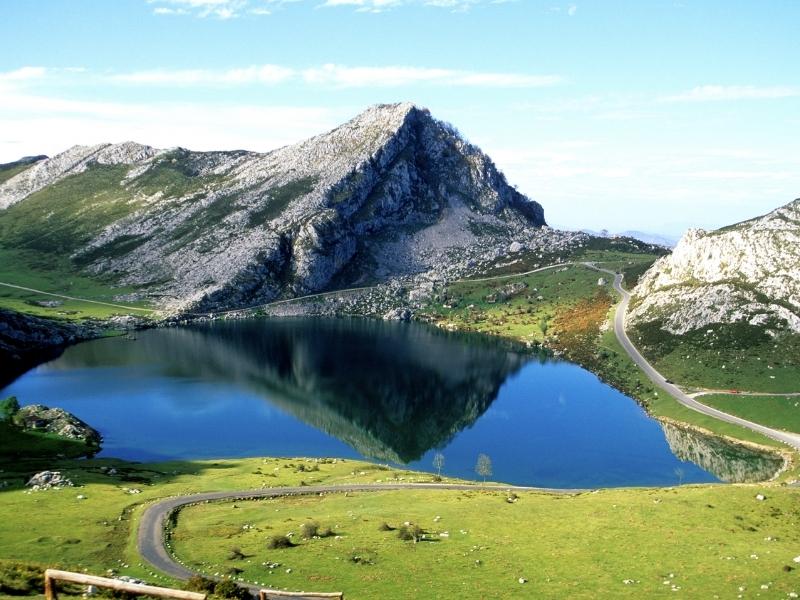
A prosperous and cosmopolitan city with a great vibe. The aire here is on the banks of the river Bernesga, which affords some good running routes along level paths. You will also be within easy walking distance of the Casco Antiguo , the old town.
Wander here for a day and see the cathedral, Plaza’s Mayor and Santa Domingo and the Basilica de San Isidoro. All that walking demands you sample the tapas scene, arguably the best in Spain, with regular live music and tapas that are a bit more inventive than the normal tourist offering.
Order a Cerveza pequeña (small beer) for €1 and get a free tapa, you can do this in all the bars in León and literally have your dinner for nothing!
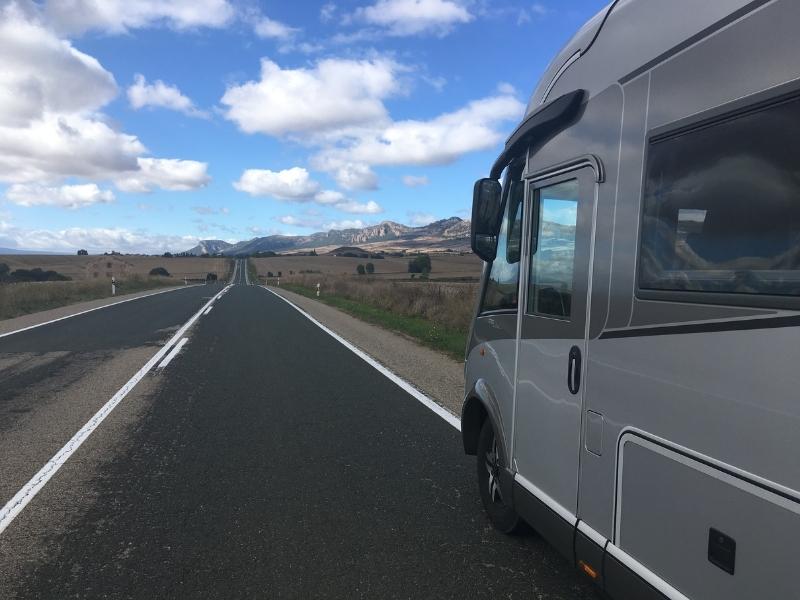
Santiago de Compostela
This corner of Spain, including Galicia, is known as Green Spain because it rains so much! It’s probably best visited in Spring or September/October on your way to sunnier climes. Stay at Camping As Cancelas for easy access by bike or foot into the historic centre.
Santiago de Compostela is a stunningly beautiful city full of twisting alleys, elegant squares and historic religious buildings, with interesting nooks and crannies everywhere.
The medieval centre of Santiago de Compostela is almost entirely pedestrianised, in keeping with its UNESCO World Heritage status. If you only see one thing, it must be the Cathedral, where all roads seemingly lead, including the famous Camino.
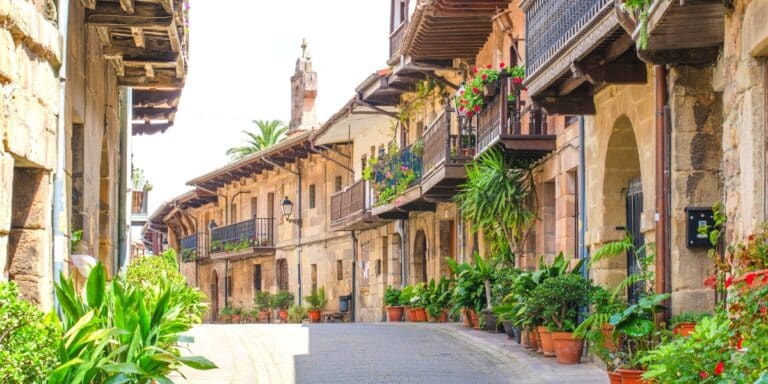
North Spain Road Trip: Itinerary, Route & Tips
The beautiful capital city of Spain has to be visited. Packed with great museums and atmospheric squares and quarters, Madrid is a great city in which to spend a day or so.
We stopped at Camping Osuna in the east of the city, close to the airport. At €35 a night, this is without doubt, the poorest value-for-money motorhome campsite site we have ever stayed on, although our research suggests it’s the best motorhome site in Madrid!
However, in common with most cities, the choice of where to stay in a motorhome is not great. The roads within the site are deteriorating badly and the showers and sanitary facilities are poorly designed (although clean and with plentiful hot water) but this is all surmountable if you want to see Madrid!
What this site does have though, is great access to the Metro. The nearest metro station is Canillejas, about a ten minute walk and on the same line as all the major tourist destination stops, so no changes are required.
Reception at the campsite will give you more information about the Metro and explain the different types of tickets.
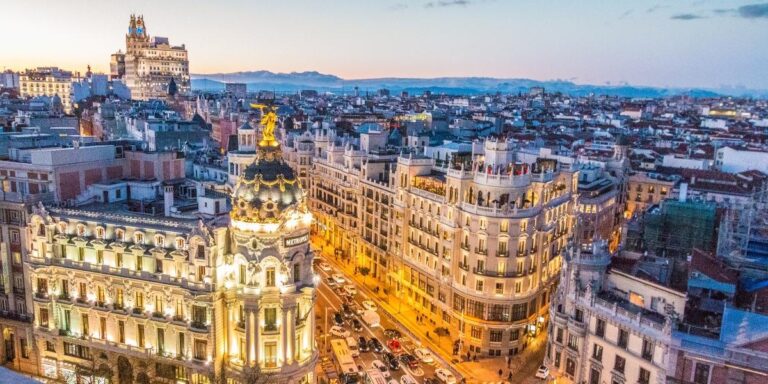
Madrid in One Day: The Best Itinerary, Map, Tips & Guide
Visit La Rábida to see the amazing full-scale models of the three ships in which Columbus and his crew sailed across the Atlantic to discover the New World. We stood looking at these tiny vessels in awe of the courage and belief it must have taken to start that famous voyage.
We parked our motorhome for the night in one of the parking areas in La Rábida, where you can see life-sized replicas of the ships Christopher Columbus sailed across the Atlantic for the New World (and they are tiny ) from Huelva and the Monasterio de Santa María de la Rábida, where the explorer met Queen Isabella of Spain to persuade her to fund the venture and stayed as he prepared for the trip.
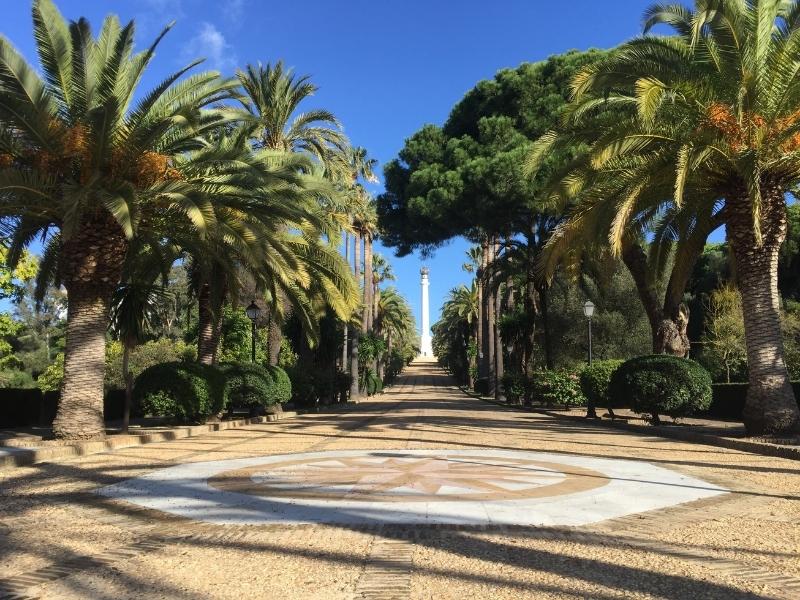
Costa de la Luz
The sea city of Cadiz, between the Donana National Park and Tarifa, makes a wonderful base and enjoys the most hours of sunshine in Spain. Make sure to explore the local area aptly named the Costa de la Luz , or Coast of Light, which extends south to Tarifa, right in the south of Spain.
Off the beaten path on the Costa de la Luz are the beautiful beaches of the Atlantic Ocean which are dotted with chiringuitos serving locally caught fish and pretty white villages like Vejer de la Frontera, quietly unassuming yet packed with history and architectural gems.
The fabulous Cape Trafalgar, the site of the 1805 naval Battle of Trafalgar, in which the British Royal Navy commanded by Admiral Horatio Nelson decisively defeated Napoleon’s combined Spanish and French fleet, is well worth a visit.
To the north is the curious village of El Rocío, famous for it’s dusty car-free streets where horses reign and the Romería de El Rocío, a procession and pilgrimage that takes place on the second day of Pentecost in honor of the Virgin of El Rocío.
Cadiz is also a good base for wine lovers to explore the fabled sherry triangle, which has the cities of Jerez de la Frontera, Sanlúcar de Barrameda, and El Puerto de Santa María at the points of the triangle.
The bodegas where sherry the wine is blended and stored are all located within these cities. We found El Puerto de Santa María a good option as there is a good motorhome site there by the beach, easy access to the bodegas of the town and a convenient ferry to Cadiz.
RELATED POST: Fall in Love with Spain: 20 of Our Favorite Things to See & Do
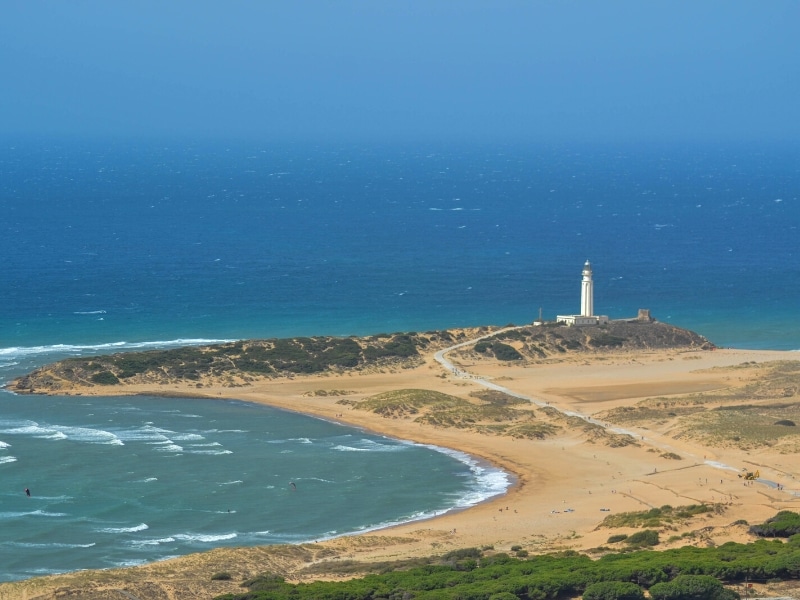
The most southern point of mainland Europe, we loved Tarifa with its laid-back surfer dude feel, sandy beaches and abundant opportunities for activity. So much so that we spent a month there in Camping Valdevaqueros , beating the ACSI price with a long stay deal.
We found some of the best hiking in Spain here and were able to kite-surf, cycle and run, all in the balmy winter temperatures that southern Spain is known for, and hop on the ferry across the Strait of Gibraltar for an overnight trip to Tangier .
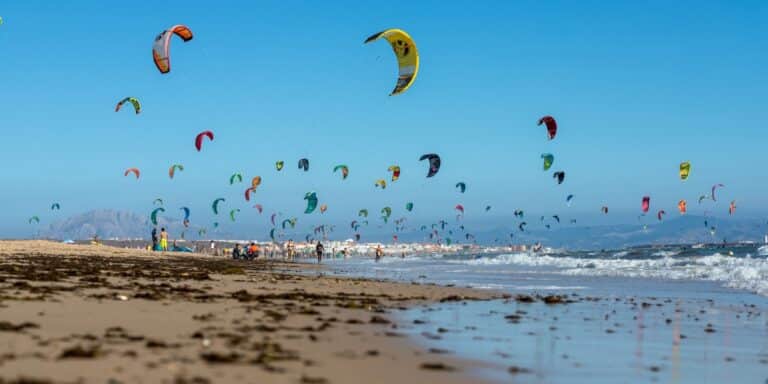
Tarifa Guide: Best Things to Do + Top Visitor Tips
Your next stop should be Seville – you will fall in love with this captivating and romantic city. Spend a few days wandering the old town and narrow streets of Barrio Santa Cruz; admire the architecture and enjoy the typical Spanish ambience.
There are a number of must-sees in the city centre including the Plaza de España, the Real Alcázar, the Giralda Tower and the Cathedral. We stayed at the Port of Gelves just outside the city but accessible by scooter or public transport.
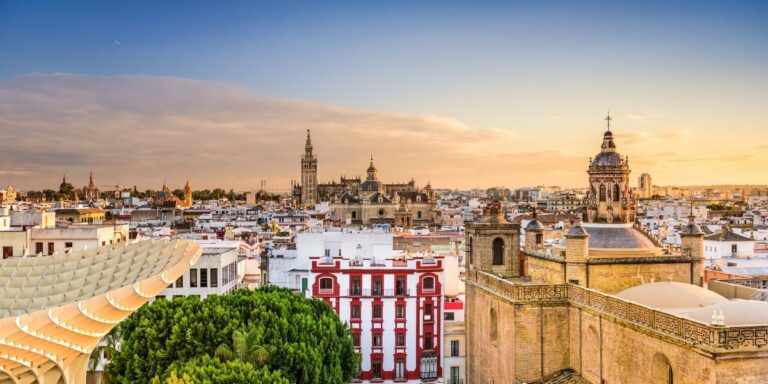
One Day in Seville: Itinerary, Map, Tips & Guide
All across Spain, you will find a network of Vias Verdes – literally translated as ‘greenways’. They are old, disused railway lines that have been converted to cycling and walking tracks, often through stunning scenery with few other users. You’ll often find a Via Verde in close proximity to an aire or off-grid parking spot, like the free camping in the parking lot at Coripe for the Via Verde de la Sierra, a really stunning ride.
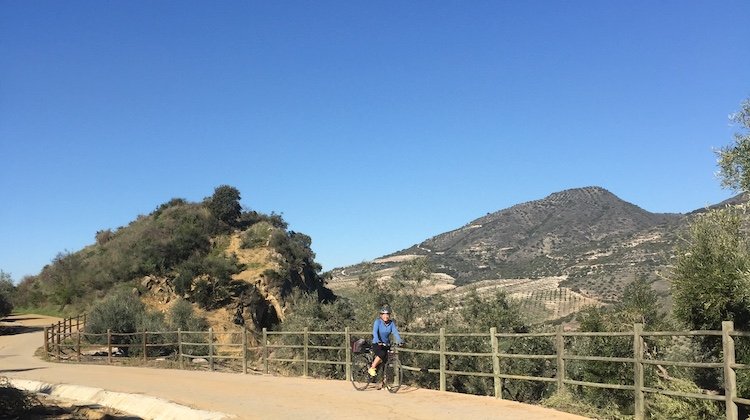
Another beautiful city to fall in love with! Córdoba is full of Moorish treasures. The most famous of these is the Mezquita; the grandest and most beautiful mosque ever built by the Moors which is now a stunning Cathedral. The whole of the historic centre of Cordoba is a UNESCO World Heritage Site, and it’s the perfect spot to spend a day meandering and admiring.
We parked and stayed at the Municipal Camping Car Parking (1 Av. del Corregidor). This is designated motorhome parking, well-lit and manned with CCTV and services but no EHU. Not all spaces are level and the majority were originally designed for cars so have kerbs in what is now the middle of the space!
When visiting Córdoba in a motorhome, this is the only designated parking allowing overnight stays; we found it to be great value for money, with security being important.
You are literally over the road from the old town and within 5 minutes, you will be at the Mezquita.

Cordoba in One Day: Itinerary, Map, Tips & Guide
Ronda & grazalema.
From here, drive south towards Ronda and the Parque Natural de la Sierra Grazalema. This dramatic and wild space is iconic Andalusia; it seems like every hillside cradles a Pueblo Blanco .
Ronda is surrounded by mountains and is split in half by the gaping gorge of the river Tajo. This gorge is spanned spectacularly by an 18th century arched bridge and tall houses perch precariously along its edges.
Head to Zahara de la Sierra and follow the spectacular CA-9104 road to Grazalema, which climbs to the Puerto de Las Palomas (Pass of the Pigeons), at 1180m it’s a spectacular drive and worth the fuel to get there – this is what motorhoming in southern Spain is all about!
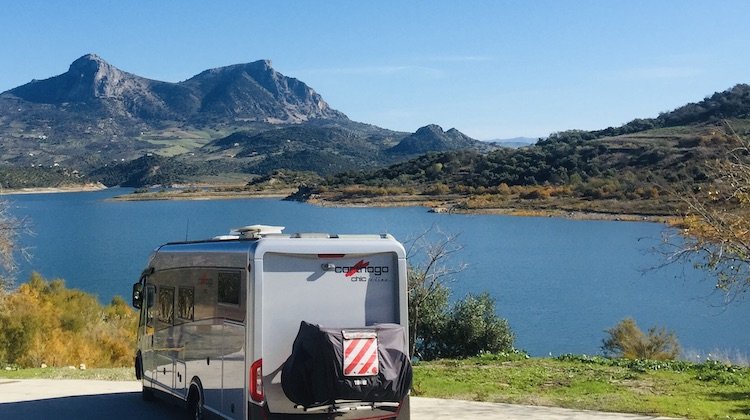
Caminito del Rey
Further to the east, you’ll find El Chorro and the famous Caminito del Rey, one of the most dangerous hikes in the world until the H&S experts got hold of it!
Further to the east, you’ll find El Chorro and the famous Caminito del Rey, one of the most dangerous hikes in the world until the H&S experts got hold of it!
Not only is this a noteworthy hike along the route of the river Guadalhorce it is also an area of outstanding natural beauty worth exploring further. Book this hike well in advance, even outside of peak season, and go with a guide. For an extra few euros, you will learn so much.
We stayed several nights at this great riverside spot , perfect for getting the bus to the start of the hike and then walking back from the end, via the bar of course!
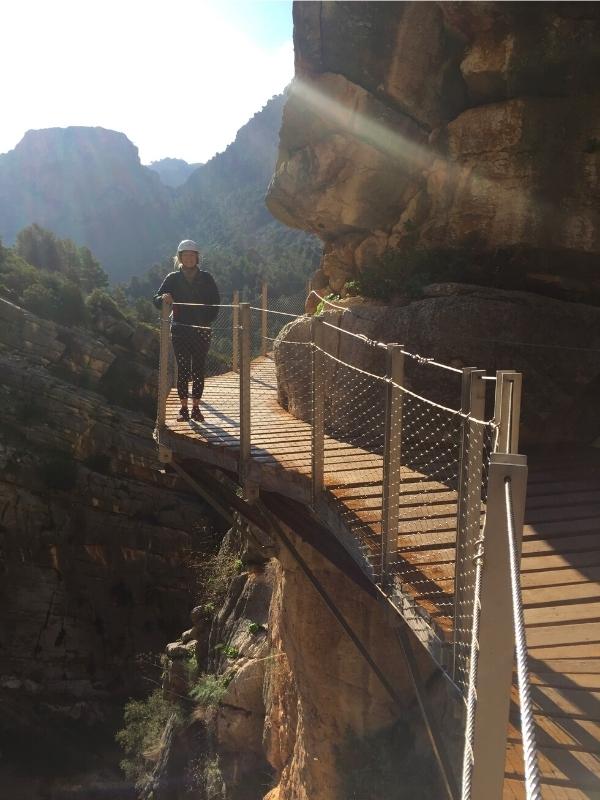
Sierra Nevada
The mighty Sierra Nevada mountain range is home to the highest point of continental Spain and the third highest in Europe after the Caucasus Mountains and the Alps; Mulhacén peaks at 3,479m above sea level.
Take the mountain roads to the romantic city of Granada the romantic city of Granada, and the whitewashed villages of the High Alpujarras, Pampaneira and Trevélez, the highest village in Spain.
In both Pampaneira and Trevélez, we were the only motorhome in their car park, here and here respectively. Although this was in late February, we found all the bars and restaurants open and welcoming.
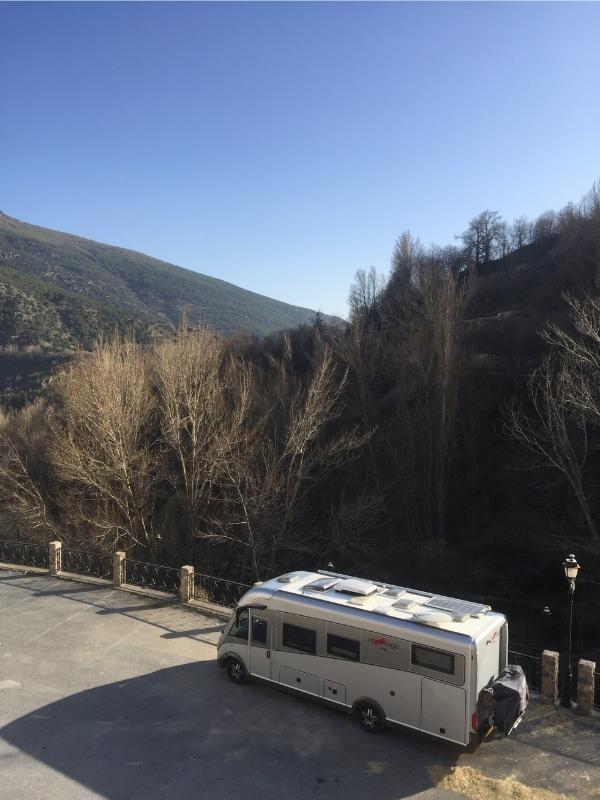
Heading east, stop in the pretty and modern city of Almeria for an afternoon lunch along the promenade. Continue to the arid and wild Cabo de Gata National Park, 71,500 acres of protected land since 1987.
This is a fascinating and ecologically diverse part of Spain with over 80 species of birds living and breeding here.
Go out along the coast in a kayak, canoe or stand-up paddleboard if you can, and marvel at the crystal clear turquoise water, an abundance of sea life, wired rock formations and hidden sea caves.
Camping Los Escullos is a great site with an outdoor pool and fish and chip suppers in their restaurant on Fridays. Situated in the national park close to Los Escullos beach (a good spot for wild camping on the beach in Spain) and a couple of really good hikes, its a great spot and just a short walk from the beach and sea.
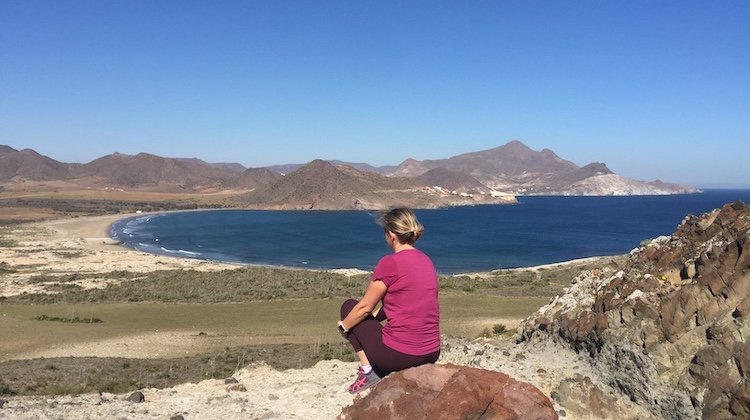
Cartagena is a city we really enjoy for its eclectic architecture and unexpected cosmopolitan feel. Founded by the Carthaginians around 220 BC, the city boomed during the Roman period.
Among its many Roman ruins are a 1st-century BC theatre and Casa de la Fortuna, a villa with murals and mosaics.
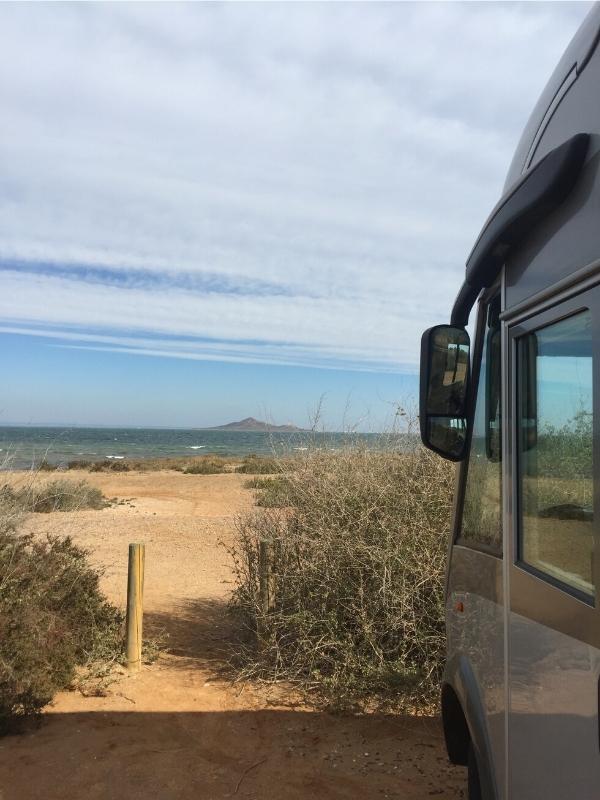
Costa Blanca
The Costa Blanca south of Denia, Javea and Calpe is another beautiful stretch of coast, with built-up areas of urbanizations, holiday villages and amusement parks. This area is popular with expats and motorhomers enjoying all that Spain has to offer, especially during the sunny days of winter.
The cities here are vibrant and busy even in winter, one of the main reasons for the large groups of motorhomers who gather to have a wonderful time in the winter sun. Alicante is a favourite destination, for its lovely old town and fantastic beaches along with its laid-back atmosphere, whilst neighbouring Benidorm is a real party city, with a lively expat and motorhome scene.
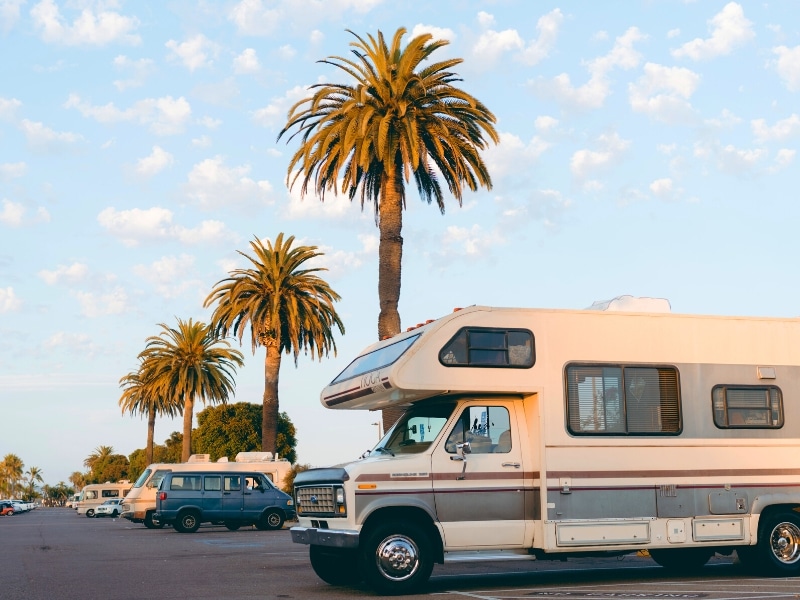
Valencia is a green and vibrant city, with great nightlife and a beautiful Mediterranean climate. Visit the very modern science museum with contemporary architecture and wander the old river bed which runs right around the city.
If you’re feeling brave, go to Valencia during Las Fallas , the famous fire festival. The festival commemorates San José, the patron saint of carpenters and is held from 15th-20th March every year.
If you’re coming from the south, make sure to stop at the wetlands of La Albufera and try the traditional paella which originated here.
There is limited motorhome parking in Valencia, especially during the festival; we would suggest staying here .
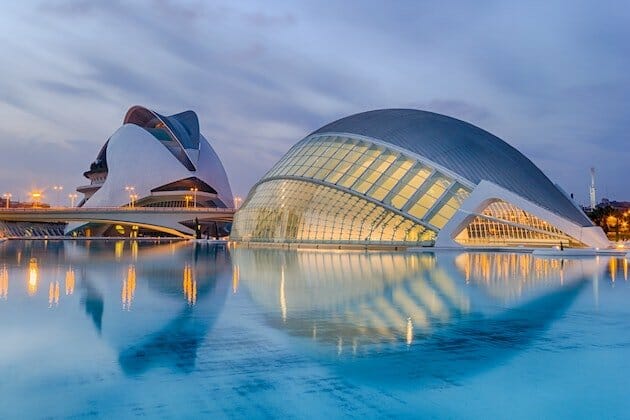
Serra d’Irta
Nestled between Alcossebre and Peniscola the tiny Serra d’Irta Natural Park is just 30 square miles large and is gorgeous for hiking with stunning sea views.
Stay at the lovely Camping Ribamar (although be aware that getting there requires a few km of unmade road) and hike into Peniscola along the coastal path.
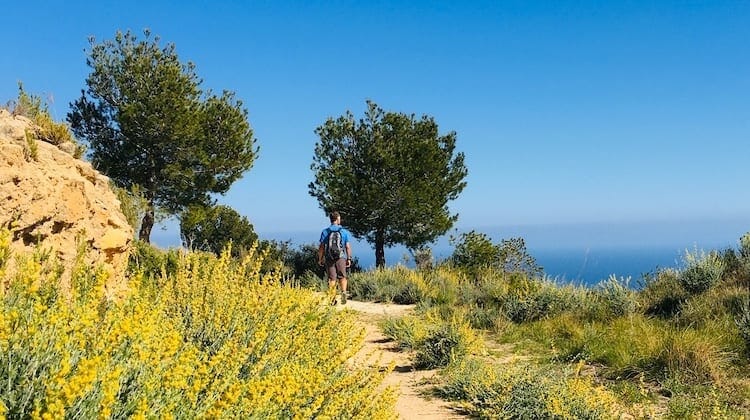
Parc Natural del Delta de l’Ebre
This tranquil and beautiful nature wetland nature reserve in the province of Tarragona is known for its birdlife and encompasses rivers, dunes & beaches. Nature lovers will enjoy find great hiking and bird-watching trails here.
Stay here on the north of the l’Encanyissada lagoon and if you’re lucky you’ll spot flamingoes migrating. On the way, stop at Sant Carles de la Rapita , a charming Spanish town with lots of great seafood restaurants.
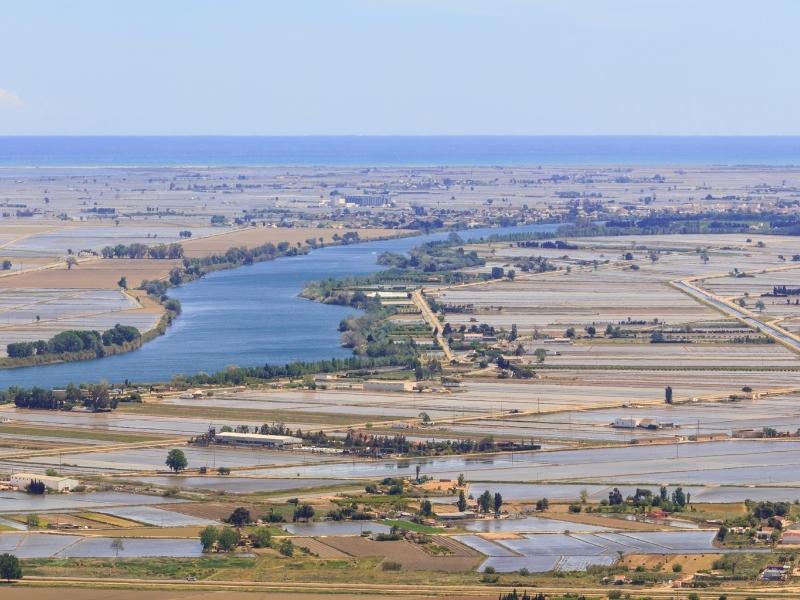
Continue north from here to the cosmopolitan and must-see city of Barcelona. With the fine beaches of the Costa Brava and a beautiful old town, this makes a great final stop on your motorhome tour of Spain. Barcelona is also a real cycling city, with over 160 miles of cycle paths, making it eay to camp on the outskirts and explore on two wheels.
Barcelona is a real foodie city, with a great central market and lots of fantastic tapas bars and seafood restaurants, check out the best restaurants in Barcelona for an authentic gastronomic experience when you visit the city.
Motorhome camping in and around Barcelona is challenging. Try your luck and risk a break-in at the free parking spots or try this campsite , which provides a reasonably priced shuttle into the city and is just ten minutes from the train station where you can catch a train into Barcelona with your bikes.
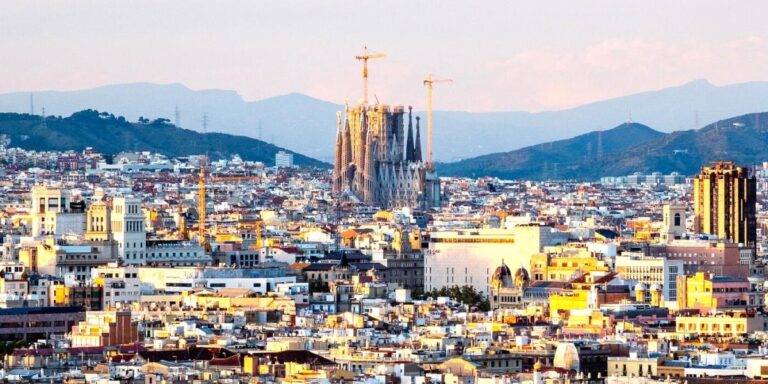
One Day in Barcelona – Itinerary, Map, Tips & Guide
Roses makes a good place for your first or final stop in Spain. Just 35km to the France-Spain border, Roses is both convenient and beautiful.
This is a great place to stop and gather yourself as you enter or leave Spain, and also offers the opportunity to explore the stunning nearby Cap de Creus, a wild and rugged peninsula and a headland. At certain times of the year vehicles are prohibited and you can only discover the area by hiking or cycling.
Stay at pretty Camping Rodas holiday park (only in summer, winter visito should camp here ) and they’ll be able to let you know about restrictions on the road from Cadaqués and the Cap de Creus lighthouse. The site is also just a kilometre from the town centre and 300m from the beach, making it a great choice.

Can’t decide? Our ready-made Spanish road trips are here to help…
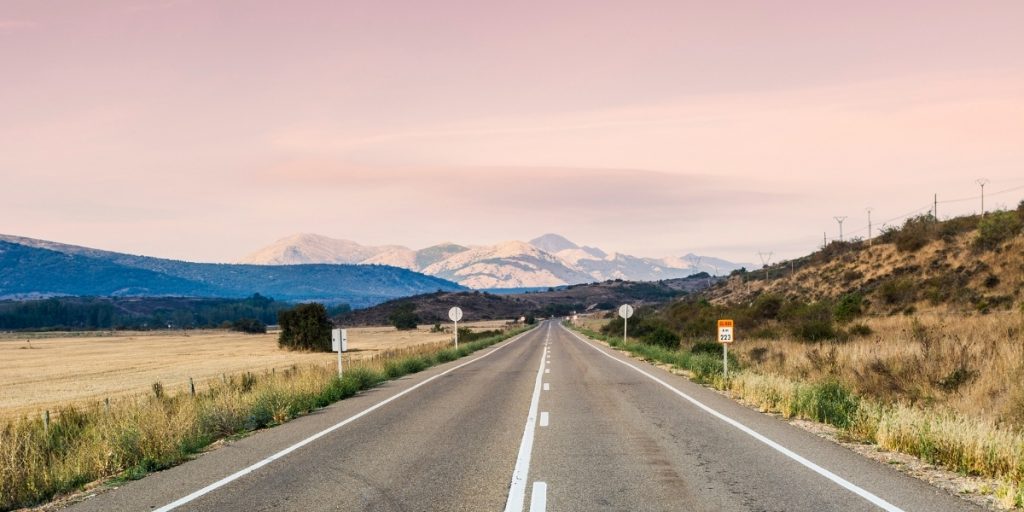
Spain Road Trip: 8 Amazing Routes for an Epic Trip
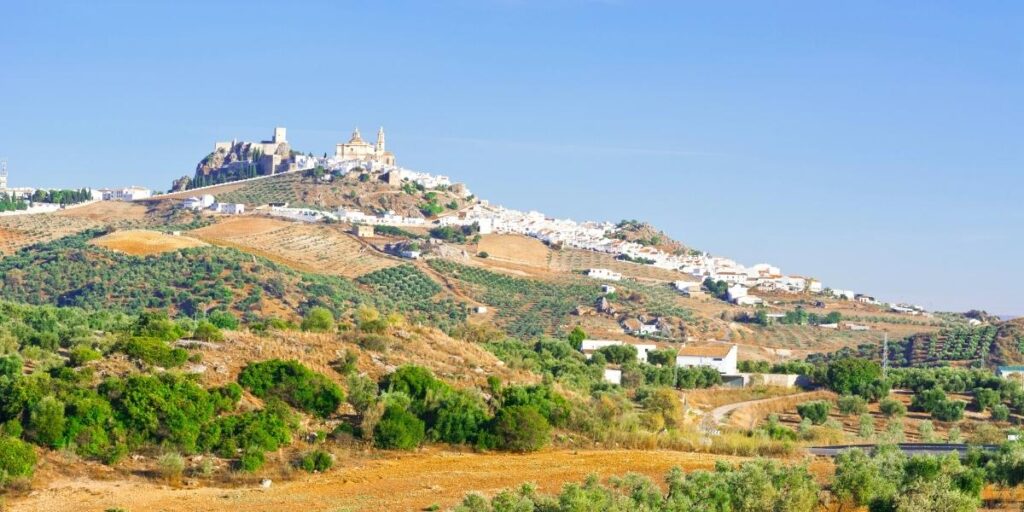
The Perfect Andalucia Road Trip: Itinerary, Map & Tips
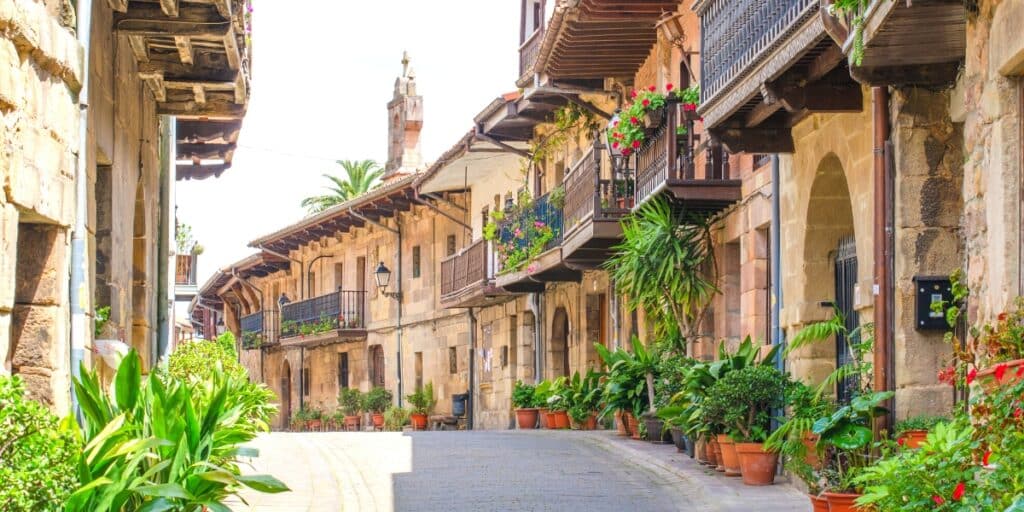
Spanish Life
Spanish life is all about family, religion, food and tradition. Spanish people live a more relaxed life than perhaps any other country in Europe and this is reflected in the organisation of the day. Our useful information and tips about life in Spain will help you navigate the differences between Spain and the UK.
- Spain has a number of different languages. Castilian (or Spanish) is the main language, with Catalan being spoken in Catalonia, Valenciano being spoken in Valencia (both being more like the French language), Galician belonging to the northern region and Basque belonging to the Basque Country. If you want to learn a few words, Castilian is the one to pick as it is the most widely spoken.
- Many businesses close between 12.30 or 1pm until 5pm and then open again until 8pm. This can vary a little from town to town but fundamentally the afternoon is for relaxing and spending time together as a family; if you can’t beat ’em, join ’em!
- Spain celebrates fourteen public holidays a year, many religious in origin; you can check out the dates here. There are a whopping 32 regional holidays, and every town and village has its own annual fiesta, religious in origin, but really all about the music, dancing and sometimes bullfighting. Some of these fiestas have become internationally recognised, such as La Tomatina in Bunol (yep, chucking tomatoes at each other) and Pamplona’s Festival of San Fermin (Running of the Bulls), and are incredibly popular with tourists. This guide has all the information you need.
- Sundays are truly sacred days in Spain. Many people will go to church but it is the extended family lunch, hosted by the matriarch, which is the most important part of the day. Very few, if any, shops are open on Sundays so it’s a good idea to make sure you’re stocked up!
- Following on from Sundays, many shops and restaurants will also close on Mondays with a sign on the door stating ‘ cerrado por descanso del personal ‘ (closed for the rest of the personnel). So make sure you stock up for Mondays too!
- Dog poo is a real issue across Spain. It looks horrible, smells disgusting and it’s a real bummer when you tread in it. Some towns are making real efforts to combat this issue (one traces the poo and posts it back….how??) but in others it seems to be accepted as the norm. You may find that that if you campervan Spain with a dog, the people are not as pet friendly as you are used to, and you’ll often see dogs tied up or confined within rural properties.
- Spanish people talk LOUDLY and over each other constantly. It is not a fight breaking out or a lover’s tiff, it’s just everyday conversation! How four people together all talking at the same time can ever take in what the other is saying is a mystery to me, but they seem to manage it!
- Spanish supermarkets are generally okay, all offering the basics and some a bit more upmarket, such as Carrefour. Mercadona, SuperCor and Eroski are similar in price and quality but do not carry the range of goods you would expect in a UK supermarket. Fruit and vegetables are seasonal; if you want something exotic you will have to search it out and it will be expensive. Lidl carries a good basic range and has by far the best-value wine in Spain. Lidl and Carrefour have great parking facilities for motorhomes, the others less so as they are often more centrally situated in towns.
- Spain is not as ‘finished’ as you might be used to. There are lots of failed projects around and many, many half-built houses and buildings. This is because of the financial crash in 2008 and the subsequent bursting of Spain’s property bubble.
- Whether you like it or not, bullfighting is a huge part of Spanish life and culture. Bullfighting is seen as heroic, a test of wills involving courage, intelligence, and elegance; matadors are national heroes. The bullfighting season runs from March to October with fights usually taking place on Sunday afternoons.
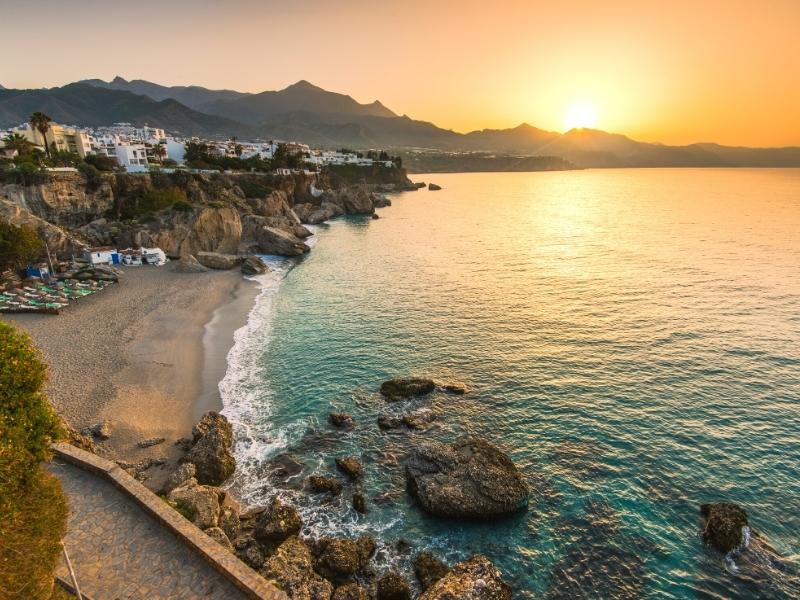
Food & Eating Out in Spain
Mealtimes are revered in Spain, as much about the time spent socialising at the table, as the food.
- Mealtimes in Spain are noticeably different to the rest of Europe. Lunch, which is the main meal of the day, is eaten between 2 and 3pm. Traditionally it was followed by a nap, the famous siesta , a sacred art in rural Spain. Walk around any Spanish village or town in the early afternoon and you will clearly hear the sounds of cutlery on crockery, amid laughter and loud chatter as families lunch together.
- Spain is one of the cheapest countries to visit in Europe and it’s possible to eat out on a budget. Many restaurants will serve a menu del dia or menu of the day. These are usually exceptionally good value and will give you a taste of the local and seasonal flavour and cooking style. Try a dish like berenjenas rellenas (stuffed aubergine) when this Mediterranean vegetable is in season and you’ll be blown away. Service is usually included in the fixed price, which can range from €10 to €18 or possibly more if you’re in a big tourist city.
- La cena (dinner or supper), a lighter meal, is also taken late, between 9 and 10pm, or even later during the hot summer months. Often restaurants will not open their doors until 8pm, this is considered early!
- Tapas is famous in Spain; traditionally it was an appetiser and a small portion of anything on the menu. Like all good things, tapas has evolved and can now be combined to make a whole meal. In some bars, you will get a bowl of pattatas bravas or tortilla with your drink; these portions can be large and we have been known not to finish our meal because of too much beer and tortilla!
- Desayuno (breakfast) is simple and usually sweet. Hot chocolate with churros is a favourite, the chocolate thick gloop and the churros freshly cooked. The Spanish have even invented a takeaway cone with a cup holder for chocolate y churros!
- Spanish cooking is very regional, with fish, shellfish and pork featuring heavily on most menus. Vegetarian or vegan food can be hard to find outside of bigger towns and cities. Often ‘vegetarian’ means made from vegetables, not vegetarian in the true sense of the word. You might get parmesan cheese in a ‘vegetarian’ dish for example, or prawns in a ‘vegetarian’ salad. If in doubt, double check with the chef or waiting staff.
- If you’re planning on dinner, expect the restaurant to be quiet and soulless before 9pm. If you’re going later and you’re in a popular town or city, expect to wait for a table or book.
- Unless you are in an absolute dive or the service is dreadful, it is expected that you will leave a tip, usually around 5%.
- If you are ordering a chicken dish in Spain, be very careful with your pronunciation of poll o . If you ask for poll a , it is unlikely to be served to you as it’s the Spanish word for penis!
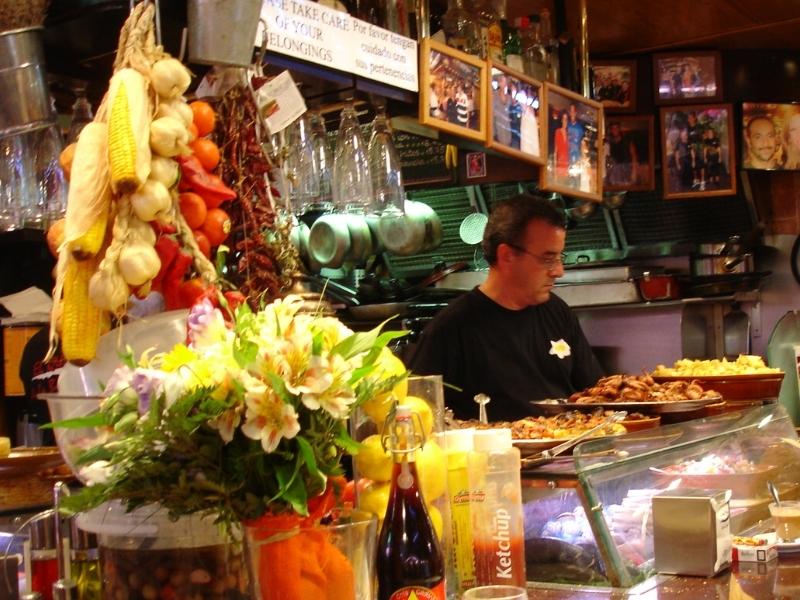
Are you looking for more motorhome touring guides? Check out these top posts…
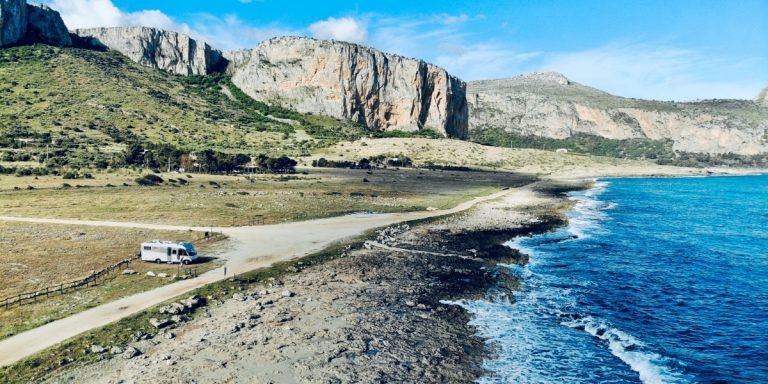
Motorhoming in Italy: Your Complete 2024 Guide
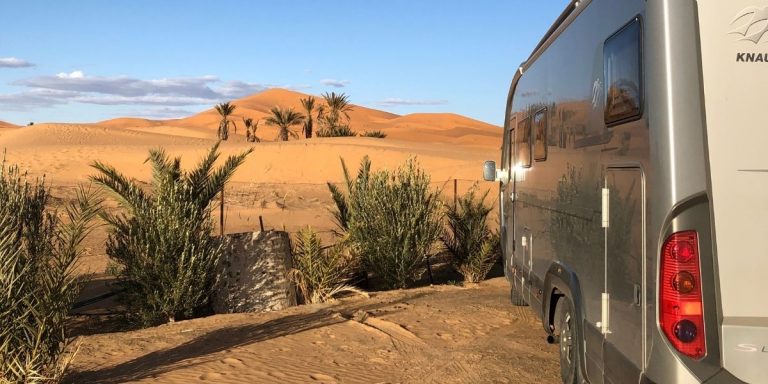
Planning Your Morocco Motorhome Adventure
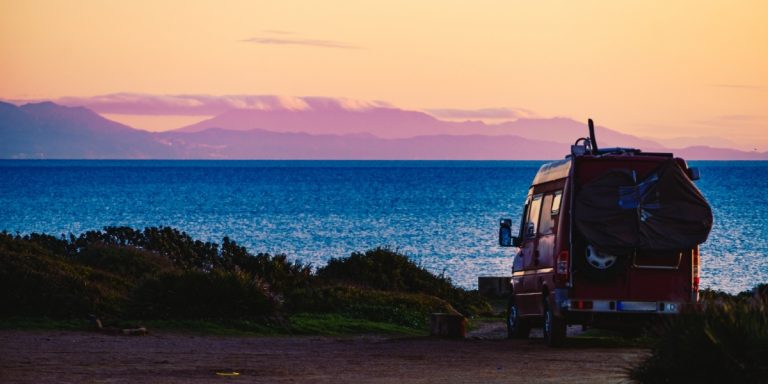
Campervanning in Portugal: Complete Guide for 2024
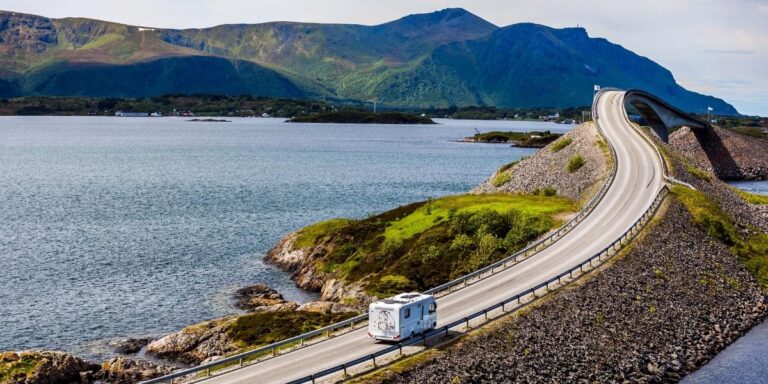
Campervanning in Norway: Tips, Routes & Destinations for 2024
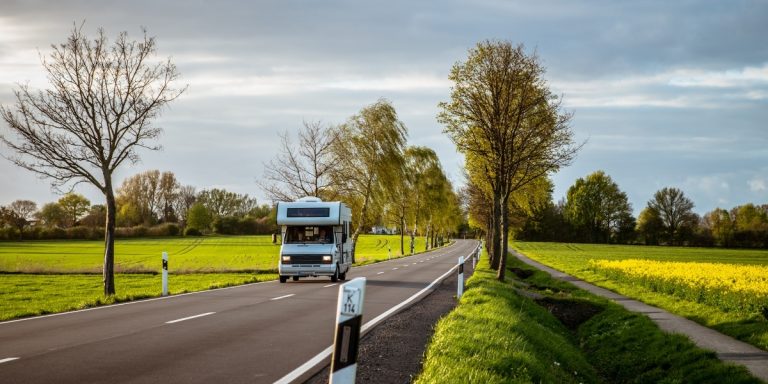
Motorhoming in Germany: Your Complete Touring Guide for 2024
Love it pin it.
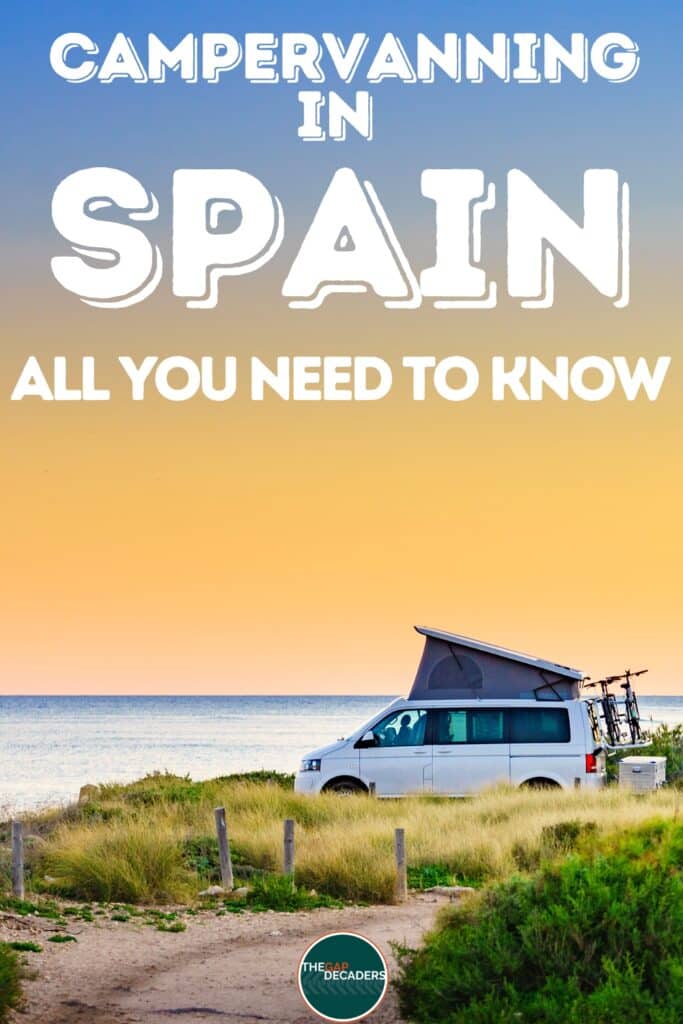
About The Author
Izzy Nicholls
Leave a comment.
Your email address will not be published. Required fields are marked *
Join our Adventure: Get all my insider tips for motorhoming & road trips
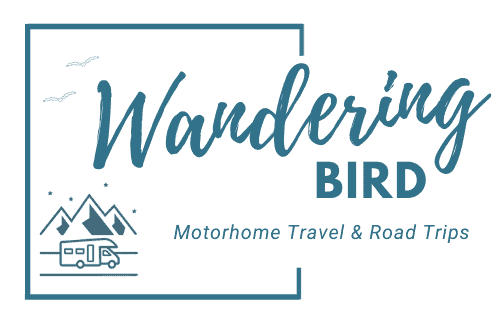
Motorhoming & Campervanning in Spain- The Ultimate Guide
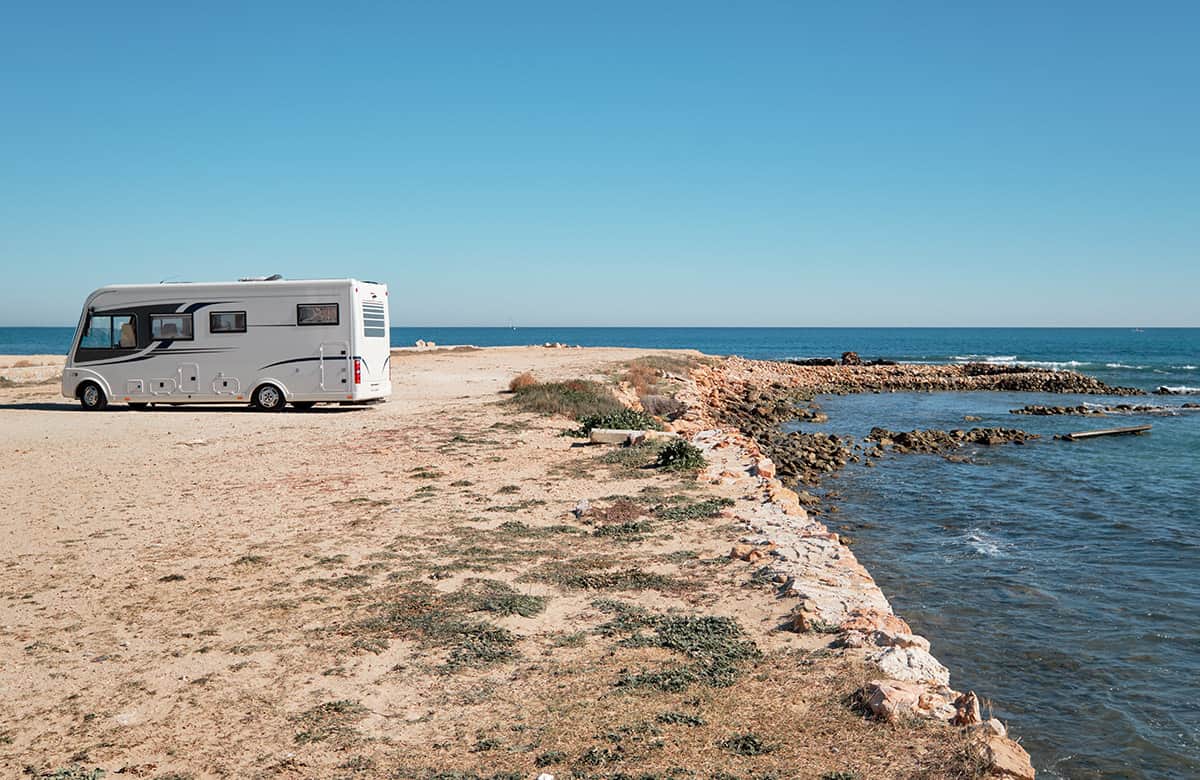
Planning to tour Spain with a motorhome or campervan? There are some essential things you need to know before your trip, including important paperwork and kit to bring with you. Here’s everything you need to know about campervanning or motorhoming in Spain.
Don’t forget to grab your FREE motorhoming in Europe checklist below to help you stay organised and remember everything you need.
*We work hard to make this the best motorhome travel blog and road trip website possible, full of helpful content for you. The website is supported by our readers, so if you buy through links on this site we may earn a commission- at no extra cost to you. All opinions remain our own .
If you find this post useful, you can also treat us to a coffee – we promise to enjoy it while creating more useful content like this- we might even indulge in a biscuit (or two!)
JUMP AHEAD TO...
Motorhoming in Spain- why you should go!
When you think of Spain, many people think of overcrowded beaches in Benidorm, drunken teenagers and possibly Sangria. But, I promise you, there is much more to Spain than the Costa del Sol, especially if you’re travelling and touring in a motorhome or camper.
The landscape changes from the rugged north, with mountains and scenic views to rival anywhere else in Europe, to the desert and arid areas, to the sparkling azure blue of the Mediterranean. There is history and culture everywhere you look, as well as friendly and welcoming people, delicious food and SUNSHINE- even in winter.
Planning to take your motorhome to Europe?
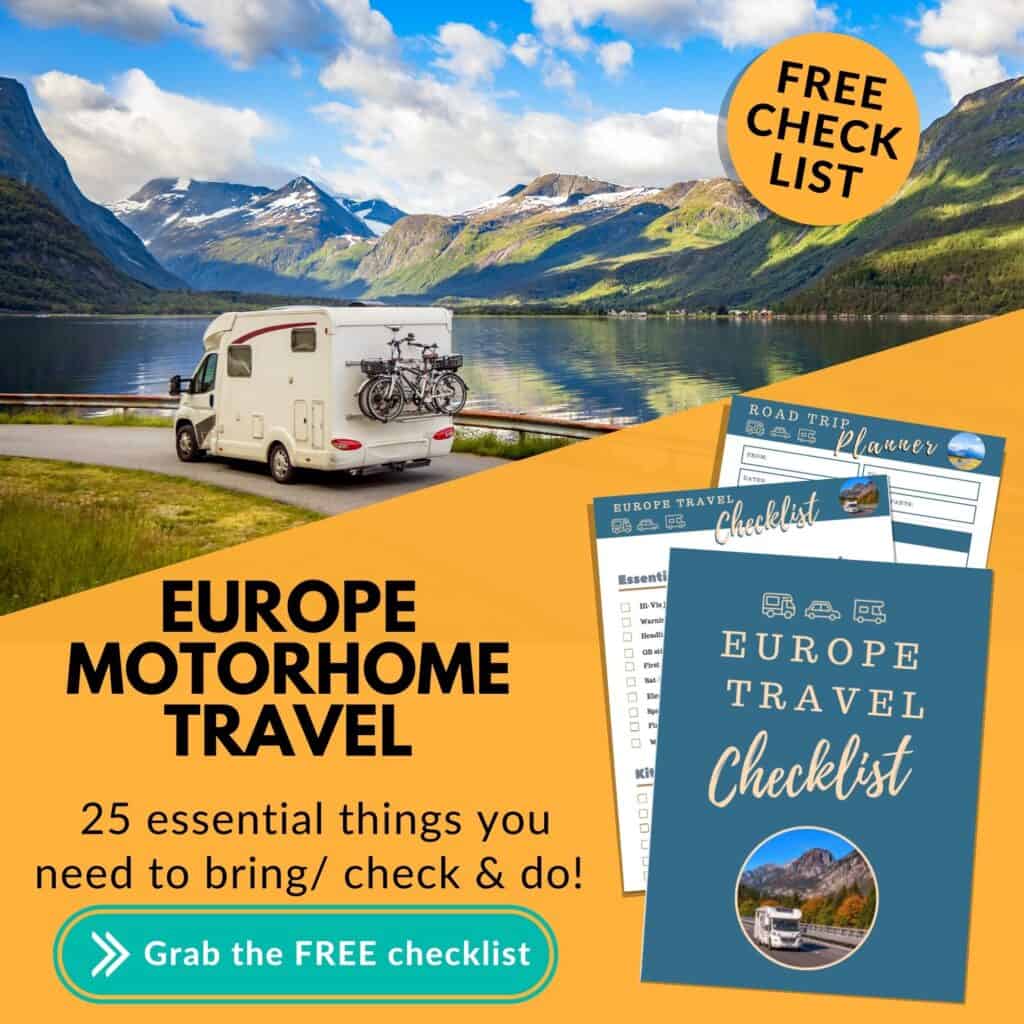
GUIDE: Stop the overwhelm with our step-by-step guide. Contains eBook, checklists and more. Complete Europe Motorhome Travel Toolkit
CHECKLIST: Don’t forget to grab your FREE Europe motorhome travel checklist HERE
GEAR – If you need any motorhome gear for touring Europe, here’s what we recommend.
Campervanning in Spain- Where to go
When planning a motorhome tour of Spain, the first thing you need to do is to figure out where you’re going (and how long you have for your road trip!)
If you’re driving from the UK to Spain (we’ll cover that shortly), you need to allow the time it will take to drive through France to Spain (and back again!) Of course, if you only have a week for your holiday, travelling from the UK and back leaves only a few days to explore the country, and the further south you go, the less exploring time you have.
On the other hand, if you have 10-14 days or longer, you can get a lot further south, certainly as far as Costa Blanca or Andalucia and possibly even get to enjoy motorhoming in Portugal if you’re happy to drive every day.
When to go motorhome touring in Spain
Touring spain in winter.
In our opinion, southern Spain is the perfect European winter destination. It’s warm for one thing, and there’s nothing like a little sunshine to chase away those winter blues. It’s one of the warmest places in Europe in February – average temperatures in Malaga are 18°c (but only 12°c in Madrid- that extra bit south does make a big difference)
In the past, Spain has been VERY crowded during the winter months, especially in the south. Many Northern Europeans (like us Brits!) head to that area to get some winter sunshine.
However, now that BREXIT has happened and rules have changed (more on that later too!), you might find things a little quieter, certainly with British vans.
READ MORE: Discover the best & warmest places to enjoy winter in Spain
Northern Spain is mountainous and you can expect snow during winter- and it will be cold, even on a sunny day (just like in the Alps or any other mountain range.) If you’re planning to stay to the north, you’ll need to bring warm clothing.
Spain Motorhome Touring in Summer
Of course, Spain is a classic summer destination, and it can be CROWDED, especially at the UNESCO world heritage sites in Spain and on the beaches. For us, we find it too hot during high summer, especially as we travel with a dog and keeping a dog cool on a road trip is never easy (especially when they’re a cocker spaniel who doesn’t understand the meaning of the word ‘chill’…!)
If you are going to be travelling to Spain during summer, we highly recommend you have an awning- you’ll definitely need the shade and protection from the sun. You’ll probably also want some form of air conditioning or at least a fan in your camper- temperatures can get up to 40+°c
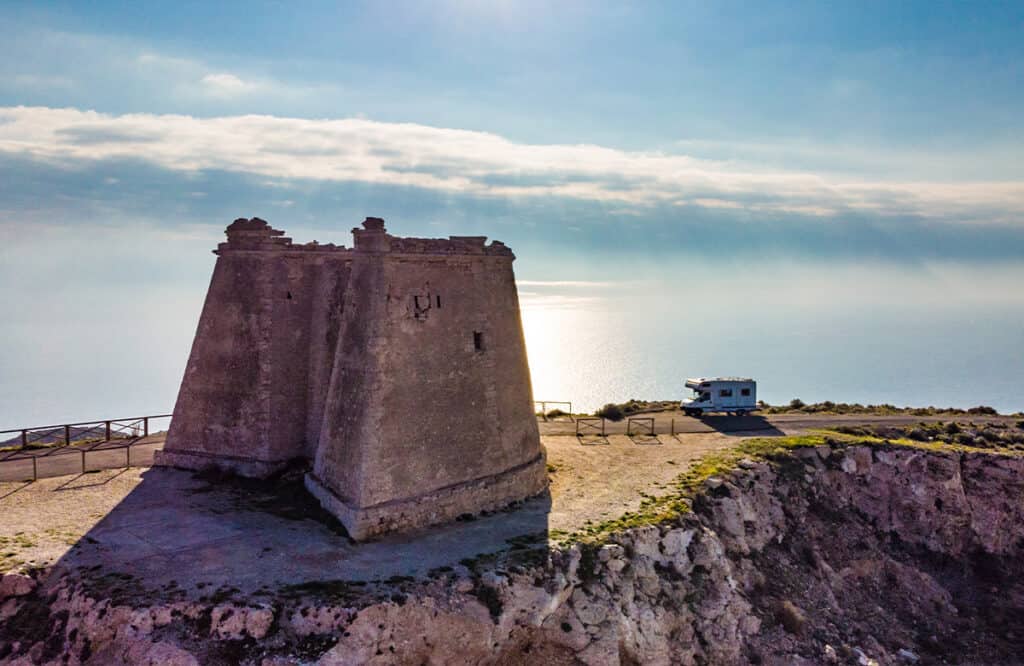
Road tripping Spain in Spring and Autumn
The best times to visit are probably the shoulder seasons of Spring and Autumn. Temperatures are still warm enough to enjoy the beaches and swimming in the sea, but there are much fewer tourists and you will be able to find motorhome parking without booking in advance.
TOP TIP: If you are travelling outside of peak season, definitely get an ACSI CampingCard – you’ll save a fortune on campsites all over Europe, including Spain
Planning a driving route from UK to Spain
For some reason, driving from the UK to Spain seems to confuse people.
Perhaps it’s because there are several options, or perhaps because there’s a mountain range in the way, but it’s something which gets asked over and over again in Facebook groups and forums (feel free to join our motorhoming Facebook group here)
Ferry or driving from UK to Spain?
The first question to ask yourself if whether you want to drive from the UK through France and down to Spain, or whether you want to take a ferry direct from the UK and sail around the coast and down to northern Spain.
Generally, taking a ferry from the UK to Spain is much more expensive than driving through France (depending on time of year and type of cabin).
New to motorhome or camper travel in Europe? You might find these posts helpful:
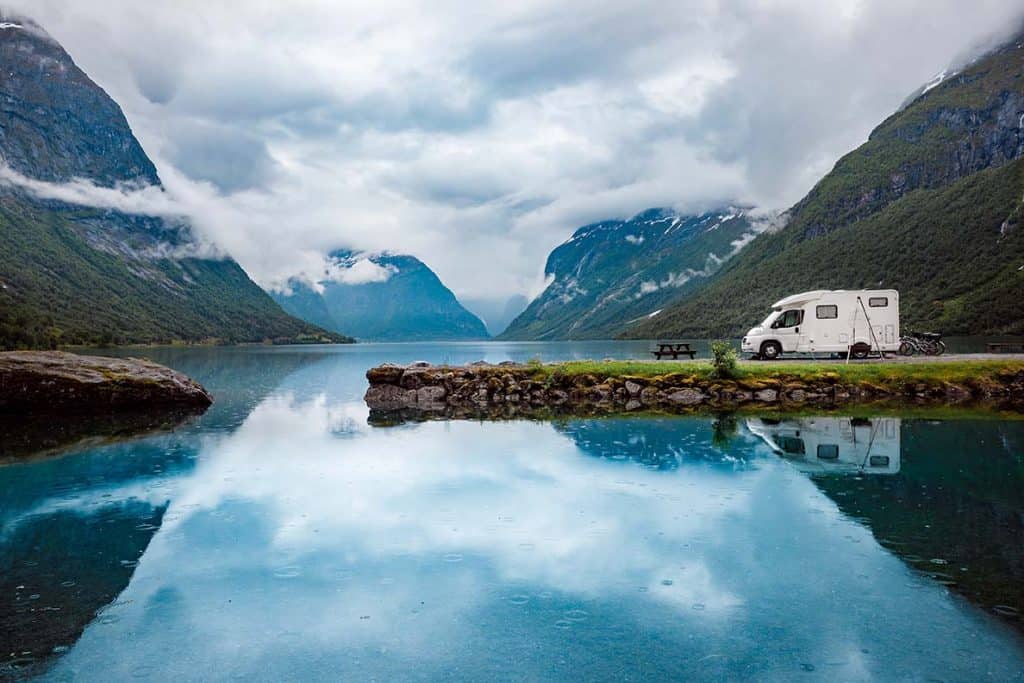
See all our Europe motorhoming posts here
NEED GEAR? If you need any kit or essentials for motorhoming in Europe, here’s what we recommend and where to find it
Ferry with a motorhome direct to Spain
You can travel with Brittany Ferries from Portsmouth or Plymouth and go to either Santander or Bilbao (both on the north coast of Spain)
A one-way trip takes about 24 hours and booking a cabin is recommended. They also have dog kennels onboard but you CANNOT keep your dog in the ferry cabin with you (like you can from Portsmouth to Caen).
The biggest consideration to this ferry (apart from the cost), is the weather. You will be crossing the notorious Bay of Biscay- and it can get ROUGH. Even in the middle of summer. As someone who gets seasick (hilarious considering I’m ex-Navy and lived on boats for 15 years) , I avoid this crossing and prefer to drive from the UK through France to Spain, but it’s entirely up to you.
Driving through France to Spain
If you decide that you want to drive your motorhome or camper down to Spain, you first need to decide if you’re going to take the ferry or tunnel from UK to France (there are pros and cons to both).
Then you have two main routes through France to Spain. Each route takes about a day to drive, so take this into account when planning your Spanish road trip itinerary.
Route 1 is via Tours, Bordeaux and down the Atlantic coast on the N10 until you cross the border between Biarritz and San Sebastian. You can join this route easily if you decide to come over on a ferry to Caen, Le Havre, Dieppe or Cherbourg.
This is our favourite route for a France road trip as you pass some incredible places (including some of the most historic places in France! )
Route 2 is straight south from Calais, skirting around Paris and then down to Clermont Ferrard and Perpignan on the A75 (which is largely free from tolls). The huge highlight from this route is crossing the Millau Viaduct in your motorhome or camper- it’s well worth the experience.
Of course, you can always drive down one route and back up another!
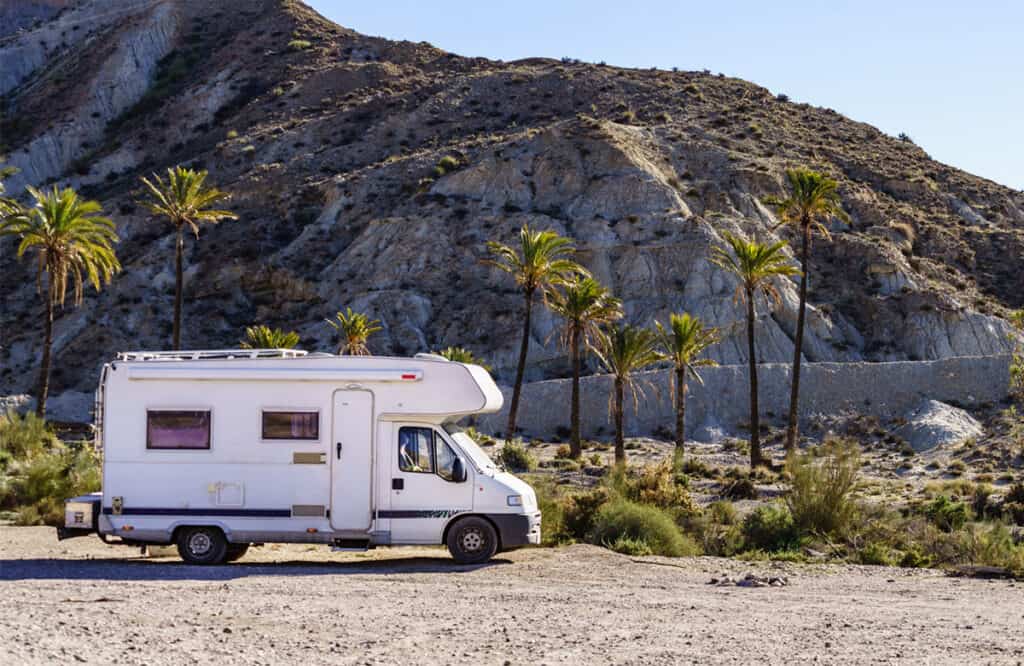
Can I drive to Spain in the Winter?
Yep. I know there are those HUGE mountains called the Pyrenees, but the routes are all open, unless you happen to be really unlucky and hit it in the middle of a snowstorm (do check the weather forecast before travelling.)
If this happens, then we recommend stopping for the night somewhere safe (the beauty of travelling in a motorhome) and then continuing on when the snow has stopped and the roads have been cleared. Don’t forget you will need snow chains and make sure you have fitted all-weather tyres.
Hiring a motorhome or camper to tour Spain
If you don’t have your own vehicle, you can easily fly into Spain and hire one. Just make sure to ask how to get from the airport to the rental agency- not all of them are at the airport itself and you might need to book a taxi.
Don’t forget, it is YOUR responsibility to make sure the vehicle has the required safety equipment. The on-the-spot fines apply to you as the driver, not the company. Check in advance with the company what kit they will provide with the vehicle and what you will need to bring.
Take a list of what is legally required with you and check it off one by one as you are given the handover. Do not drive until you are happy you comply with the local laws.
Make sure you have proof that you can take the vehicle across a border into another country if that’s what you’re planning to do. Read the article below for other things to check as well before you agree to hire.
Want to rent a vehicle for your road trip?
These might help:
- Discover incredible deals for motorhome/ camper rentals
- Find the best deals for car rental
READ: 10 essential questions to ask before you rent a motorhome
Daytime Motorhome Parking in Spain
You can park a motorhome during the day anywhere parking is allowed (as long as there are no signs banning motorhome parking) and as long as you aren’t overhanging a space or blocking the road.
Many places have a sign saying NO motorhome overnight parking, but you are fine to park during the day. You can pull over into a rest stop and eat and drink within your vehicle, but setting up a table and chairs next to the road is not allowed.
Nor is getting out the awning and putting up your TV aerial. (Yes, you will see other people do it- some areas are stricter than others. If everyone else is, feel free to join them but remember you may be asked to move on.) Remember, this is for daytime parking for motorhomes- let’s move on to overnight parking…
Campervanning in Spain- motorhome overnight parking
As with most countries in Europe, you have four options when it comes to where to park your motorhome or camper overnight:
- Motorhome campsites
- Approved motorhome overnight parking places/ aires
- Free approved overnight parking spots/ schemes
- Motorhome wild camping spots
Sadly, Spain is getting tougher about free overnight motorhome parking spots and many places now ban them completely. Legally, you’re only allowed to stay on approved overnight motorhome spaces or campsites. Wild camping is not allowed in any of the Spanish National Parks.
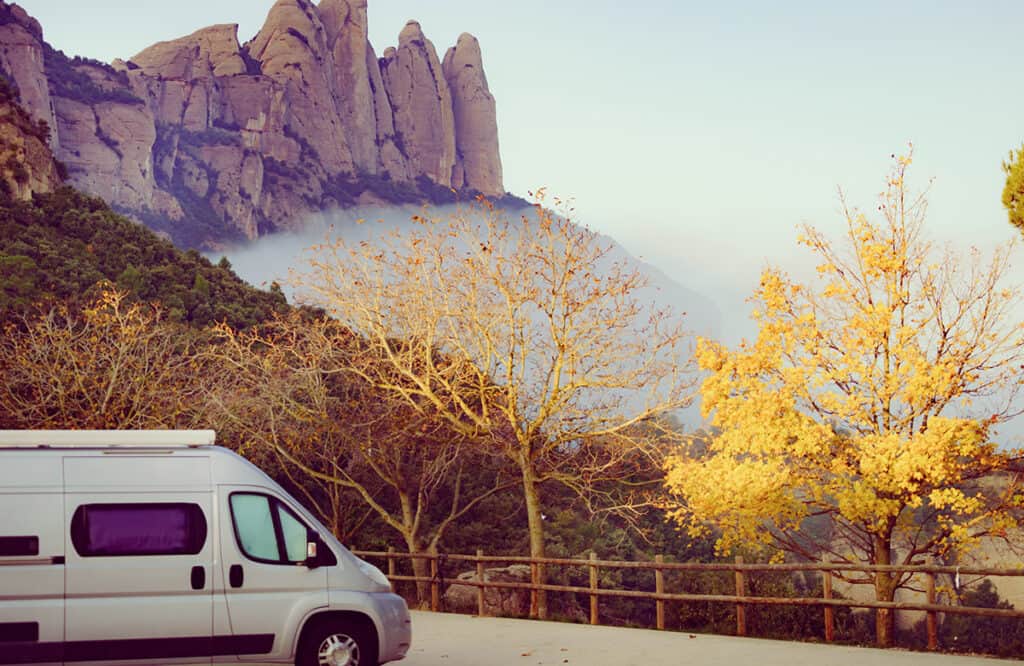
Motorhome campsites in Spain
It’s easy to find motorhome campsites in Spain and they’re much like campsites anywhere else in Europe. Some are rustic and have basic facilities, while others are designed for long-term visitors and have entertainment, clubs, pools and bars! Expect to show your passport or identification on arrival and many places require you to leave one passport behind the reception.
If you’re travelling out of high season and are planning to use campsites, we highly recommend buying an ACSI CampingCard membership , but be aware that many campsites either shut during the winter or are booked up entirely months in advance, so you may wish to book one too. Also, many campsites put ACSI users on ‘lesser’ pitches (either bad view or no electric or drainage). You can ask for a different pitch, but will usually need to pay a supplement which wipes out the ACSI discount!
At some campsites, you will need to pay extra for shower or electric usage. Be warned- the hot water in the shower is on a timer- usually between 3-5 minutes per token. Water is regulated in much of the country, especially in the south, and many sites provide de-salinated water instead of potable.
We recommend you don’t drink this water and also clean out your motorhome freshwater tank thoroughly before refilling it to get rid of the particles found in de-salinated water.
TOP TIP : If you’re planning to stay in one area for a long time (30+ days), negotiate a special rate with the campsite directly. Most of them have some sort of discount- some are as little as £10/ day, including electric.
Motorhome Aires in Spain
Aires are just approved motorhome overnight parking places- often provided and maintained by the local commune. If you’ve been motorhoming in Italy , you might surprised to learn that aires are called Aires in Spain, just like in France (they’re called Sostas in Italy).
There aren’t quite as many aires in Spain as in France and they’re often a little more out of the way, but the network is still very useful and easy to use.
READ MORE: Learn how we find and use aires and approved free overnight motorhome stopovers across Europe
You cannot book motorhome aires in advance- it’s first-come, first-served, so if you’re visiting at peak times you might feel happier booking a campsite so you’re assured of somewhere to stay.
A good tip is to try and arrive AT your destination just before lunchtime. Many people move on after. a lazy morning, and stop en-route, so you have the best chance of finding a spot around this time, but that’s when the day is at its hottest, so be careful.
It’s always worth investing in a book of aires, as well as an online app- just in case you find yourself without internet in your motorhome (or without a wifi signal). Of course, the downside with any book is that it goes out of date, but don’t worry if it’s only a year or two out- most information about aires won’t change too much.

Wild camping in a motorhome in Spain
Like much of Europe, wild camping in Spain for motorhomes and campers is ‘tolerated’ in many places but not strictly legal and it’s certainly not a right. Many people seem to think they can turn up and park wherever they want, but this is not the case.
Motorhome wild camping guides for the UK & Europe
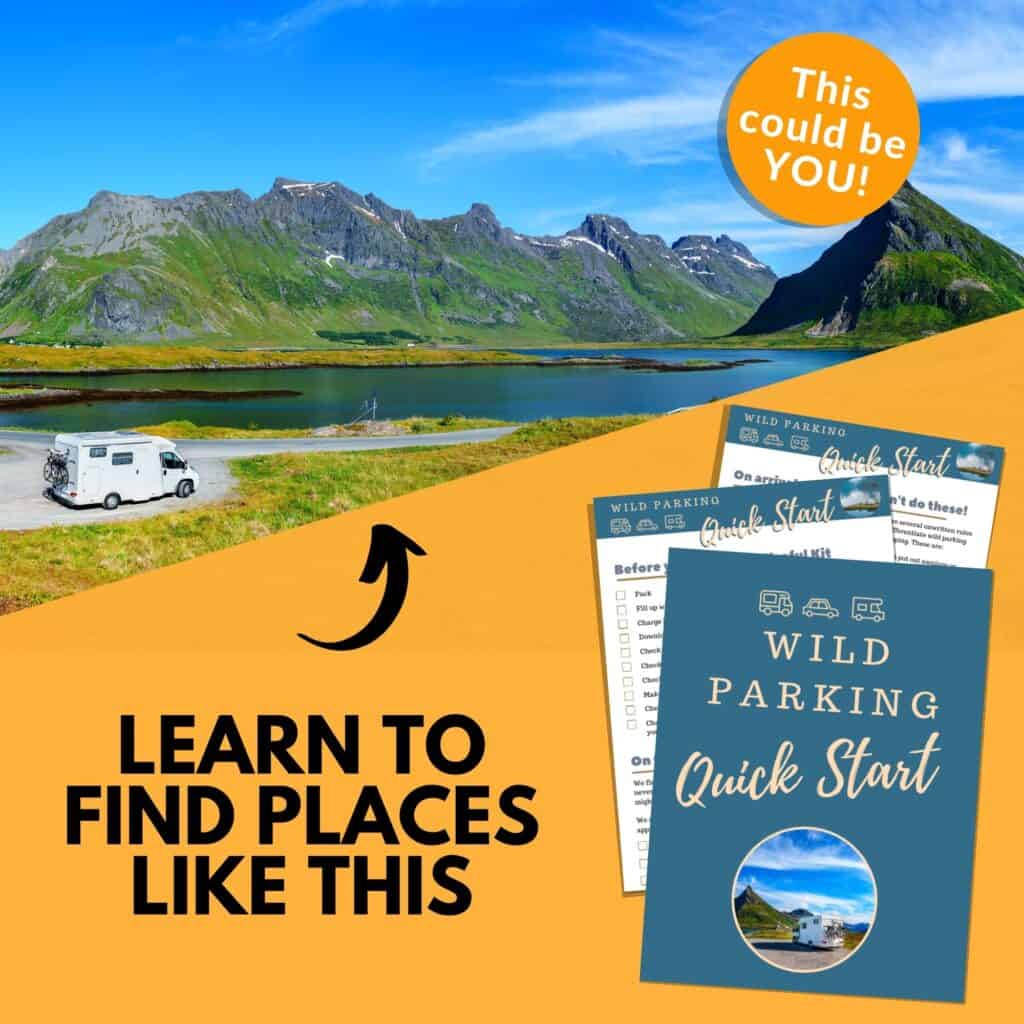
For information on how to find good wild camping places, WHAT to do when you’re there and how to stay safe, check out our step-by-step guide for motorhome wild camping in the UK and Europe, complete with database of 250+ overnight spots we’ve stayed with our motorhome.
Don’t forget to grab your free wild camping checklist here
In practicality, you’ll find that the further from civilisation and the beach you are, the better your chances of finding a quiet, free overnight parking spot will be. If in doubt, you can always ask at the tourist office or town hall- many places are happy to allow you in their car park for the night.
However, with a little common sense and staying within the restrictions, it’s often possible to stay off-grid with your motorhome or campervan.
- Don’t try and wild camp on the coast unless you’re somewhere REALLY remote (more likely to be allowed in the North and centre of Spain)
- Don’t try and wild camp in busy/ popular areas- like the Costa del Sol- unless you’re visiting in the lowest of low season. Anywhere near the beach will be tough all year.
- Get the permission of the landowner if possible
READ MORE: There are some basic rules to follow whilst motorhome wild camping – here’s everything you need to know to stay safe and find free spots.
Can you wild camp with a motorhome in the Spanish National Parks?
No- wild camping is not permitted in any of Spain’s National Parks.
Other Motorhome stopovers in Spain
If you’d like to avoid campsites and aires, but don’t want to risk staying off-grid, there is a scheme which connects business owners to people motorhoming or campervanning in Spain, called Espana Discovery .
You can buy an annual guide for just 27€ (in 2023) and it gives you access to over 200 businesses which allow motorhomes to park up overnight in exchange for buying a meal in their restaurant or a few bottles of wine at the vineyard. Some spots are even right on the beach!
Motorhoming in Spain- what gear do you need to carry?
Just like motorhoming in France , there are certain things you MUST carry with you in your motorhome or campervan whilst touring in Spain.
Don’t forget, if you are driving through France to get to Spain, you need all the kit required by France as well as the kit for that country.
Grab your FREE France travel checklist so you remember it all!
Planning a trip to France with your motorhome or camper?
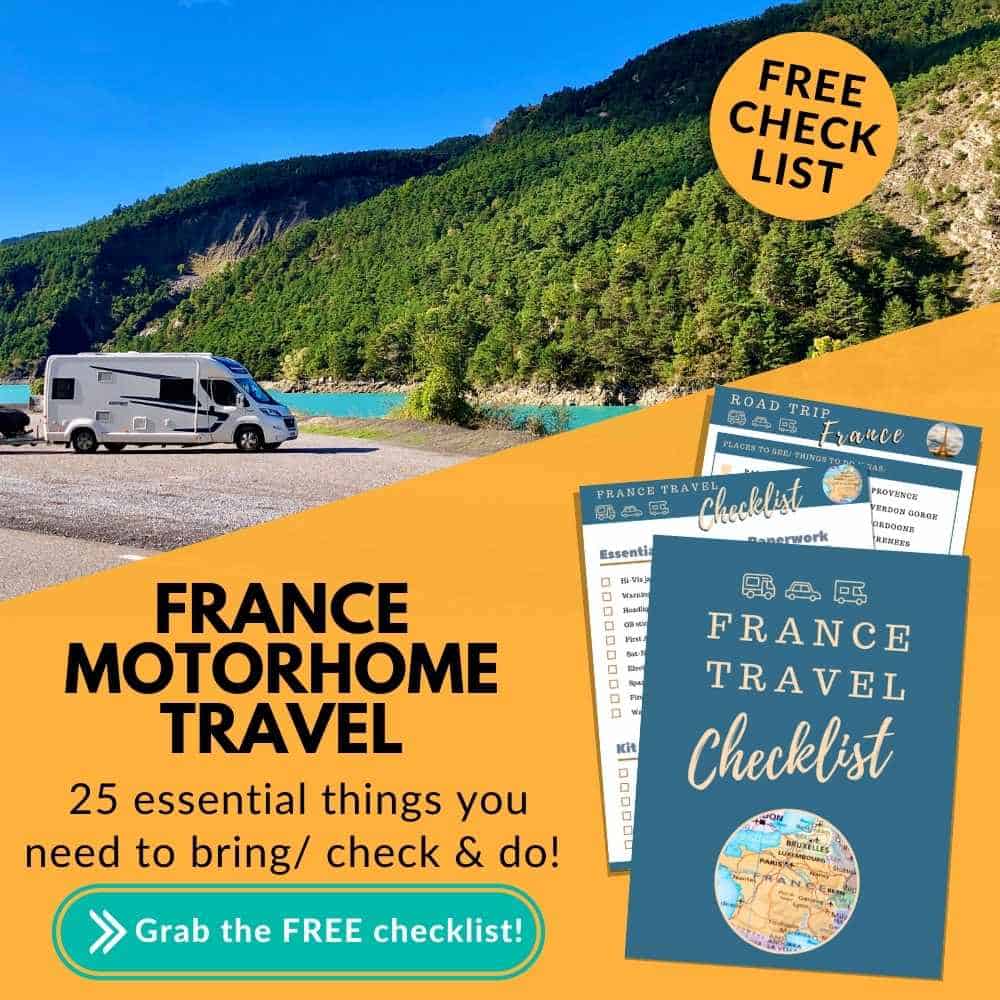
GUIDE – For a step-by-step guide, with video walkthroughs of aires, motorhome set up, checklists and more, grab our France Road Trip & Motorhome Travel Planner
CHECKLIST – Don’t forget to grab your FREE France motorhome travel checklist HERE
GEAR – And if you need any motorhome gear for touring France or Europe, here’s what we recommend.
Things you need to drive in Spain- safety gear
These are the things you MUST have with you when you’re motorhome or campervan touring in Spain.
- Hi-vis reflective jackets – not as strict as in France, but you must wear them on the side of the road or hard shoulder or risk being fined.
- Warning triangle
- Headlight beam converters – must be fitted before you drive in Europe. Some vehicle allow you to adjust the beam automatically so you won’t need these.
- UK sticker attached to the back of vehicle or reg plates (and trailer if you have one)
- A spare wheel (and tools to change it!), or a tyre repair kit.
- If you wear glasses you MUST carry a spare pair!
- If you’re towing with your motorhome or campervan in Spain and the overall train length is 12m or more you must have at least one yellow reflector on the rear, sized 130cm x 25cm (or two sized 50cm x 25cm).
- Red/ white warning board sign – for bike racks or anything overhanging the end of the motorhome or campervan. Lines must point into the middle of the road.
TOP TIP: Buy these essentials for driving in Spain in advance. One of the cheapest places is on Amazon . If you wait until you’re at the ferry/ tunnel, you could spend THREE times as much!

Road trip accessories you MIGHT need when campervanning in Spain
The following kit are things you might need to carry in your car, motorhome, caravan or campervan, depending on when you are planning your road trip in Spain.
- If you are travelling between 15 October and 15 April and driving near the mountains, you will need to have winter/ all- season tyres and carry snow chains. Make sure you check them in advance! If you’re not sure, read THIS
- First aid kit – not compulsory in Spain (unlike many countries in Europe) but worth carrying. Find out what we carry in our European first aid kit here
- Spare bulbs for all lights in the vehicle
- Fire extinguisher
- Road Trip snacks and water- just in case!
Motorhomes or campers with a total train length of over 12m
If you’re travelling in Spain and your outfit exceeds 12m, you need to have marker boards fitted to the back of your vehicle. You can either have two small boards or one large board but they must be placed at the back of the outfit between 50cm and 150cm off the ground.
Your marker board must:
- be yellow in the centre with a red outline
- be made out of aluminium
- be manufactured to ECE70 standard
What documents do you need to drive in Spain?
If you’re driving in Spain, you need to carry the following documents:
- Passport (or identity card)
- Driving licence (check it is in date!)
- Motorhome Insurance documents- check you are covered for driving in Europe
- Breakdown cover
- Vehicle V5 logbook (which must show your correct address)
- Vehicle must be legally taxed and MOT’d
- Trailer certification
- International Driving Permit if required
- Personal travel insurance
Do I need a green card to drive in Spain?
Most UK vehicles do not need a green card to drive in Spain. You may need one if you are towing a trailer- please check with your insurer to be safe.
Do I need an international driving permit to drive in Spain?
Most UK citizens do not need an IDP to drive in Spain, as long as you have a card driving licence issued in the UK (in date, of course!)
You might need one if you have:
- a paper driving licence only
- a licence issued in Gibraltar, Guernsey, Jersey or the Isle of Man
(If you do need an IDP, here’s an in-depth guide on how to get an International Driving Permit and which one(s) you need from a UK post office.
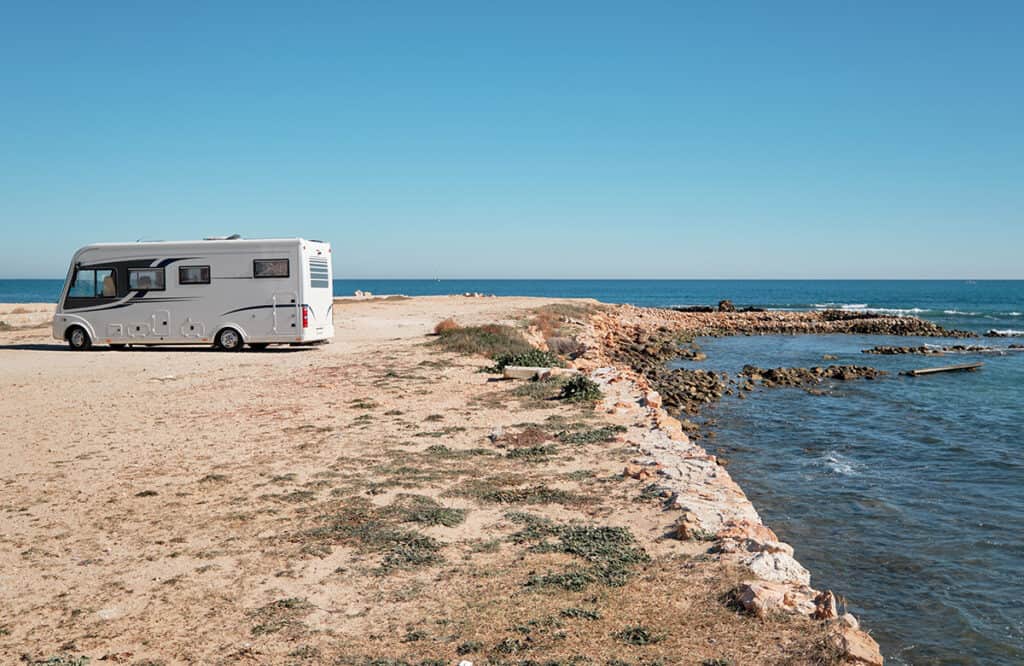
Motorhome touring in Spain- Other useful things you might need
We’ve been touring Europe in our motorhome for several years. We’ve tried all sorts of kit- some useful, some not so much.
Here is a list of things we highly recommend when motorhoming in Spain, but which are NOT essential:
- Motorhome WiFi – learn our favourite way to get internet on the road
- Toll pass (see below)
- TV- If you’d like TV in your motorhome or camper , here’s how to get it.
- Motorhome sat-nav – get one you can enter your motorhome dimensions into, like these
- Motorhome security camera – this thing is GOLD for allowing us to go exploring and leave the van for a short time.
- Solar panel- perfect if you want to wild camp in Spain with your motorhome
- Inverter- a motorhome wild camping essential
- An awesome motorhoming logbook to record and remember your adventures!
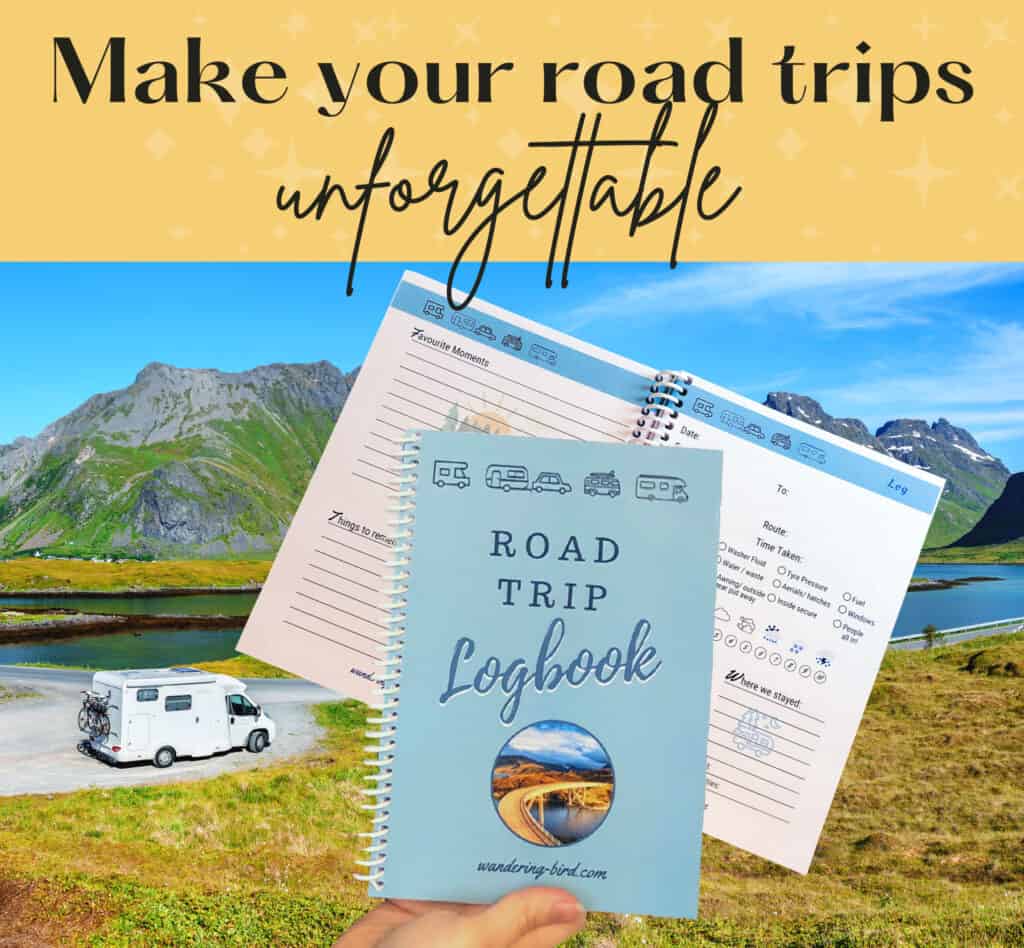
Driving tips for Spain
Ok, let’s deal with the basic rules and some tips for motorhoming and road tripping in Spain:
- Spain drives on the right
- Seatbelts are compulsory
- Driving in flip-flops or open-backed shoes is illegal
- Speeds are in km/h, not mph (you might want to change the setting on your sat-nav)
- You cannot touch a screen while driving (television, video, DVD etc.) This also includes a motorhome sat-nav- program it before you leave and don’t touch it unless you’re parked up safely.
- You need lights on in the tunnels (there are signs to remind you)
- Road surfaces are generally pretty good and, unlike France, they try to avoid 10,0000000 road works on a bank holiday weekend.
- On hills, use the crawler lanes to get out of the way of faster-moving traffic.
- Avoid cities if you’re driving in a motorhome- many of them are too crowded and the streets are just not cut out for large vehicles. Park outside and use public transport to get in.
- Yellow diamond signs mean you have priority. Diamonds with a black line through mean you no longer have priority ( this is usually on roundabouts.)
- Trams always have priority everywhere- keep eyes in the back of your head if you’re driving near a tram network.
- If you are driving in the mountains, you MUST sound your horn before a blind bend, but it’s illegal to use a horn in built-up areas.
- You may carry a load, such as bikes on a rack, extending by up to 10% of the length of the vehicle to the rear. The load must be indicated by a board/ panel with diagonal red and white stripes
- The use of winter tyres in Spain is regional. Look out for traffic signs indicating that winter tyres or snow chains are compulsory where you are.
- IMPORTANT: Drivers do NOT have to stop at a zebra crossing for pedestrians IF there are no lights. So don’t walk out into the road thinking traffic will stop for you.
- Some places have flashing amber lights before a normal traffic light. If you are travelling at or below the speed limit, the red traffic light will change in your favour. If not, the light will remain on red to slow you down!
- In some places, to turn left across a dual carriageway you need to pull-in on the right and wait until it is clear in both directions.
- If you are overtaking a cyclist or a group of cyclists, you must leave at least 1.5m of clearance, and also reduce speed by 20kmh (WHY Spain, WHY?) You are allowed to cross a white line to overtake a cyclist AS LONG AS nothing (not even another cyclist) is coming the other way.
Roads in Spain
The Spanish road network is pretty good and has a mixture of paid and free roads.
- ‘Peaje’ or ‘AP’ is a toll road. Autopistas are marked red on the map and they will have the letter ‘P’ next to the number
- Toll-free motorways are marked with the letter ‘A’ and are marked blue on the map
- Main routes /dual carriageways (green on the map)
- An “autovía” is like a motorway, except that bicycles and agricultural vehicles can use it.
Restricted driving days in Spain
Spain has certain days when driving is restricted. You can find out more about them here
Restricted Zones in Spain
Some of the bigger cities in Spain have environmental zones which only residents are allowed to drive in. These zones are indicated with ‘Area de prioridad residencial‘ and are banned to anyone without a permit (or special exemption.)
Toll roads in Spain
If you choose to use the Autopista toll roads while motorhoming in Spain, here are some tips for you:
- The weight of your motorhome no longer matters- all motorhomes are charged the same.
- Just like other tolls in Europe, you’ll usually get a ticket when you enter the toll route, then have to pay when you exit at either a manned or automatic toll booth. Occasionally, some sections of road have a fixed fee, so you pay when you enter.
- Tolls can be paid for in cash (Euros) or cards at selected booths. American Express is rarely accepted but UK credit or debit cards should work (but not always, so carry cash to be safe!)
- Alternatively, get a toll pass/ payment tag so you can use the ‘Telepeaje’, ‘VIA-T’ or ‘T’ lanes. We use e-Movis and it’s well worth it- especially on busy days where you can drive right on by the queues.
Bizarrely, some toll roads in Spain are being ‘demoted’ to free routes, but are still marked as AP on the map. This site has more information about tolls in Spain and what you might expect to pay on the various Autopistas.
Speed Limits in Spain (unless otherwise signed!)
Cars and vehicles under 3.5 tonnes:
- 120 km/h (74mph) on motorways/ autovias and many dual carriageways
- 90 km/h (56 mph) on secondary roads (out of town)- can increase to 110km/h to overtake
- 50km/h (31 mph)- on roads with two or more lanes in the same direction
- 30 km/h (19 mph) on roads with one lane in each direction
- 20km/h on small lanes where road & pavement are the same level
Motorhomes and Campervans weighing over 3.5 tonnes:
- motorways 90 km/h (55 mph)
- major out-of-town roads 80 km/h (50 mph)
- minor out-of-town roads 70 km/h (43 mph)
- urban areas- 50 km/h (31 mph)
- 25km/h in signposted residential zones
Motorhomes with trailers or caravans (over 750kg)
- motorways 80 km/h (50 mph)
- minor out-of-town roads 70 km/h (44 mph)
- built-up areas- 50 km/h (31 mph)
Speed Cameras in Spain
Many roads have automatic speed cameras on in Spain and they’re quite happy to send tourists a fine through the mail.
You might also find random traffic lights, which turn to red in the middle of nowhere if you’re speeding and make you wait for a couple of minutes before turning to green so you can move off again. These are surprisingly effective!
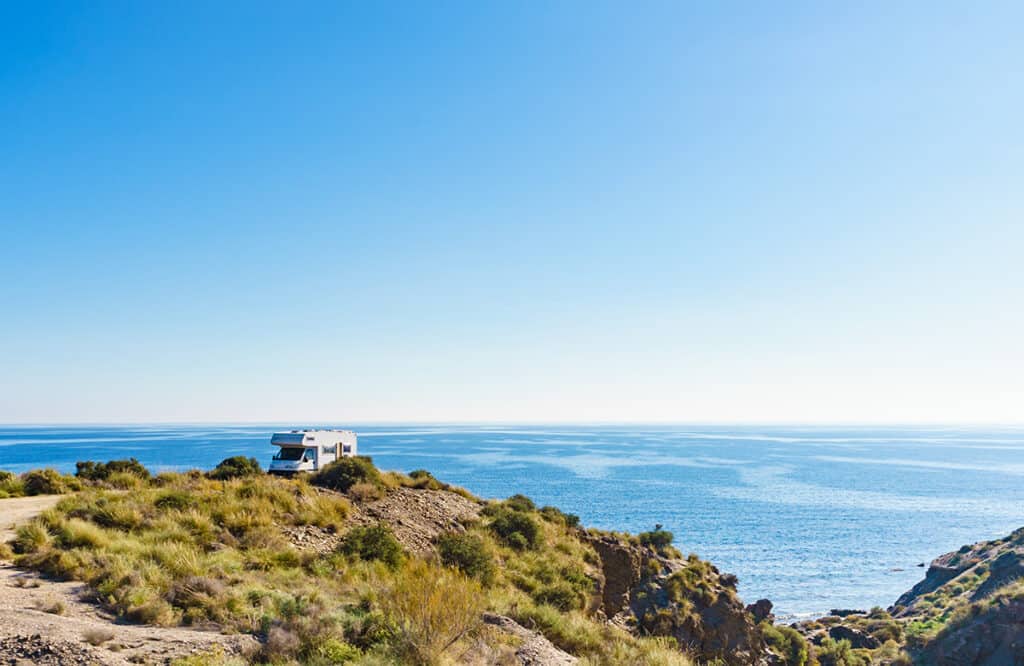
Driving in Spain- what to do in the event of a road traffic accident
You should have a European Claim Form provided by your insurer before you leave. In the event of an accident, all parties complete and sign the form at the scene and then send a copy to your insurer for assessment.
What to do at the scene:
- Stop your vehicle immediately but safely- out of the flow of traffic if possible.
- If a vehicle is blocking the road, use hazard lights and put the red warning triangle 30 metres from the scene to warn approaching traffic
- Name and address of all the people involved in the accident
- Vehicle registration numbers of all parties
- Insurance company details of all parties
- Take photos of damage using a camera, GoPro or phone
For more details, read our step-by-step guide on dealing with a road traffic accident in Europe
Other essential tips for campervanning in Spain
Petrol and diesel.
Petrol and diesel are widely available. Many fuel stations are 24h on the main roads and are self-service with card machines.
If you have refillable gas bottles in your motorhome, you can find LPG pretty easily while touring around Spain. Spain uses the Euroconnector adapter.
NOTE: Gas bottles can be tough to get- and it’s forbidden to fill foreign gas cylinders. Don’t forget you will need to bring a different nozzle to connect the Spanish gas bottle fitting to your UK system. If you’re not sure what we mean, read more about getting gas in Europe:
READ MORE: How we find motorhome LPG or bottles while touring Europe
Motorhome Service Points in Spain
You will find some petrol stations with additional facilities for motorhomes, like waste disposal, water (NOT always drinkable!) and washdown areas.
Campervanning in Spain- security
We highly recommend paying extra attention to your motorhome security when travelling in Spain.
You might even wish to fit an extra camper habitation door lock and never leave your vehicle unattended in an unsecure area.
Touring Spain with a dog
Spain surprised us with their attitude towards dogs. They’re not often allowed on public transport, even with a muzzle, which made visiting places difficult. (PLEASE do not leave a pet in a van or car while you go sightseeing, especially on a hot day.)
Now that BREXIT has happened and the UK pet passport scheme is no longer valid, you will need to get an Animal Health Certificate before you leave the UK.
READ MORE: How to get a UK Animal Health Certificate after BREXIT
You will need to get a worming treatment done by a registered vet before you leave Spain, or between 24 hours and 5 days before re-entering the UK. Sandflies, fleas and ticks are common in Spain, so get a collar or treatment which protects against these.
More tips for travelling with a dog:
- The most useful dog road trip accessories
- How to keep a dog cool while travelling
See all our dog travel and road trip tips
More useful things to know when motorhoming in Spain
Emergency Numbers: 112 will get you everything
Language – There are several local variations of Spanish. Castilian is most common, but there is also Basque, Catalan and some smaller dialects. English usually spoken in campsites and in tourist areas, but not often elsewhere
Currency – Euro
Cards – most major credit and debit cards are accepted. American Express is only taken in large stores (not at tolls and often not at fuel stations)
Timezone – GMT+1 (or one hour ahead in BST)
Mobile Phone and Internet – It’s usually possible to use your UK phone and data in Spain, but do check with your provider about any charges you might incur. Alternatively, 1p Mobile SIM cards are widely available and a cheap option for phone calls.
Tipping – Service is usually included in a restaurant, but do check. It’s common to tip other services, like taxi drivers
Shops – Food prices are pretty inexpensive. Many shops close on Sundays. Bigger supermarkets may be open, but will close at lunchtime. If bakeries open on Sundays, they are often closed on Mondays instead. Many shops and businesses also shut for a long lunch (between 12-2pm) and some will not open on Wednesday afternoons.
Other posts you might find useful:
- Campervanning in Portugal- everything you need to know
- The best road trips in France
- Unmissable road trip ideas for Europe
- Essential motorhome checks to do before you travel
See all our Europe travel tips and ideas
DISCLAIMER: This post was last updated in October 2021. We try to keep it as up to date as possible, but cannot be held responsible for any changes made to the law since the last update. If you do find any discrepancies, please do let us know. Thanks.
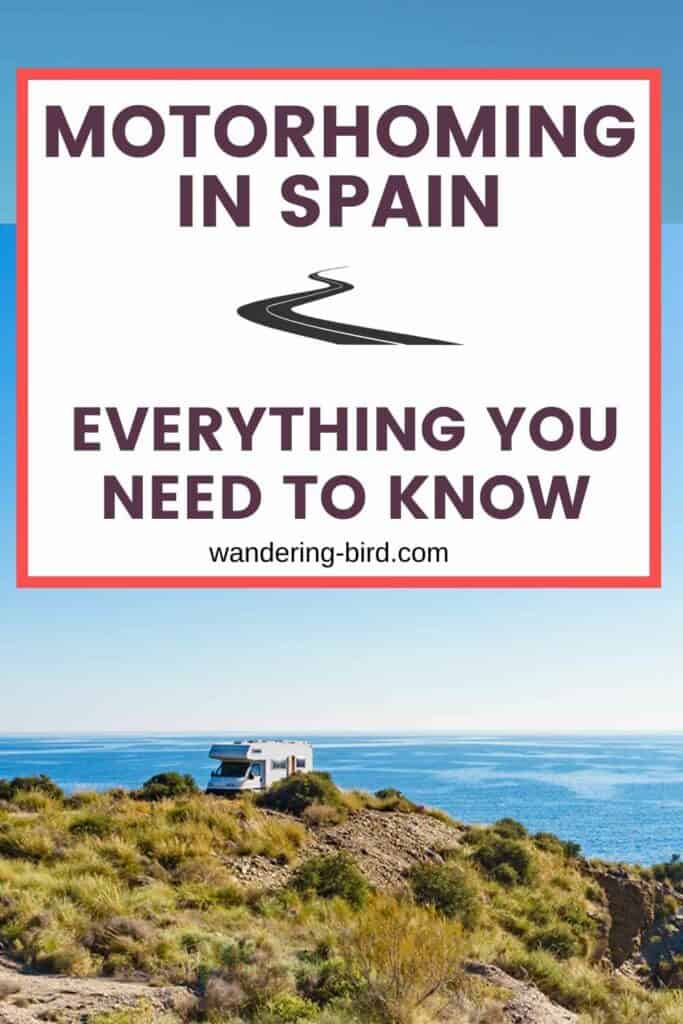
Kat never planned to buy a motorhome. She also never planned to quit her job as an air traffic controller, go touring around Europe in said motorhome, start one of the UK’s largest motorhome travel websites… or get a cocker spaniel.
Find out how she went from stuck in the rat race to being a digital nomad and inspiring thousands of people to have their own epic adventures here.
If you’d like to connect with Kat, send her an email or follow her adventures on social media.
Last update on 2024-09-19 / Affiliate links / Images from Amazon Product Advertising API
Sharing is caring!
Similar Posts
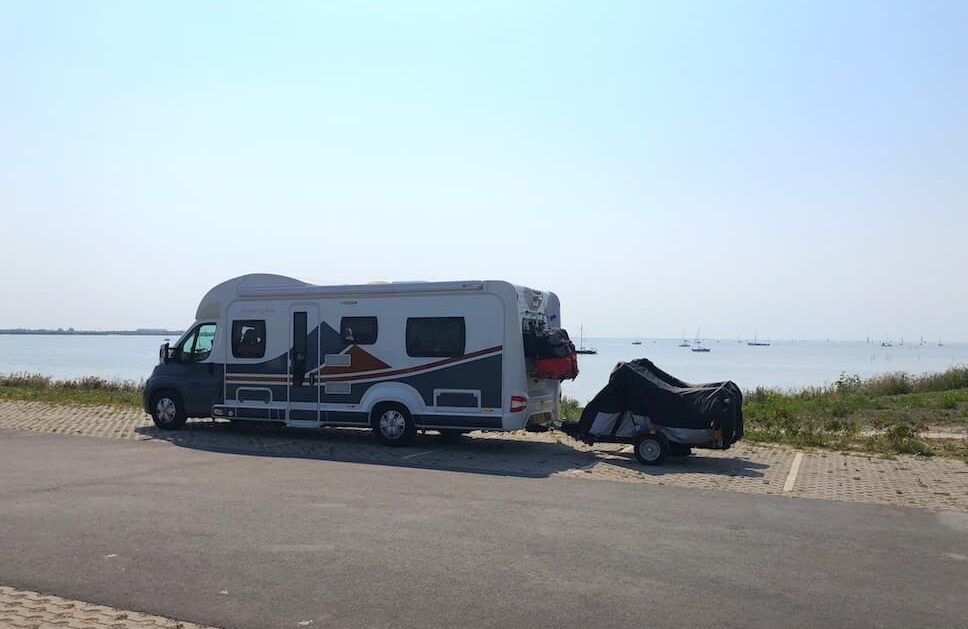
Motorhoming & Campervanning in the Netherlands- The Ultimate Guide
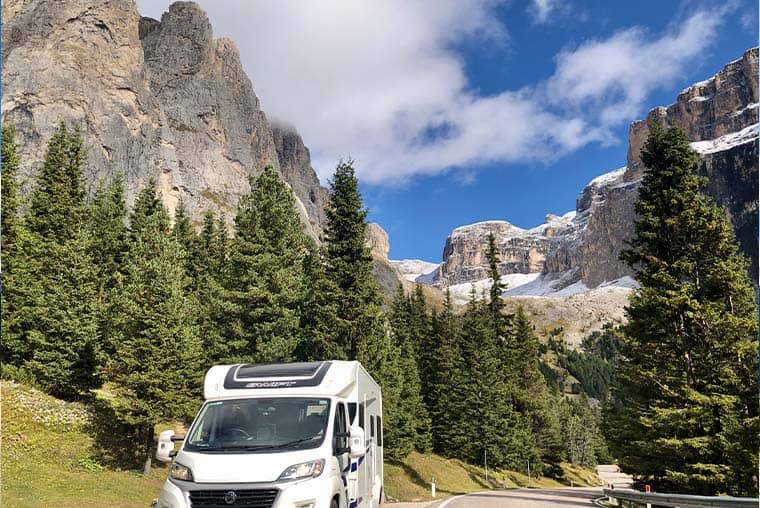
How to Find LPG in Europe (or Gas Bottles)
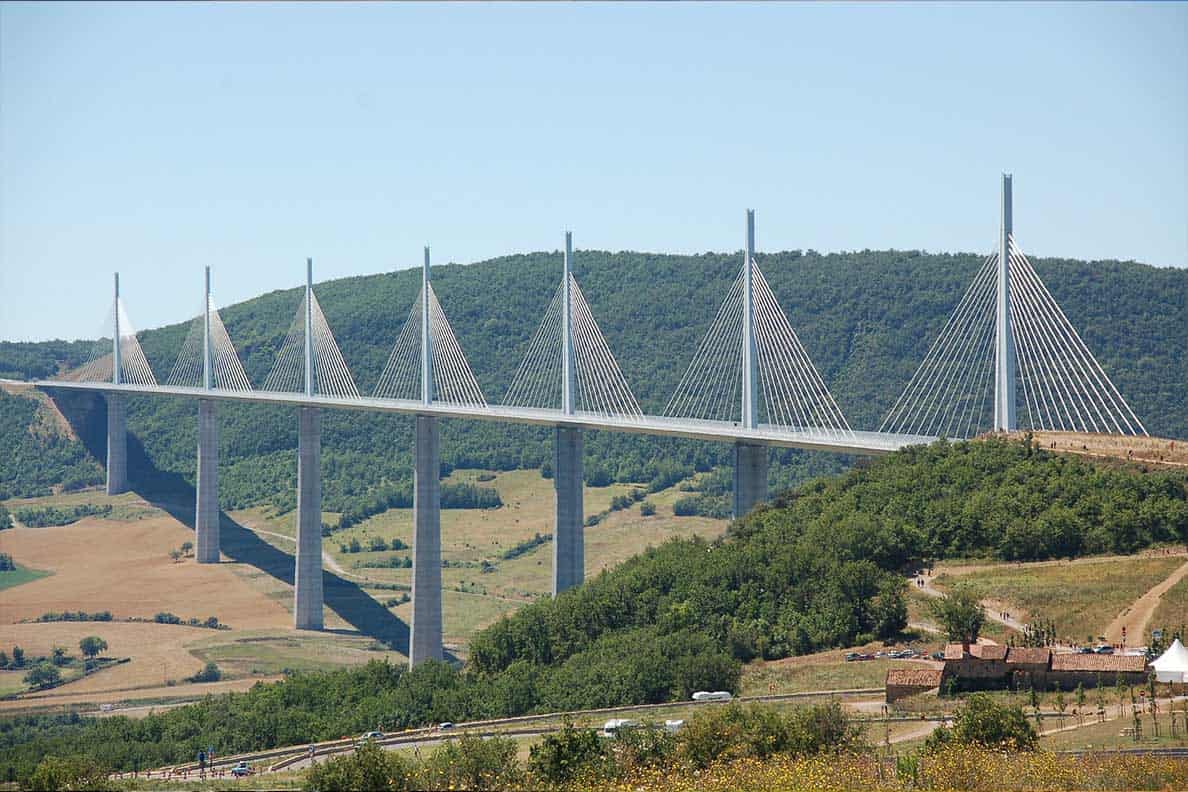
Crossing the Millau Viaduct in a Motorhome
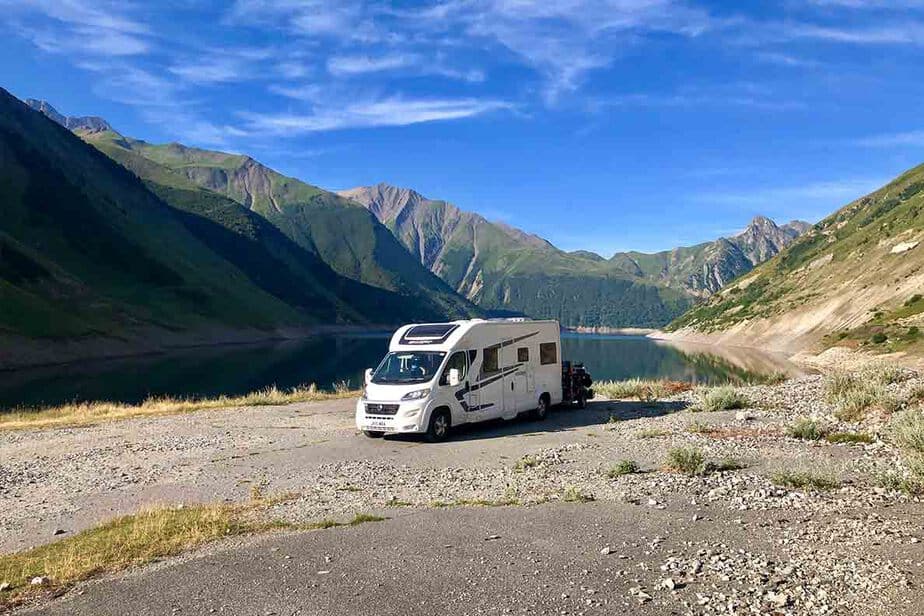
Wild camping in France for motorhomes and campers
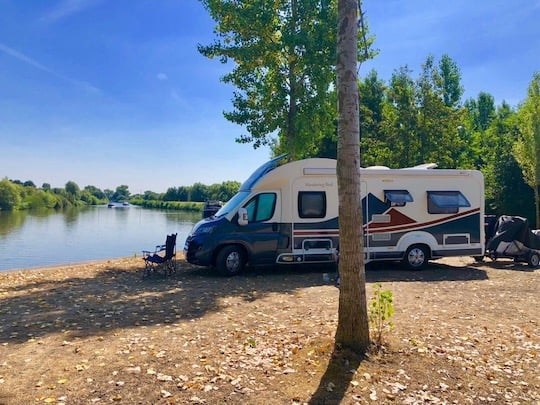
Is Motorhome Wild Camping in Belgium legal?
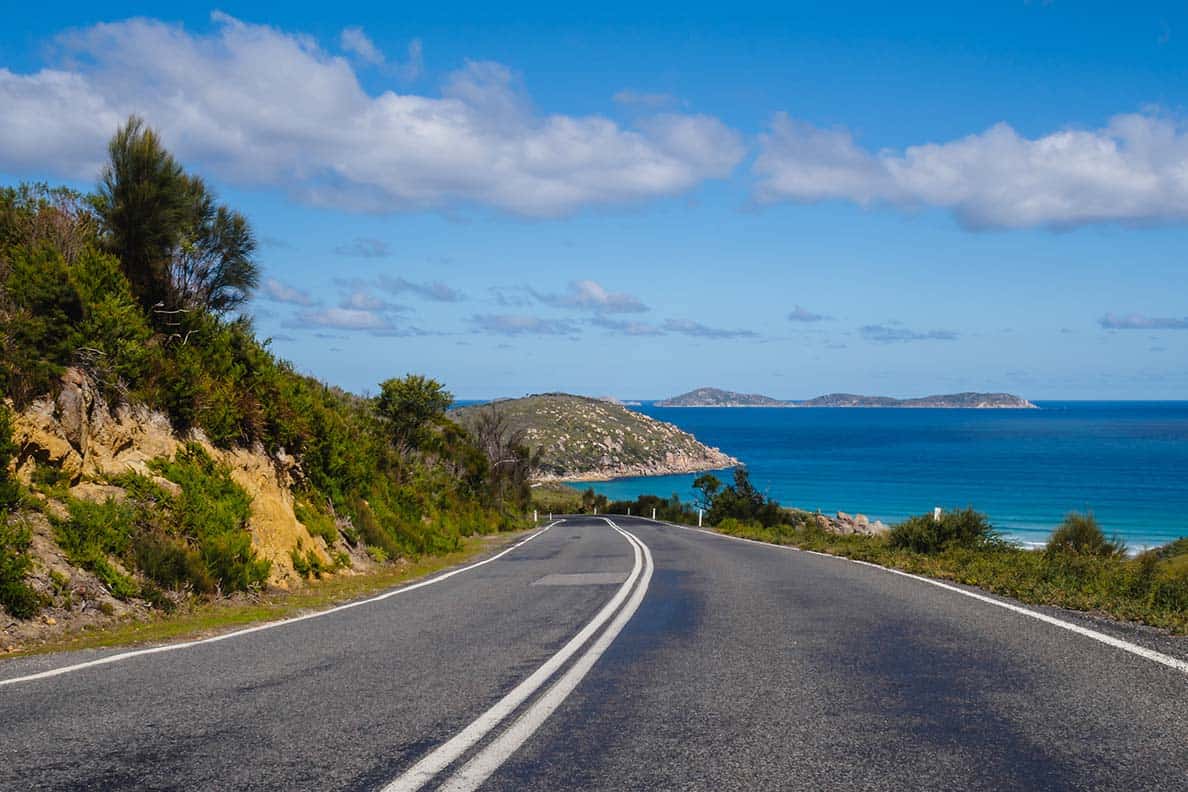
Left hand drive vs Right hand drive – which is better for Europe road trips?
Leave a reply cancel reply.
Your email address will not be published. Required fields are marked *
Save my name, email, and website in this browser for the next time I comment.
- Travel guides
- Inspiration

The best motorhome routes in Spain
Discover spain by motorhome or campervan.
Spain has a lot to offer to campervans. Surrounded by coast in the north and south, Spain has a very varied landscape where impressive mountain ranges alternate with beautiful beaches, large plains, authentic villages and beautiful cities. Whether you go deep into the south, drive through temperamental Andalusia or explore green Galicia, Spain will always surprise you.
Below we have selected the most beautiful campervan routes through Spain, which you can use as inspiration for your next campervan trip.
3 beautiful motorhome routes in Spain
Flamenco, bullfighting, Andalusian horses and tapas describe Andalusia in a few words, but the region is much more than that. This motorhome trip takes you to authentic white villages, challenging mountain landscapes, historic cities where Moorish and Catholic influences are interwoven and beautiful natural parks that provide a nice variety. Our road trip starts in Granada and ends in Cordoba.
Catalonia is more than just the bustling city of Barcelona. With this motorhome trip you discover the beautiful, varied nature of the four provinces that together form the independent region of Catalonia. From golden sandy beaches and wild coasts of the Costa Brava and the Costa Daurada, along coastal cities to the fertile plains of Lleida and the Spanish Pyrenees. This road trip is not limited to the popular coastal region, but also explores the beautiful inland.
Located in the far northwest of Spain, Galicia is a paradise for hikers, nature lovers and surfers. Its mild and rainy climate makes it noticeably greener than the rest of Spain (don't forget your mackintosh!) and in summer you won't have to deal with heat waves. This motorhome trip starts in Vigo and takes you along the coastline to beach at Praia Das Catedrais. You'll drive through hilly green landscapes, past romantic vineyards, beautiful bays and bustling towns on the Atlantic coast.
General terms & conditions

Home > Road trip in Spain in a converted van
ROAD-TRIP IN SPAIN in VAN AMENAGE
Our itineraries, tips and testimonials for a road trip in spain and andalusia in a van aménagé, almeria – cabo de gata natural park.
Tabernas is a village in Almería, Andalusia. It is built around an Arab fortress overlooking an arid landscape of palm trees, agaves, prickly pears and cacti.
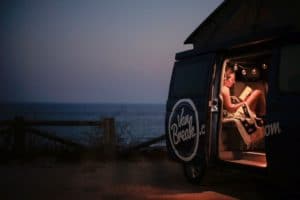
7-day road trip to Spain? Marie and Erika set off in a van…
Erika and I are Parisians by birth and adoption. We love to roam. We’ve each traveled several continents. We’ve already traveled together, in France, Brittany and Corsica. This time, the trip takes us a little further afield, to the southern tip of Europe, a few kilometers from Africa, to Tarifa and Gibraltar.
Digital Nomad in a converted van: testimonial
Life wouldn’t be exciting without the moments that mark us, move us, thrill us, make us laugh or cry. It’s these moments that ultimately make up our lives, because in truth, we don’t remember people but rather moments spent with them, we don’t remember places, but moments spent in those places. For some people, these…
Skiing in a converted van in Spain (Sierra Nevada)
The Sierra Nevada is a Spanish ski resort just a 2-hour drive from Malaga, located high above the city of Granada in Andalusia. Its highest point is Mount Mulhacén at 3,479m, the highest peak on the Iberian Peninsula.
Discover Andalusia with Les Amoureux de l’Andalousie
Andalusia Lovers share their Andalusian discoveries, experiences and tips on breathtaking excursions!
Roadtrip to Morocco in a converted van with Kendy & Alex
Roadtrip to Morocco in a converted van with Kendy & Alex Here are the experiences of two VanBreakers, Kendy and Alex (34 and 36) from Montpellier, who went on a roadtrip in a converted van in Morocco during November 2023, and share their experiences and advice with you. They chose to rent the Volkswagen California…
Gastronomic roadtrip in a campervan in spain and portugal
Let yourself be tempted by these must-sees and must-do’s during your road trip to Andalusia in a converted van. A successful gastronomic trip guaranteed!
Road trip in Morocco in Campervan
Morocco is a country to visit by van in winter, discover all our tips for a successful roadtrip in Morocco.
TOP 10 things to see and do in Andalucia in campervan
TOP 10 things to see and do in Andalucia in campervan What to see? What to do? Where to sleep? These questions that you ask yourself before leaving for a trip, especially a roadtrip in a converted van. To simplify your life, Vanbreak has gathered for you the TOP 10 things to do and see…
Ski vacations in a converted van – The essentials
Off on an adventure in a ski van? Before you leave, it’s a good idea to prepare your trip so you don’t forget anything. Here’s our advice on how to make the most of your ski van vacation without missing out on comfort!
Checklist for planning your trip in a converted van
Off on an adventure in a converted van? Before you leave, it’s a good idea to prepare your trip so you don’t forget anything. Here’s a non-exhaustive checklist of essentials to make sure you don’t miss a thing during your van trip!
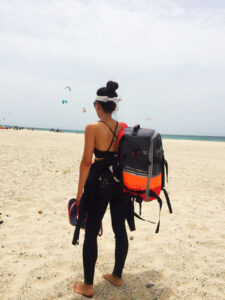
Kite trip in a campervan in Tarifa – Erti’s testimony
Discover the experience of Erti and her adventurous kite trip in Tarifa in a campervan. Our Vanbreaker has gone for 2 weeks in a VW California T6 – Ocean. From our agency in Malaga, she headed towards the direction of the province of Cadiz: destination Tarifa! There, she did her kite surfing courses with our…
What to see in the Province of Malaga? The 10 most beautiful places to visit
In this article we give you all the information you need about your road trip by camper van or camping car . What to see in Malaga Province? What to visit ? Where to sleep? everything! Prepare your bag and just choose one of our VW campervans or City Car burstner motorhomes for your vacation…
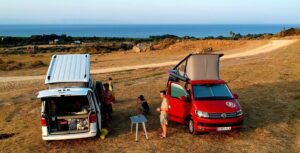
10 reasons for a perfect campervan trip after confinement (COVID-19)
1 – TRAVEL SAFELY At VanBreak, we are concerned about the safety and well-being of our clients, and even more in the current conditions that surround us with the coronavirus crisis in Spain. Therefore, we have taken a series of security measures to guarantee you a safe road trip in a campervan after confinement and,…
Road trip around Madrid : visit of Toledo and Segovia (5 days)
I love to try new things while travelling, and get off the beaten path. I’ve never been a fan of camping though, so I tended to avoid anything that related to that. But last year I came across VanBreak Malaga and we decided to try out their VW California Ocean van while we explored the…
Between the Mediterranean Sea, the Atlantic Ocean and the Sierra Nevada, discover the wonders of Andalusian culture on a road-trip in Spain. Explore the region in your camper van, from Cordoba to Seville, via Tarifa, Cadiz, Granada, Malaga, Marbella, Cabo de Gata, Ronda and Nerja… The Costa del Sol is an ideal destination , whatever the season!
Stop off at the best bars, typical restaurants and “chiringuitos” for tapas, grilled fish, local produce or traditional paella accompanied by Sangria or Andalusian wine. Find out how to get started in the region’s sports: kitesurfing, kayaking, surfing, hiking, mountain biking, etc. Explore the magnificent landscapes of southern Spain You’ll find the most beautiful sandy beaches, typical white villages (pueblos blancos), Granada’s Alhambra and other architectural marvels, authentic squares and narrow streets… Finally, immerse yourself in the heart of Spanish culture: flamenco, museums (Malaga is Picasso’s birthplace!), cathedrals and festive nightlife are all on offer!
Depending on the length of your stay (we recommend 10 days), plan your cultural visits, sporting activities, places to sleep… Ready for an unforgettable road-trip in a converted van or camper van in Spain? follow our travel guide!
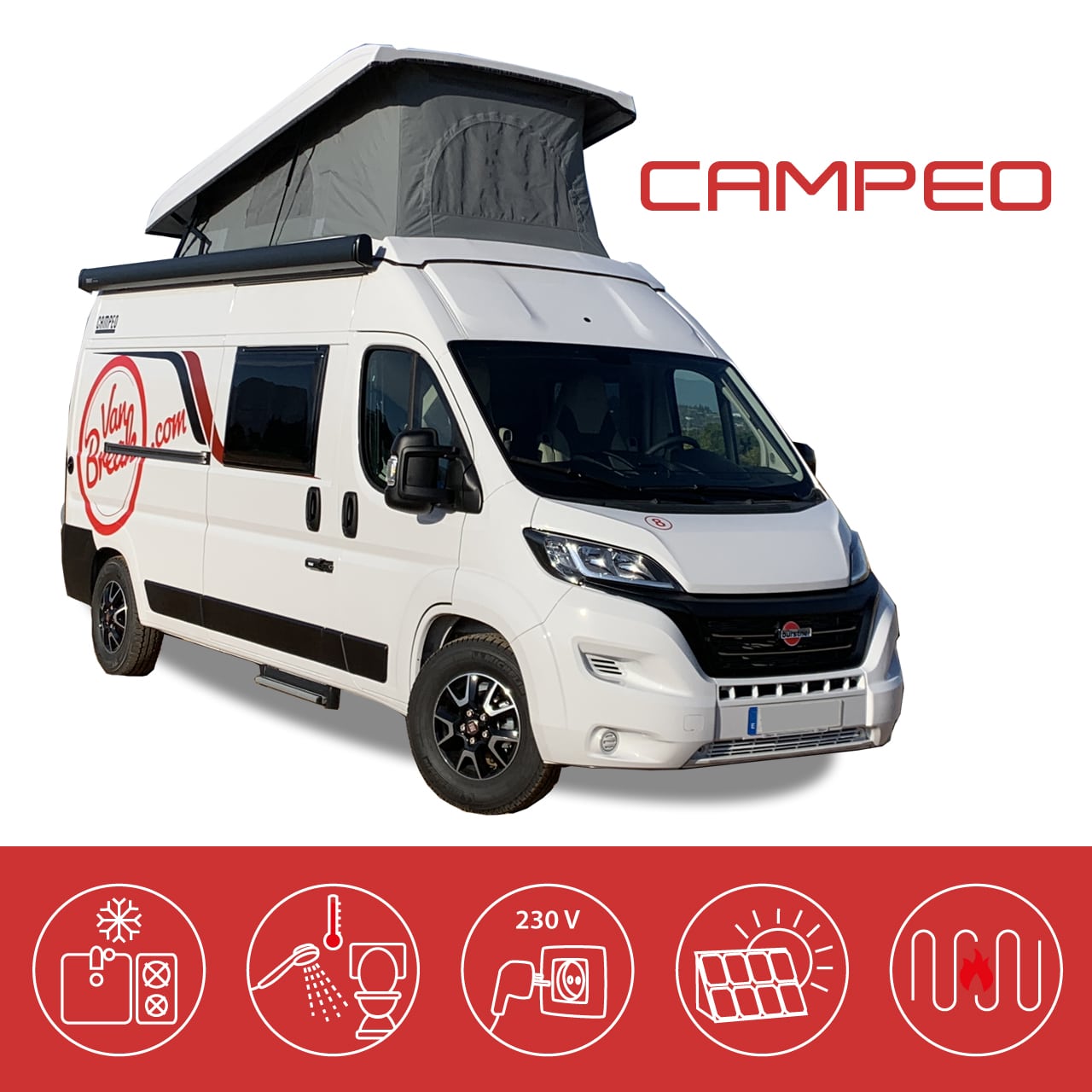
TRY A ROAD-TRIP IN A CONVERTED VAN
Unusual vacations in spain.
Are you an enthusiast of #vanlife holidays or keen to discover the road-trip concept? Vanbreak offers you high-quality converted vans for vacations with family and friends throughout Spain, and all over Europe. From Malaga, find the van, camper or motorhome to suit your travel needs in Spain (see our vans ) and set off on an extraordinary adventure. Follow your instincts if you’re an adventurer, or follow our itineraries for a well-organized, hassle-free stay. With our travel guides, itineraries and tips , don’t miss out on Andalusia’s most beautiful spots… a change of scenery guaranteed!
ROAD TRIP IN SPAIN: LONG TERM STAY
Are you planning a longer getaway to take the time to discover each region and visit Spain’s must-see cities? We’ll give you an exceptional discount so you can explore the whole country, right up to the north of Spain. For example, you can stop off in the city of Gaudi, the famous architect of the Sagrada Familia, to visit Barcelona and Catalonia. Have you ever travelled the Mediterranean coast and visited the Balearic Islands? Why not cross the hinterland and join the famous Camino de Santiago de Compostela, a UNESCO World Heritage site?
Each area has its own cultural, architectural and gastronomic heritage. Come away with family or friends to discover, marvel, party or simply spend a lazy vacation at the playa … Follow the guide or get off the beaten track: there’s so much to do!
With a camper van rental, you’re free to move around and travel at your own pace , for an extraordinary, tailor-made holiday in Spain.
A Motorhome Trip Through Northern Spain: Route, Budget & Tips
Just back from a month-long motorhome trip throughout northern Spain , I’m beyond excited to share all the juicy details of this epic adventure and insider tips for you to make it happen.
Picture this: cruising down charming country roads, discovering hidden gems, and soaking in the awe-inspiring beauty of dozens of stunning destinations. From picturesque towns to jaw-dropping natural wonders, this guide has got it all.
Let’s dive right in and unlock the secrets of RV travel and road-tripping this remarkable region together, shall we? Adventure awaits!
A bit of context to get started

Koala, our Ford Transit motorhome
For those of you who are new here, I bought a vintage motorhome when Asia was three months old. The main motivation behind this bold move was to enjoy as much time with our little bundle of joy when she was little, without breaking the bank. But the truth is we’d wanted to do so for a long time and it felt like it finally was the right time.

Jose, our baby daughter Asia, and myself on board Koala
Koala – a trusty Ford Transit, model Koala – was not cheap (van life bubble is underway y’all!), considering it’s an RV in its mid-30s but it did not feel like money wasted. On the contrary, a year and a half later I can say it was the best thing I did in 2022 after having a child.

Endless choice of backyard is one of the main perks of traveling by motorhome
Since then, lots of short trips and a few longer ones followed. Today, I want to tell you about the last semi-long one. It began right after Autumn officially started in the Northern Hemisphere and ended 29 days later.
The road trip route: Our experience

Stunning vistas of Picos de Europa and Palentina mountains as we continued our trip East towards the Pyrenees
Where did the road take us this time?
Starting on the Western Galician coast, we pretty much hopped our way to the Catalonian Pyrenees from natural park to natural park during the first 3 weeks.

The exact itinerary we followed on this four-week journey across Northern Spain in our trusty vintage motorhome
The weather forecast was simply exceptional (nothing to be very happy about, as I believe climate change has lots to do with the high temperatures and drought South West Europe experienced in early Fall this year) and so we abandoned our Mediterranean plans and headed to the Pyrenees instead.

Waking up next to awesome spots like this one is possible when you get to choose where to park your motorhome every night
The last week came with heavy rain and strong winds. It was spent heading back with a few detours here and there to visit friends and family, some more nature parks and preserved spots, stopping in some cities we’d usually skip to favor greener areas, and overall following a newer route.
4 Weeks road trip itinerary through Spain’s Northern half
Traversing castille and leon: bierzo, riaño and montaña palentina.
Embarked on an unforgettable road trip, we started our adventure in the charming town of Noia, our base.

Mother and daughter in a Villafranca del Bierzo street spot
From there, we drove to Villafranca del Bierzo and immersed ourselves in its medieval architecture and enchanting cobblestone streets before our first night on the road.

Our baby coming out of the Faedo de Ciñera forest
Continuing our journey, we headed to the mighty Faedo de Ciñera .

A tiny birdhouse hangs from a Faedo de Ciñera tree
Next, we made our way to the serene Porma reservoir (embalse del Porma, Boñar), where we enjoyed the traditional early Autumn deer bellowing and overall basked in the tranquility of the beautiful lake at night without any other company.

The Porma reservoir at night
What a time to be alive!

Admiring embalse del Porma from one of the lookout points, next to where we spent the night
The road led us to the picturesque village of Riaño , nestled amidst the breathtaking Picos de Europa mountains.

Mountains of Leon with the Picos de Europa in the background as seen from the Riaño reservoir
We marveled at the awe-inspiring alpine landscapes and indulged in an Instagram-worthy photoshoot.

Asia exploring Riaño on foot
Driving through the stunning countryside, we reached Camporredondo de Alba , where we embraced the beauty of the natural surroundings and stayed overnight.
Continuing onwards, we arrived at the charming town of Cervera de Pisuerga , surrounded by rugged mountains.
Exploring Las Tuerces , we were captivated by the surreal limestone formations that left a lasting impression. Our journey then took us to Las Loras geopark near Aguilar de Campoo, where we ventured into the magnificent Cueva De Los Franceses , marveling at its stalactites and stalagmites.
We enjoyed panoramic views from the Mirador de Valdecabado and explored Espacio Natural Covalagua , with its fascinating rock formations, diverse flora and fauna, and – sadly dry – waterfall.

Sunset views from Covalagua parking lot
The village of La Población was our base that night.

Wandering around Rioseco Abbey ruins
Continuing on, we wandered around Rioseco Abbey ruins before heading to the majestic Cascada el Peñón .

Peñon waterfall was an unmissable stop!
After a dip under its stunning waterfall, we entered the Montes Obarenes-San Zadornil nature reserve, which has incredible landscapes and hiking trails.

Frias and its impressive castle at dusk
Frías , a medieval village perched on a hill, fascinated us with its castle and winding streets. Its riverside was the perfect backyard for that night.

The Medieval bridge of Frias over the Ebro river at sunrise
Dwelling in the Basque Country: Gorbeia, Garaio, and Aizkorri-Aratz Natural Parks
Continuing our journey, we explored the Monte Santiago Karst route to the massive Salto del Río Nervión and Gorbeia Natural Park .

Salto del Nervion is a 222m plunging waterfall – the highest in the Iberian Peninsula – reached by a flat 2 or 3km walk to this lookout point
Afterward, we arrived in Vitoria-Gasteiz. The city greeted us with its vibrant atmosphere, beautiful parks, historic buildings, and a funky Middle Ages-themed feast across the old town.
Oh hello Vitoria Gasteiz!
After a quiet night next to Garaio , we went for an al fresco lunch at Saldropo before checking out Otzarreta forest .

Otzarreta Forest has a few interesting trails through a landscape of marshes, meadows & rugged hills, with centuries-old beech & oak trees. A must
Salvatierra/ Agurain welcomed us with music in the streets but we skipped a good night’s party for our beauty sleep at La Leze .

Can you spot us? Welcome to La Leze cave!
The next day, after checking its stunning cave, we indulged in a barbecue before heading to the Millenary oak forest ( SL-NA 137 – Sendero de los Robles Milenarios ) and spending the night in Etxarri Aranatz .

The Path of the Ancient Oaks in Etxarri Aranatz is an easy stroll through a forest of ancient and majestic common and white oak trees
Both offered a picturesque and peaceful ambiance, perfect for relaxation.

Navarre’s Beriain mountain at sunset
Slow traveling through Navarre and the Irati Forest
We then set off on our road trip to Parque Natural Urbasa y Andía , a beautiful park full of nature trails.

Scenic lookout point near Ubaba, in Urbasa.
We enjoyed stunning views from Balcón de Pilatos/Mirador de Ubaba and stopped at Artavia/ Artabia ’s bridge for a refreshing dip.

Swimming spot in the Urederra River as it passes through Artavia, Navarre, Spain.
In Estella- Lizarra , we marveled at its rich history and architectural beauty.

Our one-year-old baby daughter having fun at the cloister of the Monastery of Iranzu in Navarre, Spain.
Iranzu Monastery and Santa María de Eunate Chapel captivated us with their intriguing stories and unique structures.

Saint Mary of Eunate is a 12th-century Romanesque church along the Way of Saint James in Navarre, Spain.

The Gothic Pamplona cathedral replaced a Romanesque church.
Before heading to wilder destinations, the city of Pamplona embraced us with its vibrant energy and renowned pintxos scene.

Ochagavía is a town in the Salazar Valley, near the Irati Forest and the French border.
Driving through Ochagavía , we admired its picturesque setting and quaint streets.

Cubo waterfall in Irati forest in Navarra, Spain
Casas De Irati resulted to be the perfect spot to start exploring the majestic Selva de Irati . We went on two forest hikes – one to Cubo waterfall and a 2km circular path.

The Virgen de las Nieves chapel in the forest of Irati in Navarra
Spending a couple of days in the scenic French Pyrenees doorstep
Continuing our journey, we reached the Larrau pass .

Larrau Pass is an unbelievable spot to spend one night, agree?
There, right between the border between France and Spain, we spent a tranquil night along with a few other vans and motorhomes.

Wild horses and the sun over The Pyrenees mountains at sunrise, as seen from Larrau Pass
After stepping into France, the surroundings of Passerelle d’Holzarte, the village of Tardets -Sorholus, and the fantastic ski resort and mountain area of La Pierre Saint Martin fascinated us with their natural beauty and unique attractions.

Spending one night in La Pierre San Martin was also a great idea
Falling for Aragon and Ordesa National Park
The lookout points and refuge of the picturesque Larra-Belagua valley was the last stop before Arrako Bidea, a trek we never got to take because one of our front windows suddenly crashed. That incident, and a couple of other issues, hindered our progress. We thus spent three days in mechanic and repair shops in Huesca and Sabiñanigo .
Mallos de Riglos was a very quick stop on our way there, as we were really trying to get there before Friday evening.

Jaca is full of picturesque spots
Anyway, we explored Sabiñanigo’s surroundings with friends over the weekend, including the lively Jaca , beautiful Balneario de Panticosa , quaint Biescas , and awe-inspiring Orós Bajo waterfall.

Once everything was fixed and our motorway was ready to keep going, we reached Torla-Ordesa .

From there, we visited the stunning Parque Nacional de Ordesa y Monte Perdido on a hike from La Pradera to the Estrecho waterfalls.

We stopped briefly in the charming Valle de Bujaruelo on our way to Bielsa and Valle de Pineta, only to be impressed enough to make plans to return and explore further. The cascading waterfalls and sprawling meadows of La Larri , albeit a challenging steep trek – if you happen to babywear a 15kg toddler even better – were absolutely stunning and worth the effort.
Admiring the Catalonian Pyrenees, Aiguestortes National Park, and Lleida surroundings

Taull as seen from afar
Aínsa showcased its medieval charm and in Boí , we marveled at the renowned Romanesque churches that make up the UNESCO World Heritage site. Caldes de Boí and Taüll provided a peaceful escape with their mountainous surroundings and ancient architecture.
For skiers, El Pla de la Ermita was the perfect spot to spend a night, with a motorhome parking lot at the doorstep of Boi-Taull!
The day after, we embarked on one of the most famous Aigüestortes and Estany de San Maurici hikes to Estany Llong and the tranquil Refugi d’Estany Llong, where we had lunch.
Continuing our journey, and after an unremarkable night in Tremp , we spent a full day in the climber’s paradise that is Sant Llorenç de Montgai with a couple of friends who happened to be in the area.

L’Albi and Sant Jordi d’Alfama seaside castle were two other stops we enjoyed before reaching Ebro’s Delt.
Reaching Delta del Ebro and the Mediterranean Sea
At Bassa de les Olles in L’Ampolla, Catalonia, we learned about the local biodiversity and enjoyed the natural beauty of the area. We enjoyed a boat ride to the unique confluence of the Ebro River and the Mediterranean Sea and later visited Platja del Trabucador , renowned for its breathtaking sunsets. A pristine beach, a captivating sunset, and a trillion mosquitos were waiting for us there.

Asia running at Trabucador Beach, Delta del Ebre
Exploring the coastline from Delta del Ebro to Valencia
Driving through Vinaròs and Benicarló, we reached the historical town of Peníscola , where we wandered through the picturesque streets of its famous walled old town after spending some time on the beach.

Peñíscola landscape panorama from the old city walls at sunset
Overnighting in La Vall d’Uixó , we then enjoyed the beauty of Parque Nacional Las Tablas de Daimiel already on our way back.
Admiring Castile–La Mancha’s Unesco-listed cities and preserved nature areas
The view of the iconic windmills near Puerto Lápice and Molinos de Consuegra (where we spent one night) was awe-inspiring, but storm alerts made it too dangerous to explore.
Instead, we continued on to Toledo , a city steeped in thousands of years of history. Despite the heavy rain, we explored the ancient streets and admired some of its architectural wonders before reluctantly returning home, drenched from head to toe.
Back to Castile and León
Ávila welcomed us with its traditional walls and captivating atmosphere. We stopped in the only paid parking lot of the whole trip due to the inclement weather, and the day after we enjoyed lunch in Medina del Campo .

We then visited my family in Valladolid before driving on to Simancas. Renowned for its impressive archive building, we stayed one night by the riverside stone bridge.
Last, but not least, we stopped in Benavente , where Jose was able to catch up with an old friend from his years studying in Salamanca.
A final stop in Galicia before reaching home
Allariz , already in Galicia, enchanted us with its well-preserved stone medieval streets and picturesque setting.
As our road trip drew to a close, we returned to Noia, reminiscing about the incredible memories and picturesque landscapes that filled our month-long trip through Northern Spain on our trusty vintage motorhome.
Detailed route map: Interactive Northern Spain road trip
How many km did we drive daily.
The pace of this road trip was not slow but definitely wasn’t fast either. We drove an average of 120-130km per day.
A few things contributed to this: Koala isn’t the newest kid on the block and the typical speed is around 80km per hour (legally, it can drive up to 90), our baby can only be so much time tied to her seat, gas prices are currently a joke, the carbon footprint of our trips is something we also take very much into consideration and, in the end, we particularly enjoy slow travel so there you have it.

And, although we drove way more km per day on our way back (it took us three weeks to reach the farthest point and just one to go back to where we started), for the record we determined that ideally 2 hours and 100-150km is the maximum we want to travel each day.
How much did we spend?

We spent approx. €2500 for two people and one one-year-old baby, or €43/day/person (not including baby). This is the expense breakdown :
- 425€ in groceries
- 6.4€ in tolls
- 1250€ in bars and restaurants (the largest amount indeed!)
- 640€ in diesel
- 520€ in auto repair shops (we had a couple of issues two weeks in)
- 6.45€ in parking lots
- 12€ in a paid overnight trailer park (in Ávila)
- 26.75€ in taxis (4-wheelers in Aigüestortes National Park)
- 7€ in laundry (after a couple of weeks, it was much needed!)
- 12€ in entry tickets (to caves and something else I can’t remember right now)
- 7.4€ in pools (a great way to get some cheap entertainment, baby time water fun, a nice full body stretch, and a shower!)

A few things to consider:
We eat out frequently , sometimes twice a day. It’s not that we don’t want to cook, but cooking and cleaning the dishes after takes precious time, and involves more time and resources dealing with water refills and grey water emptying. Plus having a baby and moving at a pace where you get to stay overnight in new places every day calls for exploring the culinary scene.
That said, we tend to avoid overspending (just a few times during our trip) and try to stay within budget by opting for the daily menu (menu del dia) when offered. This set menu typically includes a starter, main, bread, drink, and either dessert or coffee for 12-25€.

On the other hand, as much as we like to eat outside and spend our money on food, we minimize spending in some other ways. For starters, we avoid paid overnight parking , camping, and motorhome-ready areas unless there’s no other option, as we prefer to stay close to nature and go with the flow.
Planning your North of Spain getaway
Now it’s your turn to embark on this incredible adventure! Making your dream road trip through Northern Spain a reality is easier than you think. Here’s how you can make it happen:
- Plan your itinerary: Take some time to research and decide which destinations you want to include in your road trip. Consider factors such as travel time, attractions, and accommodation options in each location.
- Use the interactive route map: Our interactive route map will be your trusty companion throughout the journey. Take advantage of its features, such as customizable stops, suggested routes, and points of interest, to tailor your road trip to your preferences.
- Prepare your vehicle: Ensure that your vehicle is in good condition before hitting the road. Perform necessary maintenance checks, pack essential supplies, and familiarize yourself with driving regulations in Spain.
- Pack wisely: Remember to pack essentials such as clothing suitable for different weather conditions, comfortable footwear, biodegradable toiletries , and any necessary travel documents. Don’t forget to bring a camera to capture the stunning landscapes along the way!
- Embrace flexibility: While it’s essential to have a plan, be open to spontaneity and unexpected detours. Sometimes the most memorable experiences happen when you deviate from the original course.
- Immerse yourself in the local culture: Engage with locals, try regional cuisine, and immerse yourself in the unique traditions of each place you visit. This will enrich your road trip experience and create lasting memories.
- Stay safe: Always prioritize safety during your journey. Observe traffic rules, avoid distracted driving, and be cautious while exploring natural areas. Stay informed about local regulations and any potential travel advisories.
Now it’s time to hit the road and embark on your own adventure through Northern Spain.
Here are two quick ways to save LOTS of money

Fall foliage at Selva de Irati
Remember our detailed budget breakdown? Well, here you have the best two ways to do pretty much the same for cheaper :
- Slowing down : Both driving in a steady, smooth, and slower way but also taking a slower approach to the whole adventure with shorter driving times involved each day. Both will cut your gas costs.
- Ramping up the motorhome-based meals : Ditching so many restaurants, the eventual bar drinks , and street delicacies and opting for cooking instead is also guaranteed to take care of your finances. And, at the same time, do wonders for your health !
Low-budget motorhome travel offers countless advantages, the greatest of all being the ability to journey for extended periods of time.

Useful apps, info hubs, and planning resources
During these four weeks, a few tools made our life easier. These were the ones we couldn’t have done without:
- Google Maps : Self-explanatory. From saved lists (that we’ve been curating for years) to the satellite view (great to see where motorhomes and vans gather among many other things), this is hands down the best resource for road trips there is right now!
- Park4Night : When everything else fails, this one usually points out some good options – with recent reviews – to spend the night. Life-saving tool!
- Gas Stations Spain : Color codes gas stations according to price, distance from route, and savings.
- Facebook motorhome and van life private groups : No matter where you go within Spain (there are many other groups for other countries), someone from ‘Camper adictos’ or ‘Adictos a la autocaravana’ has probably been there before and knows a thing or two about how to get around and where to park at night. Highly recommended.
- Splitwise : Great expenses tracking tool, a must to bring you detailed reports afterward!
- Google Podcasts : (Soon-to-be YouTube music I heard) Screen-free entertainment and endless travel inspiration while on the go. A great travel guide if you need it to be too.
- Wikiloc : Jose swears by this one. The most comprehensive hiking trails library available out there.
- Weather forecast: When you are based out of a vehicle for quite a while, priorities change. And knowing what’s the weather like where you are headed might help you ensure you have a memorable experience. Changing your destination last minute is also possible as no reservations or pre-bookings occur.
Here are the remaining travel apps that occupy a significant amount of storage space on our smartphones.
Taking care of daily tasks and responsibilities

If hygiene and safety are key concerns to you (spoiler alert: they should be!), keep in mind that traveling this way has its own set of unavoidable issues.
Basic tasks such as showering, doing laundry, emptying and refilling wastewater tanks, grocery shopping, carrying safe drinking water, sweeping the floors, and filling vehicle gas tanks must be accomplished daily or every few days.

Planning can avoid wasting time researching where to perform the required tasks, particularly the disposal of wastewater which must be done at specific facilities only.
In Spain, finding a free or low-cost motorhome area or campsite is typically just a short drive away (not everywhere though, touristy spots like Mallorca can be tricky to navigate by campervan . However, remember to allow time in your vacation for tasks like running errands.
Getting around

Planning a road trip through Northern Spain (or any other part)? Here are four main transportation options:
Getting your motorhome or campervan . If budget isn’t a concern, a new motorhome or campervan is the best option for longer motorhome trips. For those on a tighter budget, used models range from €10,000 (basic, or older) up to a price you’re willing to pay. Here’s a quick guide to the best vans for van life .

Renting a vehicle : Either going for a company or a private deal isn’t a bad idea either. Especially if you are short on time. Indie Campers (we tried them on a road trip from Porto to Lisbon ), Roadsurfer (I created content for them before welcoming Asia into our lives), and Van Van Go (we also worked with them in a Galician coastal adventure three years ago) are all companies we can vouch for. On the other hand, we know Yescapa helps individuals rent their vans but we have never used their services so far.
Using public transport : If you’re short on time, public transport may not be the best option. However, buses and trains can get you to most places worth visiting and it’s always a great idea to take advantage of public transportation for an efficient, cost-effective, and eco-friendly trip. Need to go a bit further? Catch a taxi for an additional cost.

Taking part in the shared economy : From old-school hitchhiking to popular and more contemporary resources such as Blablacar (safer, as reviews and references are given to drivers and passengers) the spectrum is as broad as the time you want to dedicate to make this happen. Just a word of caution, use your third sense to avoid dangerous or sketchy situations. I know it’s easier said than done but experience will take you there.
Useful tips

Life on the road is unpredictable, and it’s only after you hit the road that you can identify what’s going well and what needs improvement. To make the journey smoother, begin implementing processes.
Keeping up with stuff
Packing must be kept to a minimum if you want to move freely. No matter if your vehicle holds more or less space, if you fill it with items, you won’t be able to enjoy the experience as much. Not to mention y ou’ll need to invest more time to keep your clutter organized and clean.
Storing food and water
Food and drinking water provide freedom. Store a few days’ worth of each for every passenger. Choose semi-ripe produce and good, long-lasting sourdough bread.
Consider the storage conditions when selecting a place to keep your food; the temperature and layout of the cabinets should be taken into account. Large fruits, veggies, and bread can be stored conveniently in hanging net bags.
Cleaning routines

Mountains make me happy!
You might be on holiday but there’s no housekeeping to clean after you. Hence frequently sweeping the floor and cleaning the kitchen and bathroom surfaces is a must. A single door typically separates your vehicle from the outside, letting sand, mud, and dust in. Keep them at bay by removing them as soon as possible, preventing other things from becoming dirty.
Finding a good spot to spend the night

Waking up to views like these does not get old
Knowing the regulations is key to avoiding fines. Additionally, a good parking spot is necessary for a good night’s rest. Apart from doing some research and trying to arrive before dark, below are five non-negotiable requirements for us:
- A place that gives off an overall feeling of safety. Even if you can’t explain why, you should trust your instincts. There are no rules here: Sometimes secluded areas might be fine but for others, we will go with spots near well-lit areas or other campers. There’s just one rule: If something doesn’t feel right, keep searching for better vibes elsewhere.
- As away from man-made noises as possible: The side of highways, factories, party-oriented places, and other loud environments are better avoided. If anything else fails, silicone earplugs can help muffle the sound. But the best is seeking out more peaceful and natural environments such as quieter parks, nature reserves, or campgrounds away from busy roads.
- An even terrain is not always easy to find, but it pays off. Camping on even ground makes things as basic as cooking way easier or even possible, as opposed to being on an uneven, steep parking lot. But besides making cooking and everyday activities easier, it can also provide stability and comfort for sleeping arrangements that light sleepers will be thankful for. Once again, nature offers superior options with numerous uneven spots, giving more flexibility to design your backyard and choose the best slope for you.
- Be mindful of water sources, as sudden floods or heavy rainfalls which can affect camping areas near rivers or streams can catch you off-guard.
- Finally, if wildfire alerts are on, steer clear of dense, fast-burning forests. It’s also important to stay updated with local fire authority advisories and follow their instructions for safety.
One last, crucial tip

Everything is a wonder to a one-year-old
When traveling with companions, take into consideration everyone’s preferences and ensure that everyone’s needs are met throughout the trip. That way, you can ensure a fun and memorable experience for all involved!
We created a list of 10 dream experiences per person and tried to make as many of them come true.
Baby Asia’s needs were met with libraries, pools, time in nature and close to wildlife, and frequent playground visits.

I feel so privileged to be able to enjoy this with my baby daughter
Jose centered his wants around food experiences mainly, and being able to capture awesome landscapes in the best light possible. He also developed an early morning trekking habit and being able to spend an hour or two before breakfast became essential to him.
As for me (Inma), I worked to keep a balanced routine during this month-long trip. Time for swimming in pools, beaches, lakes, rivers, and showers was essential. I also set aside some time for reading, even if only for five minutes some days, self-care (looking after a one-year-old is like holding two full-time jobs!), and attending the occasional music gig.
Conclusion and next trips

Tiny shrooms in Selva de Irati
Going back to the mundane and fast-paced routine of everyday life often causes uneasiness that only intensifies over time.

I’m so happy on the motorhome that I’d move there right now!
So every time we come back after a few weeks or months-long trip, we itch to go back to the road as soon as possible.

Windy road into France from Larrau Pass
That’s why our Dreams Factory department is already working at full capacity to make the next motorhome adventure happen soon.
Keep reading:
- Best road trips from Madrid
- Best of Northern Spain
- European destinations to enjoy by van
- What no one tells you about life on the road

Travelling Through Spain in a Motorhome: A Guide to the Best Routes
Let your hair down and cruise through the sun-drenched coasts of Spain in a motorhome. You’re bound to embark on a journey of a lifetime, soaking in sights you’d never see on a plane.
Whether you own a motorhome of your own or you’re looking to hire a motorhome , driving through Spain is the perfect getaway. This offers the freedom to explore the country’s diverse landscapes and culture.
Today, Melling Motorhomes will provide you with the best motorhome routes for a scenic journey. From sun-kissed Mediterranean beaches to the historical heartlands, this guide has everything for an unforgettable trip.
Best Motorhome Routes in Spain
1. the northern coast (basque country to galicia).
The northern coast is the perfect route for those seeking both adventure and tranquillity on one journey.
This route runs through the Basque Country to Galicia, offering an array of dramatic cliffs, cultural cities, and charming fishing villages.
- Bilbao : A city that wonderfully blends tradition and modernity, Bilbao is renowned for its Guggenheim Museum. Stroll through the colourful Casco Viejo (Old Town).
- Santander : Santander is a popular destination for its magnificent architecture and picturesque bay. Visit the Magdalena Peninsula and the Palacio de la Magdalena whilst you’re here.
- Gijón : This bustling coastal city combines cultural attractions with natural beauty. Stroll through San Lorenzo.
Activities and Attractions
During your route, stop by the town of Mundaka to surf the beautiful waves and explore the town.
If you love being surrounded by nature, journey into the Picos de Europa National Park to do some hiking. You can enjoy stunning mountain views and visit the surrounding charming villages, such as Potes.
For the wine lovers among us, take a visit to La Rioja’s vineyards for some delicious wine tastings and tours.
Gran Camping Zarautz (Basque Country) : This campsite resides on top of a hill, offering stunning views of Zarautz Beach. It also provides excellent facilities, such as on-site restaurants, shops, and Wi-Fi.
Camping Playa Joyel (Cantabria) : Located near Noja, this campsite provides direct access to the beach alongside modern amenities and family-friendly facilities.
Camping Deva (Gijón) : This campsite is located in a peaceful rural setting. It provides easy access to Gijón and features a pool, restaurants, and spacious pitches.
2. The Mediterranean Coast (Barcelona to Valencia)
This captivating route takes you through some of Spain’s most beautiful regions.
You will journey along the shores of Catalonia and Valencia, encountering vibrant cities, sandy beaches, and historic grounds. This offers a diverse experience for any motorhome traveller.
Barcelona : The capital of Catalonia offers mesmerising architecture, such as the Sagrada Família and Park Güell. Stroll through the bustling La Rambla and relax on the city’s sandy beaches.
Tarragona : Continue along the coast to Tarragona. This city is rich in Roman history with the impressive Roman amphitheatre, the ancient aqueduct, and the National Archaeological Museum.
Valencia : Conclude your journey in Valencia. This blends history with modernity, where you can wander through the historic old town and relax on the city’s beaches.
If you want to take in the natural beauty of Spain, explore the Ebro Delta’s vast network of lagoons, rice farms, and salt marshes. In this unusual natural setting, you can go bird-watching, kayaking, or cycling.
Expand your palette and indulge in the cultural cuisines, from Barcelona’s innovative Catalan dishes to Valencia’s famous paella.
Devesa Gardens (Valencia) : This campsite is located within Albufera Natural Park, a short drive from Valencia. It offers a range of facilities, including on-site restaurants, a pool, and various outdoor activities.
Camping 3 Estrellas (Barcelona) : Located just outside Barcelona, this campsite is located near the beach and just outside the city. The amenities include a swimming pool, a restaurant, and direct access to the beach.
Camping Torre de la Mora (Tarragona) : This campsite offers stunning sea views and a range of activities, including a swimming pool and sports facilities.
3. The Heart of Spain (Madrid to Seville)
Discover the rich history of Spain by venturing through the country’s southern regions.
From the vibrant capital city of Madrid to the charming streets of Seville, this route ensures a journey through stunning landscapes, breathtaking art, and rich history.
Madrid : Spain’s bustling capital offers world-renowned museums such as the Prado and the Reina Sofía, grand squares like Plaza Mayor and Puerta del Sol, and beautiful parks.
Toledo : Just a short drive from Madrid resides Toledo. This city is known as the “City of Three Cultures” for its diverse Christian, Muslim, and Jewish heritage. Toledo provides stunning architecture, such as the majestic Toledo Cathedral and the historic Alcázar.
Seville : This stunning capital of Andalusia is a must-visit for all. With the breathtaking Seville Cathedral, the largest Gothic cathedral in the world, and the Giralda bell tower, there’s much to do and see in this picturesque city.
Known for its flamenco dancing, indulge in a flamenco show in Madrid or Seville for a night to remember.
Walk through the medieval streets of Toledo and visit the Synagogue of Santa María la Blanca.
Seville offers a chance to experience Spanish festivals, such as Feria de Abril. Or, you can enjoy a relaxing boat ride at the Plaza De España, a scenic historical attraction.
Camping Osuna (Madrid) : This campsite is located on the outskirts of Madrid. It offers a pool, on-site restaurants, and good facilities for motorhomes.
El Greco Camping (Toledo) : This campsite, located just outside of Toledo, offers spectacular views of the city as well as a swimming pool and restaurant.
Villsom Camping (Seville) : Located near Seville, this campsite offers a range of facilities, including a pool, restaurant, and easy access to public transport.
4. The Andalusian Route (Granada to Málaga)
The motorhome route through Granada and Malaga is an enchanting experience, providing Mediterranean charm, breathtaking views, and Moorish heritage.
Indulge in rich history and stunning architecture as you venture along the open road and explore hidden gems.
- Granada : Granada is a city steeped in history. This is known for its breathtaking Alhambra Palace, and you can explore the Albayzín district with its narrow streets and local tapas bars.
- Frigiliana : Frigiliana is famous for being one of the most beautiful villages in Spain. Get lost in its narrow streets and take in the whitewashed houses and vibrant floral displays.
- Málaga : End your journey in Málaga, a vibrant coastal city offering a blend of modern culture and tradition. Stop by the Picasso Museum and get lost in the city’s vibrant atmosphere and friendly locals.
Whilst you’re in Frigiliana, join a walking tour of the labyrinthine streets with a tour guide and learn about the area’s history.
Known for its sandy beaches, Malaga is the perfect place to relax and unwind for the day. Playa de la Malagueta is the perfect beach to visit and stroll along the promenade.
Granada offers a wide range of UNESCO sites to explore, including the Nasrid Palaces, the Alcazaba Fortress, and the Generalife Gardens.
- Camping Reina Isabel (Granada) : This campsite offers easy access to the city and its attractions, with an on-site swimming pool, restaurants, and spacious pitches.
- Camping Rural Presa La Viñuela (near Frigiliana) : This is located near a beautiful reservoir, offering stunning views. This site offers a pool, restaurants, and various outdoor activities.
- Camping Málaga Beach (Málaga) : Located along the coast, this campsite provides direct access to the beach along with modern facilities.
Cruise Through Spain with Melling Motorhomes
Do you want to journey through spain in style? If so, we offer a range of luxurious motorhomes for a once-in-a-lifetime experience.
Explore Spain’s most beautiful sights and pick the perfect route for your solo or family road trip.
All of our motorhomes come equipped with modern amenities and plenty of space for a comfortable journey. Browse our services today, or contact us for more information.

Sign up to our Newsletter
Stay informed about new motorhome hire vehicles, promotions and the best news, advice, and travel tips.
We use cookies to give you the best experience possible. No personal information is stored. Using this website means that you are ok with this cookie policy .
Everything you need to know when motorhoming in Spain
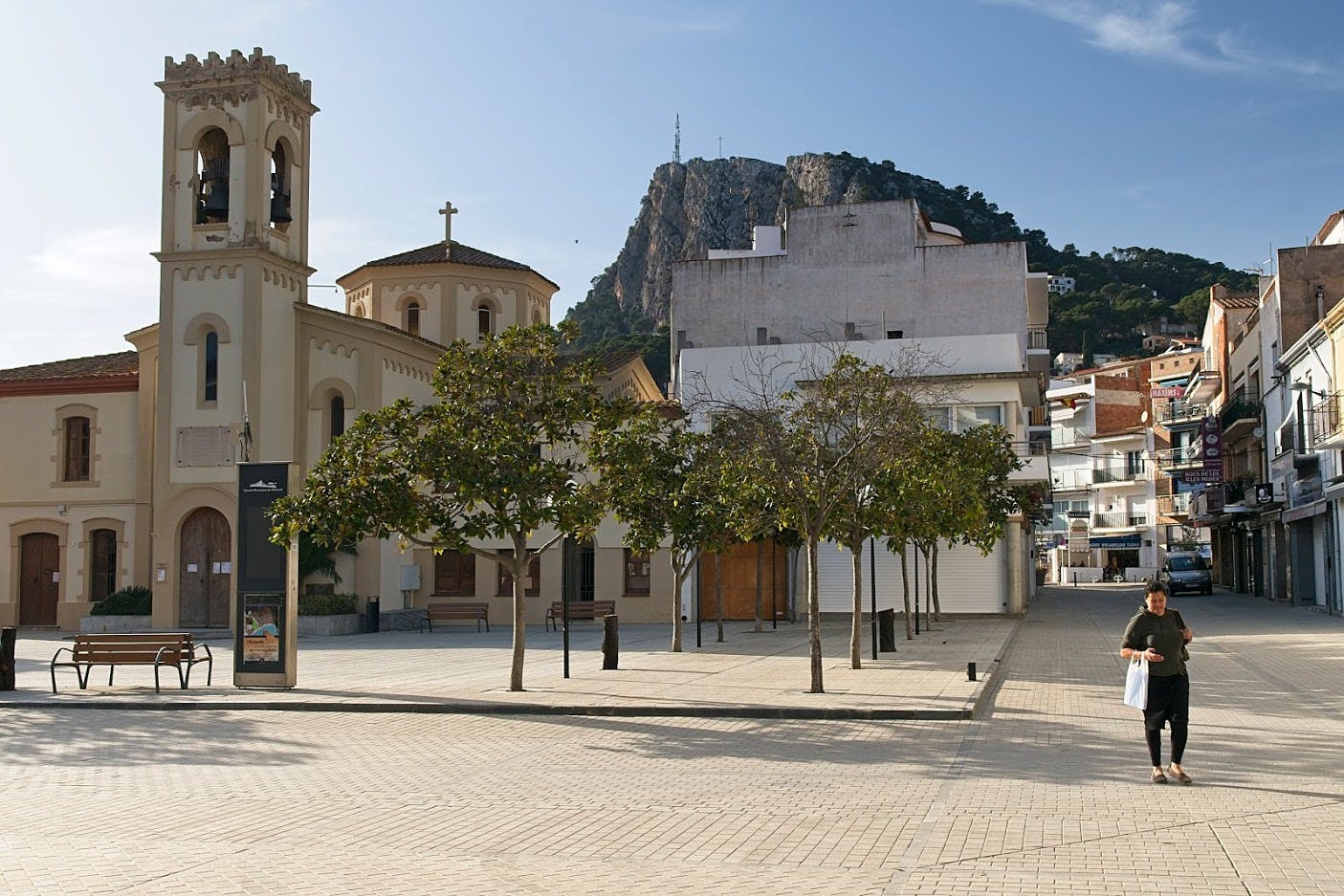
We can't recommend motorhoming in Spain more highly. To escape to a sunny climate, to visit one of the beaches along the 4,964 kilometres of coastline or to experience the culture in beautiful cities such as Barcelona, Valencia, Madrid and Malaga. Find a place at one of the many motorhome sites and start exploring. Visit buildings by artists like Gaudí and Dalí, hike through the mountains of northern Spain and enjoy Spanish dishes such as paella, tapas or pinchos all day long. A post-lunch dip? Feel free to give in and take part in a tradition that is still common in Spain: The Siesta. Sounds great, right? What are you waiting for? Start planning your motorhome trip to Spain. Read the information below before you go, and you will be well prepared on your way. No time right now?
Overnight stops
Looking for a motorhome site in Spain? Use our Campercontact app for motorhome sites in Spain . Staying overnight in parking areas next to the motorway is permitted, unless there is a sign prohibiting this. The rules about wild camping in Spain are unclear. Policies vary from region to region and enforcement also differs. It is certainly not allowed in national parks. However, what is allowed is an overnight stay along freeways and specially designated parking areas for motorhomes and on campsites.
Emergency telephone number
Ambulance: 061 Fire service: 080 Police: 091 Emergency telephone number: 112
Compulsory to bring
A warning triangle and reflective jackets for all occupants.
Roads and traffic
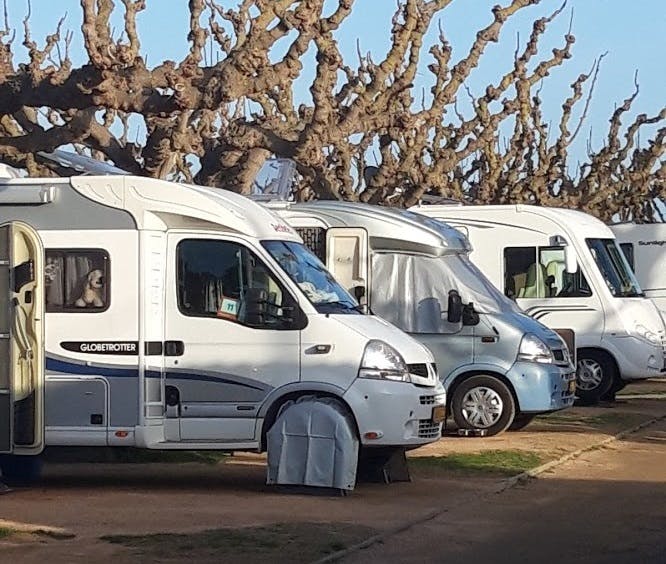
Speed limits
Going to Spain with a motorhome? Then the following speed limits apply:
- Outside built-up areas with a motorhome that weighs 3.5 tons or less: 80 km per hour
- Outside built-up areas with a motorhome that weighs more than 3.5 tons: 80 km per hour
- Motorway ≤ 3.5 tons: 120 km per hour
- Motorway> 3.5 tons: 90 km per hour
Driving in winter
Winter tyres are not compulsory in Spain. Snow chains are compulsory in places where indicated by signs.
Tolls are charged on several roads in Spain. The exact toll roads are shown here . You can also download the tariffs.
Additional load
- In Spain, the additional load outside the motor home can be a maximum of 2.55 meters wide and it may not extend outside the vehicle.
- The additional load at the rear of the motorhome may not exceed 10% of the length of the vehicle. Or 15% if the load cannot be divided.
- It is compulsory to indicate the load with a 50x50 cm reflective panel, with three diagonal red and white stripes on it. And if the load is as wide as the entire width of the motorhome then two of these boards must be attached at the ends. Together these must form an inverted V. You will be fined if the sign does not meet the Spanish guidelines.
- If the length of your vehicle + the length of any trailer exceeds 10 metres, you must keep a minimum distance of 50 metres from the vehicle in front outside built-up areas.
Other traffic rules
A motor vehicle may not tow another motor vehicle in Spain. Towing another vehicle to a safe place is only permitted in an emergency.
Environment
Spain has a number of low emission zones, including in Barcelona and Madrid.
Low emission zone in Barcelona
In Barcelona, the low emission zones are in force on weekdays between 7.00 and 20.00. The Barcelona ring road is excluded from the low emission zone. Vehicles not registered in Spain must register to enter the low emission zone. Diesel motorhomes with an emission class of Euro 4 or higher and motorhomes with an emission class of Euro 3 or higher are eligible to register for a two-year period. Motorhomes that do not meet the requirements can register for €5, after which it is possible to apply for an exemption up to 10 times a year for a fee of €2 per day (prices in 2020 and 2021). More information or to register your motorhome? You can find more information here.
Report a change?
The information on this page is checked regularly. However, it is possible that the regulations have changed in the meantime. All information on this page is therefore subject to change. Have you discovered an error? Please let us know via our contact form and we will, if necessary, amend it as soon as possible.

Campervan Castaways
Vanlife 4×4 | adventure motorhome travel.

Top Tips Winter Motorhome Trip Spain

Top Tips Winter Motorhome Trip to Spain
Like so many others, we just love a bit of warmth to break up the grey British weather, so let’s get into the mood with our top tips for a Winter Motorhome trip to Spain.
Ok, so we’re not the only ones who like to head South for the Winter – far from it. That’s because the popularity of all-year motorhome travel has exploded in recent years and with it has come a whole new generation of motorhome adventurers driving to Spain.
So, let’s get stated with our top tips for a Winter motorhome trip to Spain and find out just what you can expect when you arrive.

1. Is Spain the Only Warm Winter Option?
For those wanting to drive to warmer climates in a motorhome, there aren’t many options available. Unless you head to Portugal’s Algarve or cross the Mediterranean to Morocco, then the South coast of Spain is about the easiest and warmest location.
Otherwise, most of Europe is pretty damn cold in Winter, despite having hot Summer’s in many regions. In other words, you have to be quite far South in order to have warmth from the sun in Winter.

2. What do we like about it? – Top Tips Winter Motorhome Trip to Spain
I’m going to be honest here – Southern, coastal Spain isn’t our favourite destination, but it does what it says on the tin and that’s all you can ask.
Above all, it offers what we all want from a Winter trip – plenty of sun, clear blue seas, a reasonable cost of living and plenty of motorhome stopovers. Last but not least, it’s a friendly kind of place too.

4. Ferry Crossings – Top Tips Winter Motorhome Trip to Spain
When it comes to reaching the Spanish Mediterranean coast there’s basically two options – drive through France or catch a ferry to Northern Spain.
First is the ferry crossing options from Plymouth and Portsmouth to Santander and Bilbao – both of these ports are in Northern Spain and take either 20 or 24 hours.
https://www.brittany-ferries.co.uk
How much is a crossing?
Now for the important question – how much does it cost? Well, to put it bluntly, a ferry to Spain from the UK is not cheap.
For example, for a mid-week crossing departing mid-January and returning mid-March 2023 in a motorhome up to 8m long and up to 3m high, would set you back £1200 for a return trip. This quote was for 2 adults without pets with a cabin each way.
Chances of Bad Weather
The downside of the ferry, has to be the weather or should I say – if you’re unlucky and end up with bad weather! Yes, if those storm clouds flare up, then the rough seas will start. With it comes the possibility of a very memorable crossing – for all the wrong reasons.
Distance from the Mediterranean coast
Next, comes the issue of having to drive some distance once you arrive in Spain, because both ports are located in the North of the country.
At the end of the day, this means there’s still a long way to travel before any chance of catching those Winter rays of sunshine.
Lastly, the actual travel time to the Mediterranean coast from both Santander and Bilbao are not that different. That’s because both ports are relatively close together – being about a 1 hour drive between the two.
Remember, there will still be fuel costs for the above distances to consider.

5. Driving through France – Top Tips Winter Motorhome Trip to Spain
I have to say – this our preferred route to Spain, taking the 30 minute Eurotunnel to Calais, before the long drive through France.
However, I know it’s not for everyone and on top of that France is absolutely miserable in Winter! There’s also the issue of motorhome services being closed for the season. Basically, you have to be prepared, ensuring you fill up and empty wherever you find a working service area.
In addition – preparing for bad weather is also important. I’m thinking about a time when we were snowed-in in Northern France – on a motorway!
Thankfully, we had snow socks and snow chains, although we’d never thought we’d need them.
The journey through France will inevitably involve toll roads. However, in our opinion this isn’t too costly, considering the distance is about 780 miles.
For example: On a journey from Calais to Port Vendres – which is situated close to the Spanish border – we spent €220 return on tolls.
This was for a motorhome under 3.5t — which is a Classe 2 but included the Millau Viaduct.
However, in our A-Class Carthago, which was 4.2t and a Classe 3, the differences were never that great. Even better – if we were able to ask at the toll area for a reduction to a Classe 2, the staff very often obliged.
Another consideration is the cost filling up with fuel – for example, the cost from Calais to Port Vendres – came to €460 return on this trip. However, with the current high fuel charges in France, this could be higher.
Overnight Stops
The good thing about driving through France, is that you’ll always find somewhere to stop the night. Although it’s worth pointing out that Aires may be closed or might not look so appealing in Winter.
Personally, we don’t like to stay on motorway Aires, instead choosing the Aire de Camping Car options found throughout France. In general campsites will be closed in Winter, so you can’t rely on these for an overnight stop.
Here’s a list of Aires in France we’ve stayed at in Winter, en-route to the border with Spain. Finally, the approximate drive time from Calais to Collioure (close to the Spanish border) is 11 hours.

6. Crossing from France to Spain?
Our route from France has taken us into Spain just beyond the French coastal town of Collioure. Once you reach the South coast of France, the weather should have changed to the Mediterranean Winter you’d expect.
However, this isn’t necessarily hot! The average January temperature is 10C with a low of around 5C, so you’ll still need some warm clothing.
One of the last towns you drive through in France is Cerbére, before crossing the old border point to Spain.To be honest, we noticed the difference straight away between the two countries, as the more affluent regions of the French coast were left behind.
This route brings you to a rather mountainous area of Spain, crossing the border into the rugged landscapes of a winding pass and the Catalonia region.
From now on, if time allows, the motorway network is best left behind, in favour of coastal routes and country roads towards the well known Costa Brava.
With the exception of a few coastal locations just North of Valencia, we were able to tour along the entire coast. Starting in the Costa Brava and travelling as far as the Costa Almeria without using the motorway network.

7. What’s the weather like?
Well this all depends which part of the coast you go to, for example, The Costa Brava which is the further North has an average high temperature in January of 14C. On the other hand, the more Southerly region of Costa Almeria has a January average high of 17C.
In general, expect a mild Winter with blue skies and pleasant daytime temperatures, but don’t reach for the bikini or Speedo’s just yet. Above all, go prepared with light layers and a coat, with the possibility of some nice warm spells in a sheltered spot when the sun is shining.

So how did we find the weather?
Well, I would say, it was far better than the cold, grey, wet and windy weather we have in Britain. In fact, in comparison to the UK, spending Winter on the coast of Spain is a treat! That’s because the skies are generally clear and blue, so the sun is shining which makes us feel better, although it’s not necessarily beach weather.
On the whole, it’s just a pleasant way to spend the Winter, with a bright feel to the day and little in the way of endless cloud cover and rain.
The below table shows the average high temperatures across the main regions in the months of January and February – some areas are not quite as hot as you’d think!

8. Does Spain have Motorhome Aires?
In short the answer is Yes, although these do differ slightly to Aires you’ll find across France. This is mainly because many motorhome stopover locations in Spain are private.
Having said that, there are still Motorhome stopover areas provided by the local authority. Although, generally they are few and far between in these coastal regions.
Because most of the Motorhome stopovers are privately owned, many will offer extra facilities – such as showers, toilets and electric points. As with any stopover type system, these vary enormously and sometimes they can be just a parking area.

9. Are there Motorhome dump areas?
Yes there are.
There are some public Motorhome service areas, but most are located at either private stopovers or at a campsite.
Most will have a small fee applied for using them.

10. Does it get busy? – Top Tips Winter Motorhome Trip to Spain
Absolutely! One thing to remember with motorhome Winter trips to Spain – is that the rest of Europe want their share of the sun too!
So, with that in mind, expect to share the campsite or motorhome stopover with plenty of Europeans.
It’s worth knowing that on our trip, the campsites and private motorhome stopovers were full, with many people spending the entire Winter in one place. In addition, we soon found out that many areas are booked up well in advance and have little in the way of vacancies for the whole season.
Public motorhome stopovers are less busy because people tend to move on more or have to do so due to the rules of the principality. Unfortunately, there aren’t that many of them though.

11. What’s the Best Region in Winter?
We found that the first regions across the border – So – the Costa Brava to the Costa Dorada were very quiet. This was mainly because they were pretty much closed for Winter. Probably due to the weather in these regions not being as good as those further South.
However, there are still some nice areas to see, but it all feels a bit like a ghost town! Once you reach the Costa Valencia, there are a lot more places open, people visiting and less of an empty atmosphere.
Further South again, you reach the main Winter destinations of the Costa Blanca, followed by the Costa Calida and Costa Almeira. It’s now that the weather becomes more settled and the best of the Winter sun resorts spring into action.

12. Can you Wild Camp? – Top Tips Winter Motorhome Trip to Spain
Oh this is a difficult one because we wild camped most of the time. However, it was messy – Motorhomes, caravans and vans were everywhere and most were camped up for the whole Winter.
I have to say we didn’t really like the feel of it all and it was obvious that the locals didn’t either! For us, we didn’t have much option in many places, simply because everything official was so full.
In most places, there were multiple motorhomes parked up – this being on streets, beaches, car parks, even along storm trenches.
However, the authorities have since stopped this wild camping madness in some areas, so if we visit again, we’d hope to find space at one of the many official motorhome stopovers that were under construction.

13. What are Campsites Like?
Campsites are very full, with many visitors staying the whole Winter and in the process bringing everything with them for their stay.
By this, I mean anything from outdoor furniture to a spare fridge, trailers with scooters, tow cars and just about everything else including the kitchen sink!
Motorhomes can be huge – the bigger the better when it comes to some nationalities and pitches are well maintained. Most sites have a wide range of facilities and are well equipped for the repeat visitor, ensuring excellent cleanliness and extremely tidy landscaping.
Last but not least, entertainment and activities are arranged on many sites, allowing for those long-term visitors to keep active and stopping them from becoming bored. Then of course, this may be not everyones cup of tea!

14. Can you book a Motorhome Stop?
Yes you can book some private motorhome stopovers. Most will have a small office on site with someone available to take bookings and keep a watchful eye on the area.
We called off-chance at several different locations, unfortunately though, there was little in the way of availability.
15. How safe is it in a Motorhome?
Unfortunately, one country we’d been warned about in the past is Spain, more often than not, this was because of theft and we weren’t immune to problems.
When it comes to wild camping, the risks are even greater, so it’s worth weighing up the risks. In recent years we’ve spoken to several people who’d had their motorhomes broken into, usually though forcing a window in the habitation area. Then another route being to enter the van through the cab door.
Having said that, these instances can occur in other countries, so it’s not unique to Spain and it’s important to put that into perspective. For example, in our 20 years of travels in Europe, we had never had an incident – that is until we went to Spain!
You’ll have to keep an eye out for our next blog post to find out more about what happened to us whilst wild camping in Spain.
Finally, in all fairness, when staying on a campsite or an official motorhome stopover, especially a private one which has an office – then the risks from theft are probably no greater than anywhere else.
Last but not least – it’s important to remain vigilant and take extra precautions against theft before leaving home.

16. Do Motorways have Tolls in Spain?
Yes, there are tolls on some motorways and you can pay at the toll booths or order a Tag beforehand from Emovis and have it delivered to your door.
17. How do you find a Stopover?
Now on our visit to Spain, there were so many new motorhome stopover areas opening up, that it was impossible to keep up!
So, we think the best way to find a stopover is through a mix of using an App, as well as looking out for the motorhome signs in locations across the regions.
We like to use the Camper Contact App – https://www.campercontact.com/en because this is operated by the Camper Club of The Netherlands and as a result it only lists official, authorised stopovers.
In other words, you won’t find “wild camping spots” on here or areas that haven’t been checked by their publication team, prior to listing on the App.
There are other Apps out there which also list official stopovers and campsites – such as Park4Night and Search For Sites.
These also list “wild camping” areas submitted by users of the App, however these may not necessarily be locally authorised locations – so be sure to check for any signs at the locations. Also, double check for fines and rules of where you are about to park up overnight.
https://park4night.com https://www.searchforsites.co.uk
18. Is it Cheap to Eat Out? – Top Tips Winter Motorhome Trip to Spain
Yes it is, especially at lunch time when many beach bars and restaurants offer a set 3-course menu, often including a drink and all for around €10. However, in 2022 we undertook a tour of inland Spain and we found that prices of food and fuel had increased dramatically since lockdowns.

19. Are there lots of British in Motorhomes?
Yes there are plenty of British travellers, but probably more German and some Dutch.
To be truthful, we found some of our European neighbours fairly unwelcoming, especially when we arrived at busy motorhome stopovers or wild camping spots.
We were told that we couldn’t use certain free pitches – because those already there were expecting regulars or friends, despite there being no reservations.
It seemed to be a case of leaving places free, for those that had that same parking place each year, regardless of who may arrive in the meantime.

20. New Motorhome Stopovers
We were passing new motorhome stopovers being built on a regular basis, then on our return a few weeks later, these were finished and open.

21. What about Winter daylight hours?
One important thing to remember in our top tips of a Winter trip to Spain – it still gets dark early! For example in mid January, you can expect a Sunrise at about 8.15am and Sunset at around 18.15pm.
In other words, it can be a long night in the motorhome!

- Calais Nord Notre-Dame
- Port-Vendres
- Saint-Amand-Montrond
Thanks for reading: Top Tips Winter Motorhome trip to Spain – subscribe below for Latest Posts
Enter your email address
Discover more from Campervan Castaways
Subscribe now to keep reading and get access to the full archive.
Type your email…
Continue reading
Travel Safe
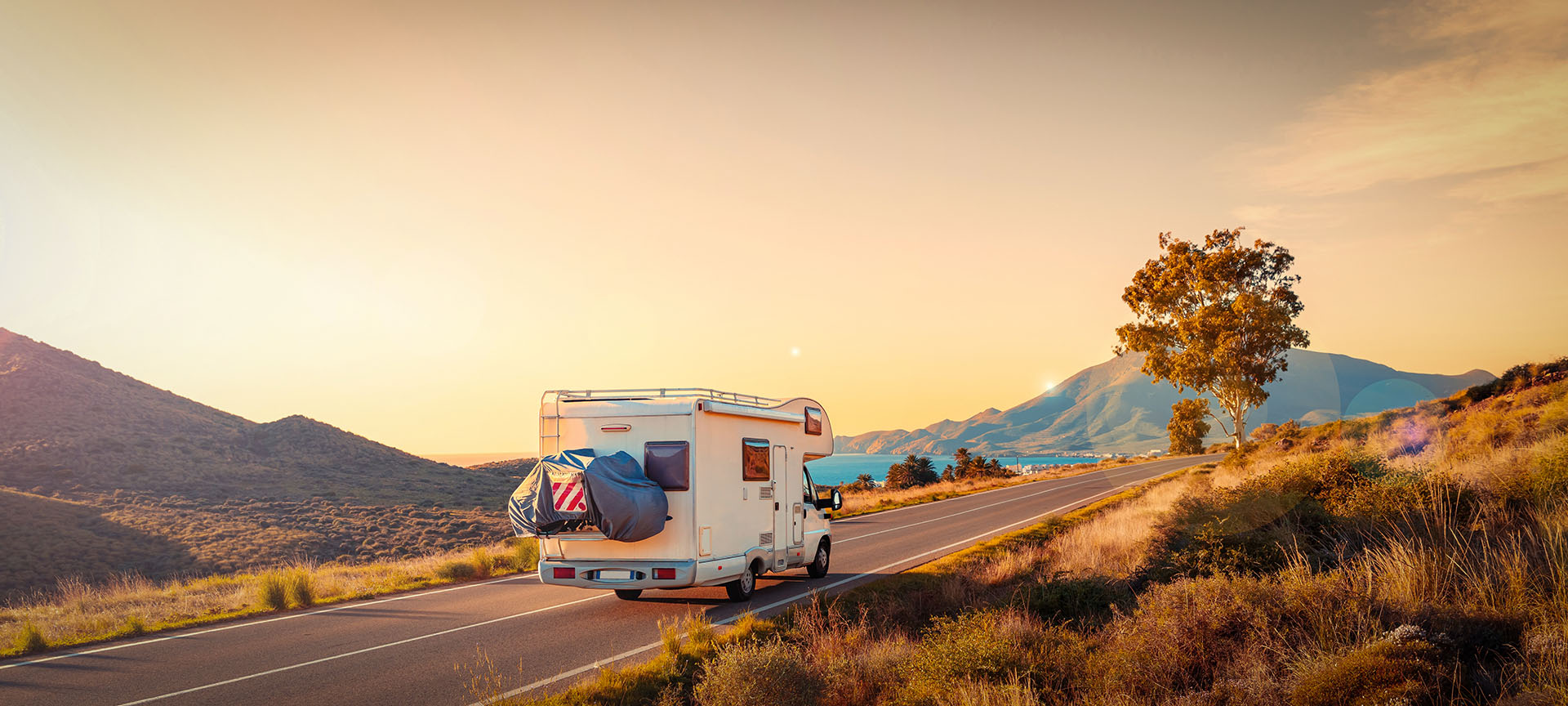
Destinations in Spain perfect for visiting with a motorhome

Circular route from Barcelona for discovering Catalonia
Tailormade tours for this type of travel are the thing of dreams for all caravan lovers, as this makes planning much easier. With this in mind, Catalonia has a circular route spanning more than 2000 kilometres, starting and ending in Barcelona and covering more than 350 locations of interest. The Grand Tour of Catalonia is divided into five sections. The third of these, from Lleida to La Seu d`Urgell , is perhaps the most attractive for motorhome trips no matter what time of the year you are visiting. Why? The impressive scenic roads and natural landcscapes that it takes in, including Aigüestortes i Estany de Sant Maurici National Park . Get ready to admire the medieval villages of Val d'Aran, the starry skies of the Starlight reserve in the Montsec mountain range or the Romanesque churches of Vall de Boí , declared a UNESCO World Heritage site, as well as being home to multiple hiking routes for all levels. This section of the itinerary boasts a variety of service areas and overnight campsites along its 357 kilometres, which we recommend dividing into five stages. One example is the Vielha e Mijaran camper park , equipped with excellent facilities and even a laundry service and electric bicycle rental. Its location, in the heart of the Pyrenees, is perfect for participating in winter sports at ski resorts including Boí Taüll , the highest in Catalonia, or the popular Baqueira Beret .
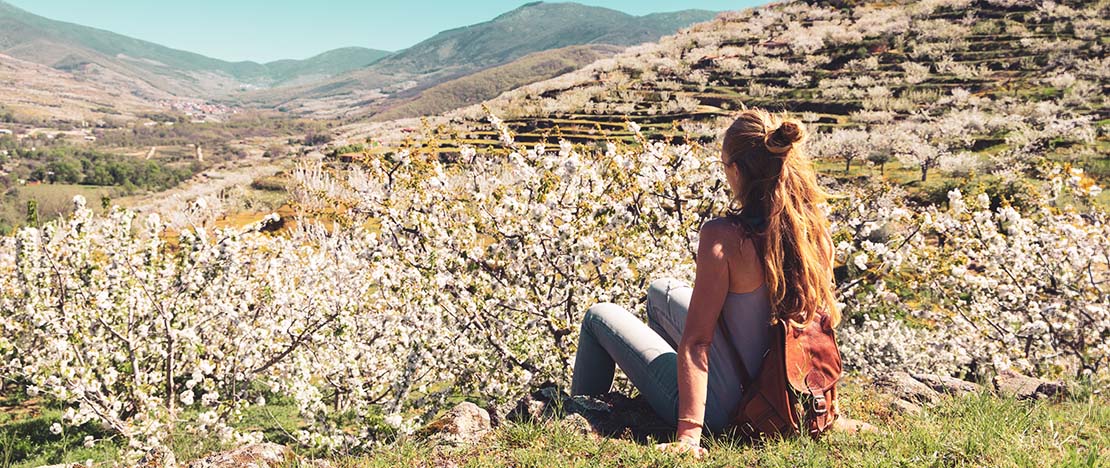
More than 30 towns across Extremadura where you can spend the night
Extremadura is another perfect destination for visiting by motorhome, as it is possible to spend the night in more than 30 towns spread throughout across the region. What is most impressive is that it boasts a variety of different options, ranging from rest areas close to urban hubs of particular cultural interest and those nestled between mountains and valleys, in unique natural settings. The easy access for caravans in Extremadura mean its three World Heritage sites are now within reach: Cáceres , Mérida and the Monastery of Guadalupe . Mérida is home to the Roman Theatre and Amphitheatre archaeological complex, for example as well as the Camper Park Cáceres Nature on the popular Vía de la Plata as it passes through the city. Other options include the historic quarters of cities including Badajoz and Plasencia and towns renowned for their heritage and gastronomy, such as Trujillo or Zafra . Another good reason for travelling to Extremadura by motorhome and, specifically, to the province of Cáceres, is to experience events such as the flowering of the cherry trees in the Valle del Jerte or the 'Magical Autumn' festival in the Ambroz Valley , with the Peña Negra Camper Site or the Hervás Greenway parking area conveniently located close by.
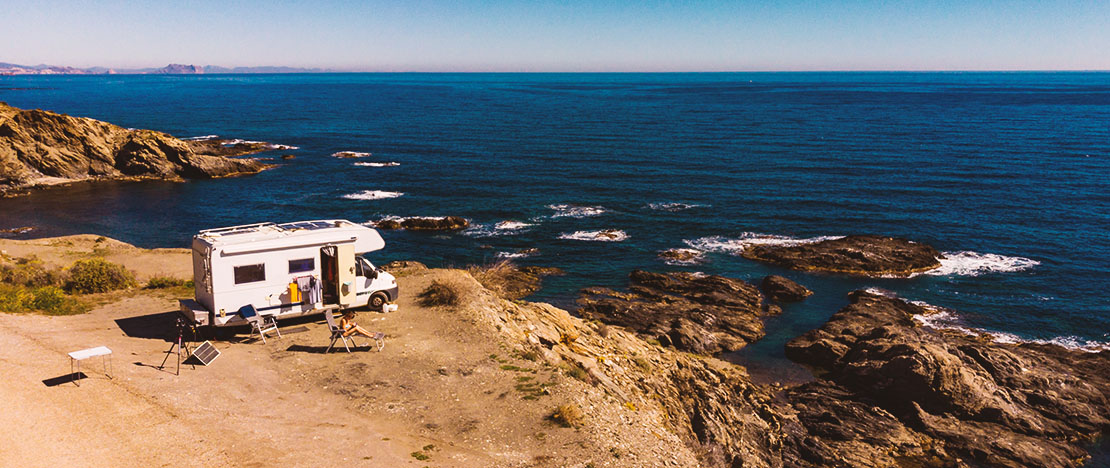
From Cabo de Gata to Cadiz, from east to west Andalusia
Have you considered discovering the maritime-land reserve of Cabo de Gata – Níjar Natural Park , in the province of Almería for yourself? Agua Amarga, a beautiful town boasting a seaside atmosphere and white houses, is one of the best areas for motorhomes in Cabo de Gata. Equipped with all the comforts and services, this Camper Park is just over 300 metres from the Mediterranean Sea, boasting a beach with crystal-clear waters, cliffs and impressive caves. Then head to the other side of Andalusia, to Vejer de la Frontera , in Cadiz . Its extensive El Palmar beach, spanning more than eight kilometres in length, perfect for relaxing walks along the shore, is home to a guarded caravan park open all year round, with capacity for more than 150 vehicles and equipped with all the services.
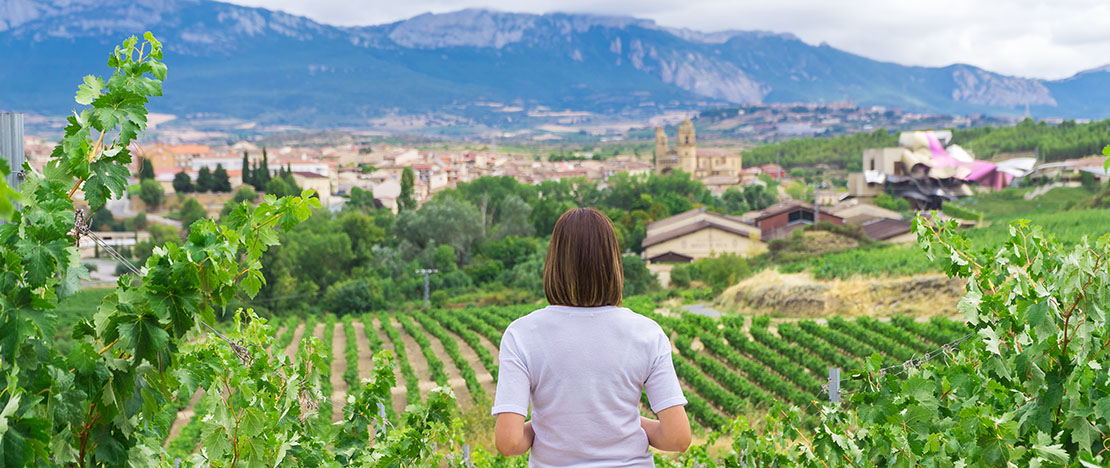
Park up in Elciego to discover in Álava, land of wines
If you prefer to visit the north of Spain, the province of Araba-Álava , in the Basque Country , is home to more than a dozen rest areas equipped with services for you to stock your drinking water tanks, emptying them into the sewage network and waste disposal facilities. The Elciego motorhome area, open all year round, is very close to the centre of this iconic town on the Rioja Alavesa Wine Route and from where you can visit the City of Wine, with its avant-garde building designed by architect Frank O. Gehry, or a number of medieval underground cellars to discover the origins of the production of this town's characteristic wines. The option of visiting Vitoria-Gasteiz by motorhome is also particularly appealing, as you have the option of spending the night in the Lakua camper site or the Ibaia campsite. The area is home to eight recommended routes for discovering both the city and the surrounding area, including the Ayala Valley, the Zadorra lakes or the Alavesa Mountain. All these recommendations include public transportation options.
In short, Spain boasts more than 2,500 rest areas and a thousand campsites equipped for motorhomes, half of them located on the coast and the rest in mountain and inland areas spread across the country. What are you waiting for to start organising your caravan holiday to Spain?
Travel plans for inspiring you
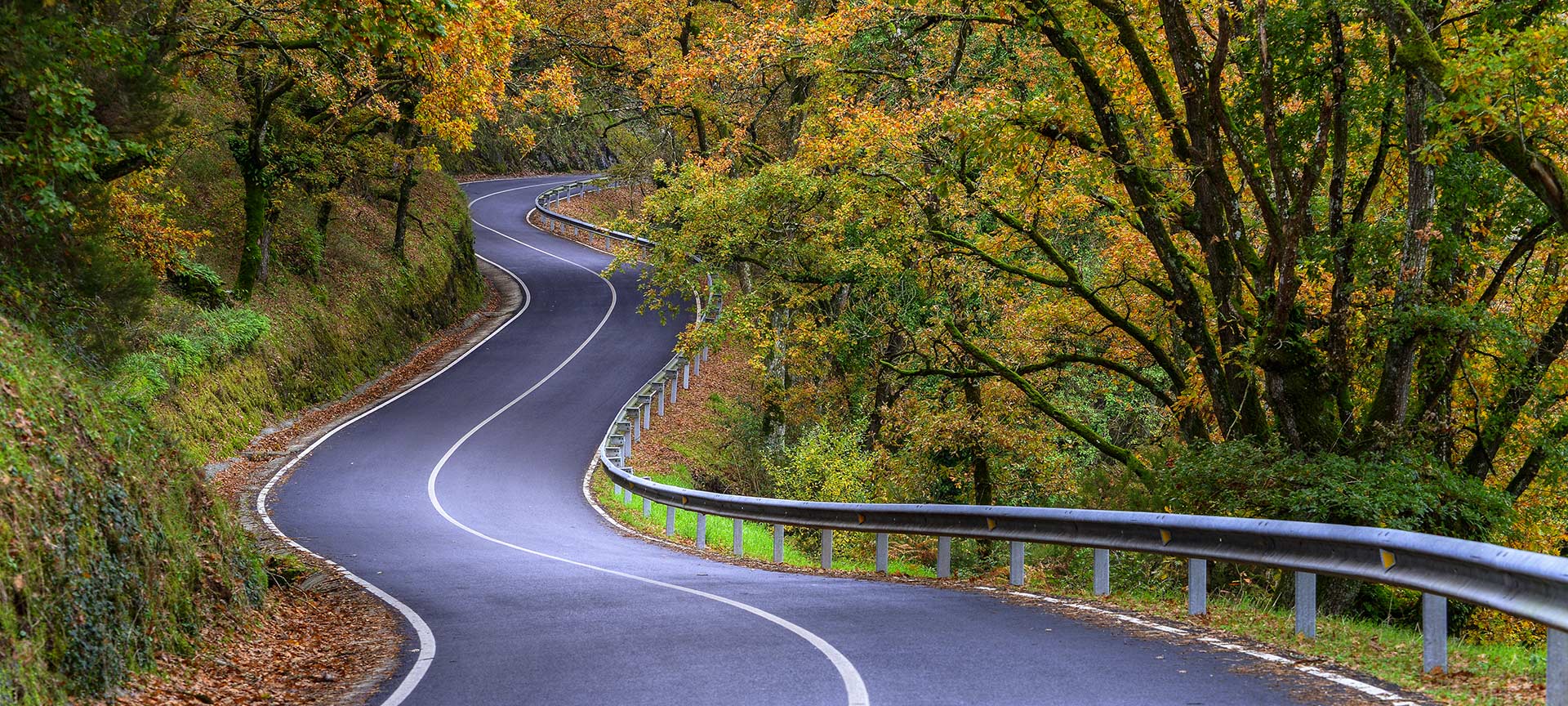
Galicia on the road, spectacular landscapes, in images
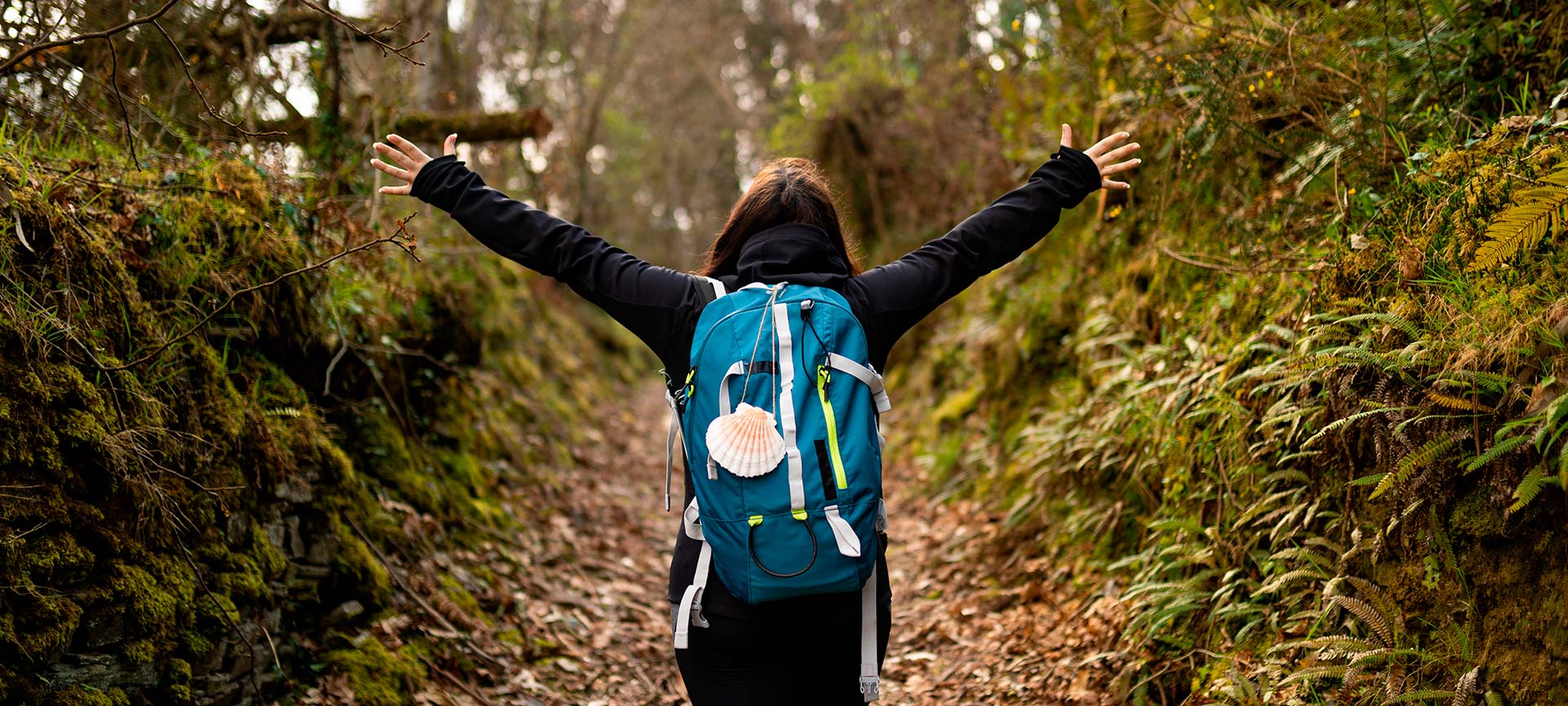
How much do you know about the routes of Spain? #SpainQuiz
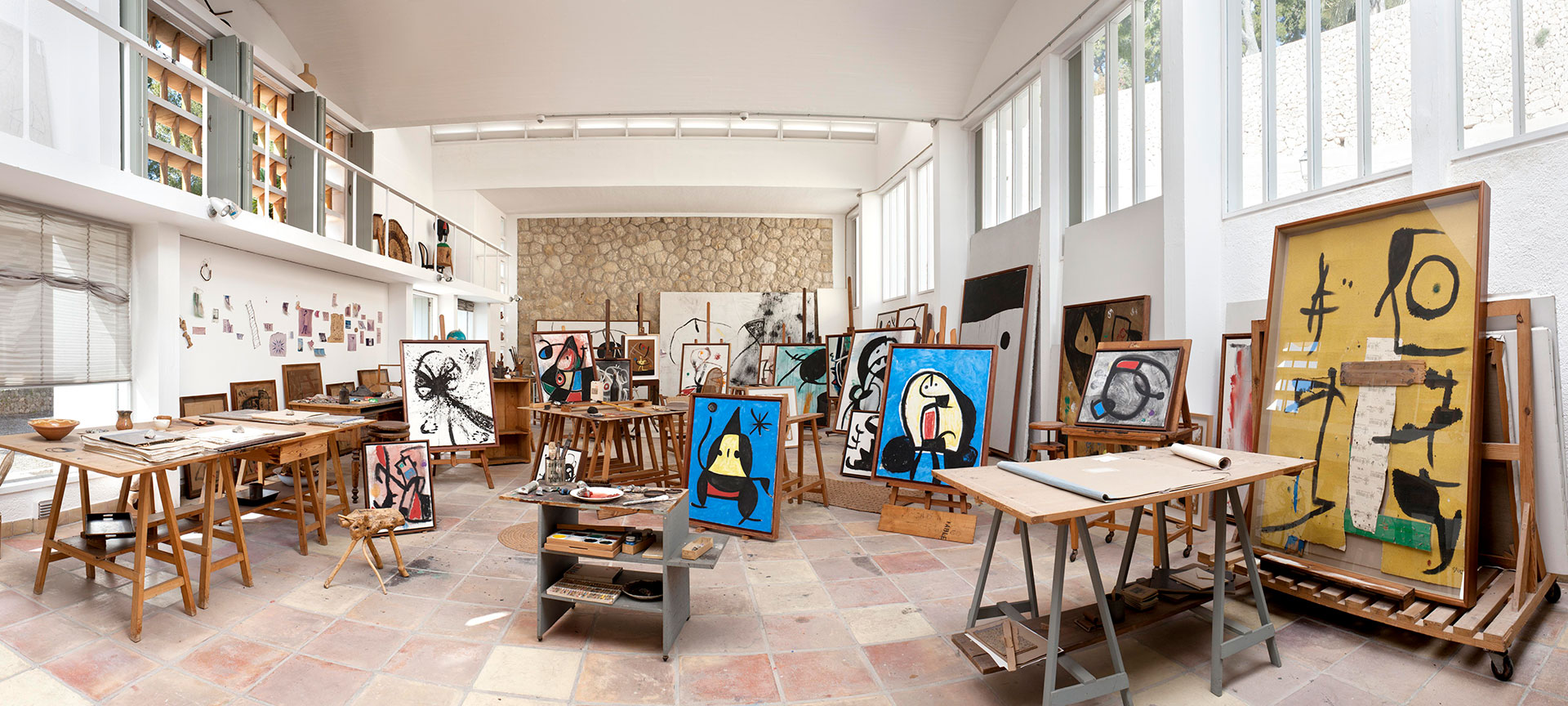
In the footsteps of Miró

Choose between thousands of activities to live your best life on holiday.
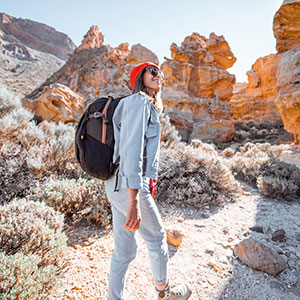

8 Motorhome routes in Spain in Winter
Spain is one of the most visited destinations by travelers from all over the world and any time of the year is perfect for it. A country where the footprint of history and the mixture of cultures is still present with a large number of places and monuments of great cultural and architectural richness to visit such as the Alhambra in Granada. On the other hand, it has also been able to adapt to the times, turning some of its cities such as Barcelona into a focus of avant-gardism.
Spain is the richest country in Europe in biodiversity thanks to its richness in species, natural habitats and its climate. We can find from wild white sandy beaches like Carnota in Galicia to mountain ranges over 3,000 meters high like Mount Teide.
And if we talk about its best qualities, we cannot forget its gastronomy. Spanish cuisine is currently one of the best valued in the world. The variety of typical dishes, creative and healthy, make it a perfect example of Mediterranean diet to discover accompanied by a good wine.

- Camper Van with Winter Mountains | MemoryCatcher - Pixabay
Why take a winter tour in Spain?
Doing a motorhome tour in Spain in winter is to enjoy the comfort of your motorhome and many other advantages that this season gives us. The villages shed their skin, take out their best decorations, coats, fireplaces and we can not forget the snow, it will make real magic in our photos.
It is a unique moment in the year to take advantage of the typical winter dishes in many places of our country and of great rewards to the cold outside with relaxing baths in spas with beautiful views.

- Camper Van with Winter Mountains | Luke Porter - Unsplash
Motorhome Tours in Spain
Spain is full of wonderful places and the routes in motorhome are one of the best ways to know closely its corners.
That is why we have compiled the best motorhome routes throughout Spain, along with recommendations on what to see, what activities you can do and where to spend the night.

Route through the Pyrenees
The southern slope of the Pyrenees extends from Cap de Creus in Catalonia, through Aragon and Navarra to Jaizkibel, in the Basque Country. There is no better way to get to know it than on a route in a motorhome or camper and enjoy its landscapes and charming villages such as Ansó. Peaks over 3000 m, glaciers, lakes, forests and valleys where you can fall in love with the whiter side of the mountains. Take the opportunity to practice outdoor activities such as snowshoeing or skiing and then regain strength tasting typical dishes of the area such as Boliches de Embún, Recao de Binéfar or farinetas de Aragón.
There are many places to spend the night in this area. We have selected three that you cannot miss.
- Camping Los Vives Our recommendation for Seniors. Located in the Bal de Chistau, between the Ordesa National Park and the Posets Maladeta Natural Park, it is the perfect place to enjoy a stay in full contact with nature and with all the amenities offered by its facilities.
- Camping Borda Bisaltico Our recommendation to enjoy with the family. This is a campsite with an excellent grill restaurant, with good facilities and located in the Echo Valley, in the heart of the Natural Park of the Western Valleys. Nearby is the Selva de Oza, the Agua Tuerta Valley and the village of Ansó, one of the most beautiful in Spain.
- Ordesa Pyrenees Motorhome Area Our recommendation for couples. This motorhome area is located in the heart of the Aragonese Pyrenees, in the village of Fiscal, just 20km from Ordesa and Monte Perdido. An area with very close treatment with the responsible of the area that will inform you of a myriad of activities that you can enjoy during your stay.

- Valle Aguas Tuertas Pirineos | Viajando Nuestra Vida
Route through the Cantabrian area
From the beach of Hondarribia in the Basque Country, passing through Cantabria, Asturias and reaching Cape Ortegal in Galicia we can make one of the most spectacular motorhome routes in Spain. Following the coast of the Cantabrian Sea we can enjoy fishing villages like Cudillero in Asturias, hidden beaches like Berellín in Cantabria, vertiginous cliffs like those of Arnuero, beautiful landscapes, lighthouses with a lot of mystery and a contrast of colors from the purest green to the most intense blue. An area that besides enjoying it by sight you will enjoy it by taste, because its gastronomy of sea and land with dishes such as cocido lebaniego or bocartes a la cazuela, will make your route in motorhome a real enjoyment.
In this route the places to spend the night are located mostly on the coast. Take note and enjoy this selection:
- Camping Cabuérniga Our recommendation for seniors. Located in a protected natural environment, it is the ideal place to relax and enjoy nature in its purest form with the possibility of seeing a great diversity of birds, fauna and contemplate the native vegetation. In addition, from the campsite you can visit the beautiful Cabuérniga Valley on different routes on foot or by bike.
- Motorhome area of Camping Villaviciosa Our recommendation for families. A motorhome area with a capacity of 57 places, 24 of which have electrical connection and with all the necessary services. In addition with the possibility of access to all the services of the campsite with very economic prices. A welcome initiative by this campsite and with services that are difficult to find in other motorhome areas.
- Motorhome area of Liérganes Our recommendation for couples. Located 2 minutes from the old town of Liérganes, one of the most beautiful villages in Spain, it is ideal for getting to know this village and as an entry point to the Pasiegos Valleys. A quiet place, with services of emptying and filling of water and in a town with a lot of charm and history.

- Landscape Playa de Prellezo

- Camping at Berellin Cantabria | Viajando Nuestra Vida

Route through the lands of the Ebro
The third route that we propose you is by the zone of the lands of the Ebro, located in the south of Catalonia and that goes from the regions of the Montsia, Bajo Ebro, Tierra Alta and the Ribera de Ebro. This area, which stretches from the coast to the interior, bordering Aragon, is of great scenic and cultural richness. Land of calçots, vermouth, rice and quality fish.
It offers an incomparable setting when traveling by motorhome as nature, sunsets and traditions such as rice festivals, become the protagonists of this route. We cannot forget to mention that it has one of the largest wetlands in Europe, the Ebro Delta Natural Park.
The places to spend the night in this area are varied. From spots close to bird watching to places under a medieval castle. Here is our selection:
- Camping Ampolla Our recommendation for seniors. A cozy and familiar campsite with all the comforts located on the beach with more than 2km of sand in the fishing village of L'Ampolla and at the gates of the Natural Park of the Ebro Delta. An exceptional place to enjoy the spectacular sunsets of this area and ideal for relaxing with the pleasant walks along the coast.
- Casa de Fusta motorhome area Our recommendation for families. Right on the shore of the l'Encanyissada lagoon and surrounded by rice fields, you will find this private motorhome area with all services. In addition to its exceptional location in the heart of the Ebro Delta, it is right next to one of the most emblematic buildings of the delta, the Casa de Fusta museum.
- El Masroig motorhome area Our recommendation for couples. A fantastic area with filling and emptying services and with privileged views in the middle of the village. Besides being a good place to stop and visit the village, it is highly recommended to visit the wineries for a wine tasting next door.

- Miravet Priorat Flujo | susnpics - Pixabay
Route along the Valencian Coast
For lovers of mild temperatures throughout the year and those who want to walk along the beach with the sun on the face in winter, we recommend a motorhome route along the Costa Valenciana.
From Peñíscola in Castellón to Torrevieja in Alicante there are about 400 kilometers of good weather to walk along beaches such as Playa de Tamarit in Santa Pola (Alicante) or Terranova in Oliva (Valencia).
It is also an area with a lot of history and we can see it reflected in towns like Peñiscola or Morella, medieval towns that preserve an old town with a lot of charm.
For those who are looking for amazing places in nature, the Costa Valenciana holds truly amazing secrets such as El Chorro in Montanejos (Castellón) or the Natural Park of l'Albufera in Valencia.
Our recommendation for overnight stays on the Costa Valenciana is the following:
- Camping Ribamar It is our selection for families. This campsite located in Alcossebre is 100 meters from the beach, has spacious pitches, restaurant, library, multisport area, children's playground and many other services. They are also committed to the environment through a series of measures, trying to conserve the natural, landscape and cultural resources of the area (plant care; light saving; water saving; recycling of paper, glass, plastic, organic; battery collection; collection of used light bulbs; collection of used cooking oil).
- Camping Las Palmeras This is our selection for seniors. A camping resort with all kinds of services for your stay. Restaurant, relaxation area and gardens among others. This resort obtained in 2010 the Q quality certificate for its efforts to make everything perfect.
- Free AC area in Castellón de la Plana This is our selection for couples who want to be close to the beach. An area with all the free services located in the Paseo Marítimo with a maximum parking time of 48 hours in a row.

- Valencia Albufera Atardecer | Xalapi - Pixabay

- Valencia Desfiladero Chillapajaros | Viajando Nuestra Vida

Route through the Ribera del Duero
This is the route for wine lovers and runs between vineyards, monasteries, plains and beautiful villages full of heritage, gastronomy and aromas. From the province of Burgos this route extends towards Soria, Segovia and ending in Valladolid, where you can enjoy wine tourism on board our motorhome and without forgetting to have heating and a good coat.
Drive through towns such as Peñafiel (the heart of the region), Peñaranda del Duero, Curiel del Duero, Quintanilla de Onésimo, Padilla de Duero or Castrillo de la Vega. Stop at one of the wineries in the area such as Pago de Carraovejas in Peñafiel to taste their wines and take the opportunity to enjoy unique experiences on this route.
For this route we have compiled some bucolic places to spend the night for those who want to make a relaxing getaway:
- Camping Refugio de Pescadores in Covaleda Our choice for young couples looking for a place in the middle of nature. The plots are under pine trees, are spacious and with affordable prices and services of electricity, emptying, drinking water, bakery among others.
- Camping Astral is our recommendation for seniors visiting this area. It is located in the town of Tordesillas, in the center of the community of Castilla y León, next to the Duero River. Flat, plotted and with abundant shade where you can breathe a familiar and quiet atmosphere. Its restaurant offers high quality products.
- Camping Hoces del Duratón This campsite is our recommendation for families looking for activities in the area. It is located at the gates of the Hoces del Río Duratón Natural Park in a beautiful wooded area, with lawns, fountains, a children's playground with a zip line and wooden houses. Here you can enjoy nature, practice sports and adventure activities.

- Amanecer Ribera del Duero Rio Riaza | helenaespinosa - Pixabay
Route through La Mancha
Castilla y la Mancha is located in the heart of the peninsula. You will be able to make a route in motorhome that takes you to know monumental cities like Toledo, beautiful landscapes like those in the Tablas de Daimiel or monuments of legend like the windmills, in Campos de Criptana.
If there is one thing about this extensive province, it is that you will be able to choose the route that best suits your tastes. If these are gastronomic, you can delight yourself with its austere and simple cuisine where home-made products such as cheeses, wines, honey, and typical dishes such as gazpacho manchego, roasts, atascaburras, Castilian soup or stews will be the protagonists and will warm up your winter route.
If you want to follow the literary or historical steps like a knight-errant, the route through medieval villages such as Guadalajara, Tembleque, Alcalá del Júcar or Almagro, among others, will make you feel like you are in a novel.
The places to spend the night that we have selected for this route are the following:
- Camping La Veguilla Our recommendation for seniors. In the Alcarria de Cuenca, on the outskirts of a village in a quiet natural environment among pines and other species, is the modern camping "La Veguilla". An ideal place for rest and relaxation with all the comforts but also with many hiking options and places of interest nearby.
- Camping Los Bonales Our recommendation for families. Integrated in the Sierra Norte de Guadalajara Natural Park, very close to the village of Cantalojas, you will find this campsite with a quiet and cozy atmosphere. Precisely its location is perfect for endless activities such as excursions and routes in the Serranía de Guadalajara, Soria and Segovia or the obligatory visit to the Natural Park Hayedo de Tejera Negra, declared a World Heritage Site by UNESCO in 2017 just 1km from the campsite.
- Free motorhome area of Puerto Lápice Our recommendation for couples. Perfect area with all services very close to the village and with excellent views both at sunrise and sunset to the typical windmills of La Mancha.

- Spanish windmills | Donations_are_appreciated - Pixabay

Route along the Gaditana Coast
This is one of the motorhome routes in Spain in winter that we recommend you to forget about maps and slow travels. To enjoy the Costa de la Luz, on the coast of Cadiz, you have to let yourself be carried away by its more than 250 kilometers that go from Sanlucar de Barrameda to Sotogrande. Delve into its white villages such as Vejer de la Frontera, the long beaches of Tarifa or the beach of La Barrosa and other renowned beaches such as Zahara de los Atunes or Barbate.
The Gaditana Coast consists of natural sites such as the Natural Park of Cabo de Trafalgar and places as emblematic as Caños de Meca. Also known for being a place of reference in the hippie movement and for being located next to Cape Trafalgar, where the naval battle that pitted Britain against France and Spain took place on October 21, 1805.
To finish the route we recommend you to go to Jerez de la Frontera, visit one of its wineries and taste its wines of denomination of origin. These visits usually end with a tasting and are highly recommended.
There are many places to spend the night in this area but we wanted to leave you a selection of three of them:
- Camping La Rosaleda Our recommendation for seniors. This campsite located in Conil enjoys mild temperatures and tranquility in winter. Its facilities have everything you need to enjoy your days on the coast of Cadiz.
- Camping playa las Dunas de San Anton Our recommendation for those traveling with children is this fantastic campsite located in the coastal pine forest fully integrated into nature. In addition this campsite has very good facilities and a Mini club called the Chameleon designed for the little ones to enjoy activities, workshops, games and more.
- Camping El Palmar It is our recommendation for couples. It is located in one of the most beautiful places on the Costa de la Luz. Ideal for those who want to relax and enjoy the mild climate and good beach bars in the area. El Palmar is an enclave near the Natural Park of La Breña and the Marshes of Barbate. Great starting point for excursions such as "La Ruta del Toro", "La Ruta del Vino".
Route by the Alpujarra of Granada
The region of the Alpujarra, located in the heart of the Penibetic mountain range and at the foot of the Sierra Nevada, is a region full of history and culture. Just an hour and a half from the paradisiacal beaches of Cabo de Gata, one of the most beautiful coastal areas of the country, extends this region of whitewashed houses that mimic the snow-capped peaks over a thousand meters.
With a wild and high mountain landscape, it is an ecosystem that has an enormous value. Different cultures have passed through this mountain range and left their traces, such as the Iberian, Celtic, Roman, Muslim and Christian. Undoubtedly this makes it an area full of contrasts. A cultural richness that is noticeable both in the architecture of the Alpujarra and in its people. For here the roots and traditions of their ancestors have been preserved and this is noticeable in its streets and in their kitchens, where they prepare really delicious dishes such as the rich Alpujarreño dish.
If you visit the Alpujarra you can not forget to visit villages like Trevélez, Pampaneira, Soportújar, Capileira or Bubión. But above all, if you like hiking, in this area you can enjoy excellent routes such as the Siete Lagunas with snowshoes or skiing in the ski slopes of Sierra Nevada. Of course, always consulting meteorology and respecting the environment above all. Undoubtedly the Alpujarra is one of the routes in motorhome in Spain in winter that you should not miss.
In case you do this route, we have prepared some places to spend the night that will not leave you indifferent:
- Camping Órgiva Our recommendation for seniors. This small campsite enjoys great tranquility and is located in the heart of the Alpujarra of Granada, at the foot of the Veleta. You can enjoy all year round in its grassy plots and surrounded by trees such as black and white poplars, catalpas, elms and ancient olive trees.
- Free motorhome area of Ugíjar Our recommendation if you travel with your family and want to visit the area. It is located at the entrance of the town, 10 minutes walking from the center. The area has electricity, drinking water point, emptying of gray and black water.
- Camping Trevélez Our recommendation for couples who want to spend an evening enjoying the stars. They say that in this campsite you can enjoy the clearest and starry nights, as it is the highest campsite in Spain. Located in the natural park of Sierra Nevada, it is an ideal place for the ascent to Mulhacén, Alcazaba, Siete Lagunas, and many other peaks.

- Granada | Maddie Leopardo - Unsplash
What are the speed limits for motorhomes in Spain?
The speed limits for motorhomes and campers in Spain are applied as follows:
You will have to differentiate by the type of homologation of the vehicle:
If it is homologated as Motorhome/Touring:
If the MMA is equal to or less than 3,500Kg on Motorway/Highway the limit is 120km/h and 90km/h in case of driving on conventional roads.
If the MMA is higher than 3.500Kg on Motorway/Highway the limit will be 90km/h and 80 km/h on conventional roads.
If the vehicle is homologated as an adaptable mixed vehicle, the limit will be 100km/h on Motorways/Highways and 90km/h on conventional roads.
If the vehicle is homologated as a van, the limit will be 90km/h on motorways/highways and 80km/h on conventional roads.
Parking, Overnight stay, Camping in a Motorhome or Camper in Spain?
In Spain there are no specific regulations regarding motorhome parking. Therefore, it is necessary to differentiate these 3 concepts:
Parking: As it is stated in the General Traffic Regulations, the parking of a Motorhome or Camper is the same as any other motor vehicle.
In any case, it must be taken into account that, in general, parking in urban areas may be regulated by each municipality, since they are responsible for their public roads. That is to say, we can find municipalities with places where parking is allowed and places where it is prohibited.
But this municipal ordinance must not oppose, alter, distort or lead to confusion with the precepts of the General Traffic Regulations, and the distribution of these parking spaces must be equitable among all users, without depriving them of this right to park on public roads as long as the stop or parking is not dangerous, is carried out in the form and manner indicated, does not constitute a danger or an obstacle to traffic, the vehicle is placed in the manner indicated, and is also located in an authorized place.
In short: the regulations or ordinance of each locality must be taken into account, and parking in those places authorized for this purpose and in the manner indicated. Even so, parking must be permitted provided that:
- The vehicle contacts the ground only with its wheels (except on slopes where chocks are allowed).
- The vehicle does not occupy more space than the closed motorhome or camper, without opening windows, or invading the space with chairs, tables, awnings, etc.
- No emission of fluids or uncivic behavior and annoying noises are produced.
Overnight stay: Overnight stay inside a vehicle is totally allowed, provided that the vehicle is properly parked and it is not relevant the fact that its occupants are inside the vehicle, and the motorhome is not an exception, provided that the activity that may take place inside does not transcend to the outside by means of the deployment of elements that overflow the perimeter of the vehicle such as stalls, awnings, leveling devices, stabilization supports, etc.
There are two exceptions where overnight stays are not allowed.
In coasts: Where the Law of coasts will be applied and that the same one delimits in the majority of the cases by means of some white cairns, which part is coast and which is not and that you will not be able to surpass this delimitation with your vehicle.
In protected natural areas: In natural parks, biosphere reserves, etc., being areas of special conservation, in most of them there is a specific regulation regarding camping and parking. In general, parking is allowed in these areas, but only during the day, thus restricting overnight stays.
Camping: Free camping is forbidden in Spain, except in places authorized for this purpose (campgrounds, private or public motorhome areas with camping permits). Therefore if you want to perform any of these actions:
- Take chairs or tables out of The vehicle and eat outside your vehicle.
- Shower outside The vehicle.
- Open windows.
- Extend awnings or awnings.
- Put chocks
- Put stabilizer legs.
- Discharge fluids (clean, grey or black water) except those from the engine through the exhaust pipe.
- To Put an electric generator in operation.
- Make annoying noises (music, radio, etc...).
Tips to spend the night in a motorhome or camper:
Pay attention to the signs: When you arrive at a new place, check if there are any signs regarding motorhomes or camper vans. This will allow you to find the right place.
Ask questions or other users: If you arrive at a site where there are already other campers, ask them about overnight stays. You can also find out about many overnight sites in forums such as Furgovw and AC Passion.
Remember the parking rules: Remember to abide by the aforementioned rules governing parking. For you, for respect to the place and for the rest of the group.
Go with your instinct: If you think that the place you have chosen to spend the night is not the right one, the best thing to do is to follow your instinct and look for another place.
Talk to the authorities: If they knock on your door on any occasion, it is best to talk to them in a calm and correct manner. Many times they are not aware of the different regulations.
Use overnight stay APPs: use apps such as Park4night to find places to stay overnight. Campgrounds, parking, motorhome areas, services and much more. In these apps the spots are uploaded by users and you can find photos and comments about the place.
Respect the environment: Motorhomers and camper users are a group that is very aware of the care of the environment they visit. We recommend you to do the same. Dump your dirty water in the appropriate place, do not make annoying noises and respect the natural spaces.
What should I check in my motorhome or camper when it snows?
Due to the weather conditions that occur in winter, there are a number of considerations and checks that are highly recommended to take into account so that you can enjoy this time of year in your motorhome or camper. Here we have summarized for you the most interesting ones. (link to article about 10 tips in winter)
Camping in Spain in winter means enjoying the contrast of sun and snow, sea and mountains, from the Mulhacen to the Cantabrian coast, vineyards and windmills, from the Ribera del Duero to La Mancha. From an incomparable gastronomic offer with typical dishes and desserts that will give you a smile with every bite and every kilometer. Camping in Spain in winter will captivate you: from the imposing Pyrenees to the sunny coast of Cadiz.
Whatever your preference, whether as a family, couple or senior, the choice is endless and the possibilities are endless. You just have to get going and enjoy.
All the camping sites presented can be found on this map:
YOU MIGHT ALSO BE INTERESTED IN

Spanish Empanada
Spanish empanadas originally come from the Gallic region. With this recipe for the pan, anyone can conjure up a Spanish attitude to life in the camper van kitchen.

Navigation systems
Alpine offers high-quality navigation systems for all common mobile travel platforms (such as Fiat Ducato 3, Citroen Jumper 2, Peugeot Boxer 2, Iveco Daily, Mercedes Benz Sprinter and Vito, Volkswagen Crafter & T5/T6, Ford Transit and many others). Your Alpine system comes with pre-installed maps for 48 European countries.

- Legal Notice
- Privacy Policy
- Terms of use
Traveller Interrupted

Picos De Europa By Motorhome
Last Updated: October 16, 2019 by Gilda
32 Comments
Driving our large motorhome through the scenic, but rather winding, narrow roads of the Picos de Europa mountain range was a little challenging in places, but it turned out to be one of the best and most beautiful road trips we have done during our recently four months touring France, Spain and Portugal by motorhome.
Bordering Asturias, Cantabria and Castilla y León, the Picos de Europa (Europe Peaks) National Park is an absolute gem in Northern Spain. Being a lot less popular than other regions of Spain it is mercifully a lot less touristic and busy than the coastal regions, although during the summer months it will be a lot busier than when we visited.
There is about 300 square miles/482 km square of natural beauty, dramatic high limestone peaks covered with snow in the winter, but now (May/19) thankfully just dusted with snow on some of the higher ground or North-facing sheltered spots.
Leaving Santiago de Compostela behind, we stayed overnight off-grid at Ribadeo (GPS N43.53704 W7.03529), just next to the town port with lovely river views.

The view from our motorhome windows at Ribadeo
Continuing our journey North we stayed two nights at Cudillero, a charming small fishing village in Northern Spain. The weather was bad with a lot of rain, prompting us to stay put there for two nights at the excellent new campsite with great facilities (Camping L’Amuravela GPS N43.55513 W6.14355) and within walking distance, albeit uphill from the pretty Cudillero Harbour.

Cudillero is a small fishing village that feels like frozen in time
Worried about the rain and foggy weather forecasted for the Picos de Europa we decided to stay again for two nights at our next stop of Oviedo at the town’s free motorhome Aire (GPS N43.3830 W5.8237). There was a cancer charity race going on over the weekend and therefore there were lively with music bands and entertainment. Oviedo is an interesting city with a lovely historic centre, cafes and restaurants, two nights was enough to explore.

Guess who is a big fan of Oviedo? This controversial life-size statue of Woody Allen is a landmark in Oviedo’s town centre.
With sunshine now forecasted for the Picos de Europa, we drove towards the Covadonga Lakes and the start of five wonderful days of exploring this mountainous landscape.
Our route : From Oviedo, we drove to Covadonga for the Santa Cueva (Holy Cave) and Covadonga Lakes > Cangas de Onis >Arenas de Cabrales (for exploring Bulnes and Cares Gorge) > Fuente De > Potes > Comillas > Bilbao (for our ferry home to England).
Covadonga Lakes
The road from Covadonga village up to the Covadonga Lakes is closed for private vehicles during the summer months , but there is a bus service that can be taken from Covadonga and will take tourists up to the Lakes. Some people will choose to trek from the Covadonga Santa Cueva up to the Lakes, but it is quite a steep and long hike.
We were visiting in May/19 and therefore the road was still open for cars and motorhomes (there are no bus services from Covadonga at this time of the year). The road is narrow in places and there are sheer drops at one side, but it is a very good road surface and not too narrow, so even with our 7 metres motorhome it was not a particularly difficult drive (according to Brian).
We gained about a thousand metres of altitude as we climbed our way up the 12 Km road to the Lakes. There are places to stop along the road with gorgeous viewpoints and sweeping views over the Picos, the green Cantabrian countryside and even the Atlantic Ocean in the distance. The main hazards here are the cows and goats wandering on the road.

Sheep, cows and goats are the biggest hazards on these roads

These lucky cows have a great lake view at the Covadonga Lakes
Arriving at the top we parked at the site car park and chose to do a circular hike from Lake Enol to Lake Ercina. The idyllic mountain scene is complete with cows and goats carrying the heavy but melodic bells around their necks, the bell sounds echoing throughout the mountains, you can hear them from everywhere, a very reassuring sound. The lake waters are still as a mirror, surrounded by the grey jagged mountain peaks. Our short hike was just over one hour and packed full of great scenery.

The fog was rolling in as we arrived at lake Ercina adding an air of mystery
There are various hike routes in this area, including one to visit the mines of Buferrera, which used to produce iron and magnesium in abundance between 1893 and 1932.
Cangas De Onis
Just as we were heading back from Lake Ercina to our home on wheels, the fog was rolling in. Therefore we decided to head straight down the mountain to our free overnight stay in Cangas de Onis (N43.35225 W5.12549) about 27 Km drive from the Lakes. The motorhome Aire there was conveniently located in the town centre, giving us a chance to explore the town before night time.

Ancient bridge at Cangas de Onis with a replica of the Victory Cross
As history will have it, around the year 722, Don Pelayo established his court here. A replica of the famous Spanish Victory Cross can be seen hanging from the ancient bridge straddling the Sella River in the town centre. The Victory Cross represents the legendary victory over the Moors that is reported to have happened at Covadonga.
We left Cangas de Onis early next morning retracing our steps back to Covadonga, since we were keen to visit the Santa Cueva/Holy Cave (unfortunately we missed visiting it during our visit to the Covadonga Lakes the day before, it would have made more sense to visit both sites in the same day and avoid having to backtrack).
Santa Cueva and the Basílica de Santa María la Real de Covadonga
We parked at the main car park in front of the Basilica, arriving early and so managing to secure a good parking spot. The Basilica has striking pinkish limestone walls with the tower spires looking regal against the rugged mountain scenery.

Arriving early we got this great parking spot in front of the Basilica, for our exploring of this area
In front of the Basilica, there is a proud statue of Don Pelayo.

Don Pelayo Statue
After exploring the Basilica we walked towards the tunnel that leads into the Santa Cueva (Holy Cave), to the simple church built inside the cave, holding the statue of the Virgen of Covadonga, patron saint of Asturias. The name Covadonga means “Cave of Our Lady” and it refers to the sanctuary dedicated to the virgin.
The cave is also reported to contain the remains of Don Pelayo, his wife and also King Alfonso I.

This tunnel leads into the Holy Cave

Holy Cave/ Santa Cueva with the chapel.
Many believe the great Christian reconquest began here since when the Christians defeated the Moors around the year 722 the Holy Cave was the site of refuge before the legendary battle. Legend has it that the Virgin Mary appeared to the Christian army before the battle, therefore aiding their victory. We thoroughly enjoyed our visit and although it is a very touristic site, we managed to explore it before the many tour buses arrived.

The remains of Don Pelayo are reported to be buried here, he died in 737. The tomb is found inside the Santa Cueva, to the right of the little chapel’s altar.
From here we drove towards Arenas de Cabrales, where our home on wheels stayed parked at a really nice and friendly campsite for the following three nights (Naranjo de Bulnes Campsite GPS N43.29928 W4.80258). Our reason for staying here was its close proximity to the hidden mountain village of Bulnes and the incredible Cares Gorge hiking trail.
Bulnes Funicular
We did drive the motorhome to the Bulnes Funicular, managing to get a parking spot for our motorhome by the funicular’s entrance located near the tiny village of Poncebos. Not always possible, since parking here is very limited. The funicular is an easy 8 minutes ride that sets off every 30 minutes, via a tunnel carved through the mountain. Quite a feat of engineering.

Can you spot Brian?
The village of Bulnes standing at about 2,400 feet, it is one of the most remote in Europe. Before the funicular construction, it was only reachable via trails up the Mountain ranges of Naranjo de Bulnes, which could take 2 to 3 hours. Hikers can still hike the trails instead of coughing up the 22 Euros per person to ride the funicular.
The funicular has made the Bulnes village, which has a population of about 34 people, a lot easier to reach and it is now a popular tourist destination. Although there were only another 3 couples boarding the funicular with us when we visited, it can get very busy during the summer months.

Coffee with an amazing view, at the hidden village of Bulnes. This viewpoint is in Upper Bulnes, see the trail heading down to Poncebos on the right.
It is a beautiful setting for this tiny village, we loved exploring and walking up some of the trails through the village which is divided into lower Bulnes and higher Bulnes. We ate a delicious homely meal at one of the little restaurants in lower Bulnes and then walked up to a viewpoint at higher Bulnes.
Some people choose to go up with the funicular and then walk down to Poncebos via the trail, but we were feeling lazy and so decided to return using the funicular again.
Poncebos has another great attraction, the amazing Cares Gorge hiking trail. We were to tackle it the next day, so we drove the motorhome back to the campsite where it would stay safe for the next two days, whilst we walked the Cares Gorge trail.
Cares Gorge/Garganta Del Cares
Also called the “Divine Gorge”, this deep gorge is one of the most breathtakingly beautiful one-day hiking trails in Europe. The 12 km path is in places carved at the side of the mountains with the Cares River raging at the bottom of the Gorge. A linear path surrounded by awesome scenery at every turn.

Awesome scenery at every turn
The original 1916 precarious path was not as good as it is today; at the time it was used as a maintenance track for a hydro-electric station so workers of the electricity company could monitor a water canal, which carried some of the Cares River water that supplied power to the hydroelectric. In the 1940s and ’50s, a better path was built to improve access for canal maintenance, and that is the path used by tourists today.

See part of the water canal here
It is now a well-maintained path, easy to walk albeit narrow in places, but wide enough for a comfortable journey. There are vast rock walls on both sides of the river, with jagged limestone mountains towering above at almost 2,000 metres. The depth of the gorge is impressive and it can be about a 1,000m deep in places.

Only goats live here now
The most beautiful part of the trail is towards the Cain end, here the walls of the gorge almost converge. It feels like if you stretch your arms far enough you can touch the mountain wall on the other side of the Cares River.

The path is carved at the side of a mountain.

Brian is on the bridge, but can you also spot a girl wearing a bikini(on the tunnel)?

These caves have been carved into the mountain
There are caves, bridges, waterfalls, ruined huts, a water canal, a river dam and plenty of wild flora and fauna along the way. Just before reaching the Caín Dam, there is a tunnel-like stretch with large windows cut into the rock.

Bring a torch to go through these caves and tunnels, it is dark and there are large puddles.
We arrived in Caín quite tired, after the 12 km long walk and we were glad to have a bed for the night here at the local hostel. Staying overnight for us was all part of a great experience and well worth the expense.

We were glad to have a very comfortable bed here at this Albergue for the night.
Most people just have a meal and a rest in Caín village before walking back the same route of 12 km back to Poncebos. It is not a difficult walk, most people can easily accomplish it (unless you suffer from vertigo or particularly scared of heights) and hence the beauty of this hike. Maximum enjoyment for not a huge effort.
Tips for Hiking the Cares Gorge
- The linear, 12 km walk can be started from either the Poncebos end (like we did) or Cain end. Many do the trek from one end and back again in one steady, but long day, altogether it will be a 24 km walk if done in its entirety.
- If walking from the Poncebos end, there are hotels/campsites to stay at nearby Arenas de Cabrales or at Poncebos itself.
- If walking from the Cain end, there are also some lovely hotels/hostels/Albergues here, the little village of Cain is gorgeous.
- There is a bus that operates during the summer season only, from Cain, the journey is about 2 hours to Cangas de Onis and then change bus to Arenas de Cabrales. By taxi, I have heard that it would cost about 120 Euros to get back to your hotel/campsite at Arenas de Cabrales or Poncebos. It is a long way around via the normal roads.
- My suggestion, if you don’t want to do the whole day round trek, just walk half of the way and then turn around and head back, knowing that it will take you the same time to return to the starting point. If just doing half of the trek I would suggest starting from the Cain end, since it is an easier and even more beautiful hike.
- The hardest part of the hike for us (we started from Poncebos end) was the first few km uphill. Once we reached the top, it was an easy downhill hike all the way to Cain.
Parking Options : There is very limited parking for cars at the Poncebos end. For motorhomes it is even harder, your best bet is to park at the small car park by the Bulnes Funicular and walk from there. Get there early to find a space.

Parking here (at the Poncebos end) is limited, the road is too narrow for larger motorhomes. My suggestion for motorhomes is to try your luck with parking at he nearby Bulnes Funicular car park.
We left our motorhome overnight at the Campsite in Arenas de Cabrales and got a taxi to take us to the start of the walk-in Poncebos. This option cost us 16 Euros return. We stayed overnight in Cain at some lovely lodgings and walked back to Poncebos next day and our taxi picked us up again at the chosen location. It worked very well for us. The lovely Hostel cost us 39 Euros + 32 Euros for dinner and breakfast.
It is free to trek the Cares Gorge Path, make sure to wear sturdy walking shoes, trekking poles can be helpful, sun hat/sun cream, dress appropriately for the weather (maybe a bikini is not a good idea…see if you can spot bikini girl in one of my above photos), take plenty of water and snacks.
It took us about 3 hours to complete the 12 km walk, with lots of breaks for photos and eating/drinking. If you are in the area and enjoy hiking, don’t miss this incredible place, it is a must.
Fuente Dé cable car
Our last day in the Picos de Europa was spent taking the Fuente Dé cable car into the heart of the Picos de Europa Mountain Range. The cable car ride takes just a few minutes to whisk you up to a viewing platform at the top of the mountain, with extraordinary views all around. There is a visitor centre, a restaurant and toilet facilities there.

The cable car whisks you up into this viewing platform. It is undergoing some renovations at the moment.
From here there are many fantastic hiking trails, unfortunately, we did not have time for a long hike. Although we did walk along one of the trails for a short stroll into the snowy mountains. Later on, we decided to have our meal at the restaurant, the food was good, reasonably priced for such a place and the views incredible.

Stunning views from the viewing platform.

Brian feeling on top of the world.

It was a bit fresh up here, I was glad for warm clothes.
The large car park is free and it is possible to stay overnight with a motorhome there, but we had already decided to move on to Potes and stay overnight at the free parking area there.
Our first motorhome tour of Europe was fast coming to an end, we had a ferry from Bilbao in Northern Spain to Portsmouth in England, booked for the 29th of May/19. Therefore we did not linger for long in Potes since I had my heart set at visiting a very special house in the town of Comillas.
Situated in the region of Cantabria, Northern Spain. Comillas was a summer destination for the Spanish Royal family and nobility in the 19th Century. This little unassuming town has a lot to offer (it was even the capital of Spain…for one day, 6th of August 1881).
There are Royal Palaces such as the Palacio de Sobrellano, a very charming historic centre, the University Neo-Gothic buildings, the eerily beautiful town cemetery with an Angel looking over it.

Believe it or not this amazing cemetery is also a tourist attraction in Comillas
And my favourite of all and main reason for visiting: the flamboyant Art Nouveau “El Capricho” house. Designed by none other than the wonderful Catalan Architect Antoni Gaudí. One of his earliest works, built between 1983 and1885 (he was just 31 years old) as a summer house for Máximo Díaz de Quijano, brother-in-law of the Marquis of Comillas. It is one of the very few buildings of Gaudí that can be seen outside Catalonia.

There are Moorish influences seen here with the tower, which has been compared to a Persian Minaret

A house that is thought to have been at the forefront of the Modernist Movement.
Inside the house is airy and spacious with lots of wood, wrought iron balconies and beautiful tiles. A work of fantasy and originality, showcasing the work of a genius who was well ahead of his time (remember this is 1883). There are lots of strong colours and the sunflower motifs are seen everywhere. In the centre of the house, there is a glass greenhouse where beautiful plants thrive with light and warmth.
We loved having a nose around the house and the small outside gardens. Apparently poor Mr Quijano only enjoyed 7 days in his new home before dying of some sort of liver disease in his master bedroom, he was just 44 years old.

Just like a fairy tale house.
Gaudí is of course most famous for the amazing Sagrada Familia Cathedral in Barcelona, which he started in 1983 and continued to work on it until his tragic death in 1926. The still not completed Cathedral is the most visited monument in Spain. Comillas played a huge part in Gaudi’s life, giving him mentors and connections that influenced his later work in Barcelona.
The Architect Joan Martorell who designed the Sobrellano Palace in Comillas was instrumental in Gaudi’s life since he got him the job of designing the Sagrada Familia.
We stayed two nights at the free car park by the seafront (GPS N43.38976 W4.28928) in Comillas, before moving on to our final stop at Bilbao.
With mixed feelings and torrential rain, we arrived in Bilbao, staying at a lovely Aire up on the hills overlooking the city (GPS N43.2593 W2.96338). There was a good bus service from there into the city centre. We stayed only two nights, which is not nearly enough to see the many sites and experiences this great city has to offer.
The main attraction here is, of course, the Guggenheim Museum of Modern and Contemporary Art, designed by Canadian – American architect Frank Gehry. Its construction has turned Bilbao’s fortune around, this once gritty and industrial looking port city has since become a centre for culture, art and innovation.

The Guggenheim Museum in Bilbao is one of the most important buildings of the 20th Century
The Guggenheim Museum has been hailed a masterpiece of the 20th Century and called by many the greatest building of our time. It draws millions of tourists every year into Bilbao bringing wealth and prosperity.
We spent ages looking at its shining titanium armour, admiring every curve. It is stunning and well worth a visit, even if just for gawping the outside as we did. The exhibition inside the museum has had mixed reviews, the huge queue outside persuaded us to skip it this time.

Puppy by Jeff Koons, sitting pretty in front of the museum
We also loved the Puppy by Jeff Koons sitting in front of the museum, the giant West Highland white terrier was blooming with colourful flowers. The flowers are replaced twice per year with seasonal varieties. The huge structure has a network of pipes that water and feed the plants every 24 hours.
Feeling very hungry we headed towards a restaurant that was well recommended. One of the oldest in the city, it is like an institution offering typical Basque country fare. We ordered the 7-course sampling menu and loved every little morsel that appeared at our table. The perfect finale to our almost 4 months travelling around Spain and Portugal by motorhome.

Traditional Basque country food
It was time to go home, catch up with friends and family and get ready for our second motorhome tour due to start at the end of June/19 to Scandinavia. We caught our ferry home from Bilbao to Portsmouth. A comfortable 28 hours crossing with an en-suite cabin, thankfully the notorious Bay of Biscay behaved itself giving us a pleasant crossing.
Sometime in the near future, I will publish our costs for this motorhome tour of Spain and Portugal, but for now, it is “hasta la vista” from us.
Related Posts

Category: Featured , Motorhome travels , Spain , Tours 2019 Tags: Bilbao , Bulnes Funicular , Cares Gorge , Comillas , Cudillero , Fuente De , Oviedo , Picos de Europa , Ribadeo
32 Comments on “ Picos De Europa By Motorhome ”
Wow wow wow. I am in love with this place. What a gift to find this breathtaking place just after Santiago de la Compostela. Beautiful photos too.
Val, the Picos de Europa are indeed breathtakingly beautiful. I think you and Paul would love hiking the Cares Gorge, it is a fantastic one day hike. Although I would recommend doing like we did and stay overnight in the lovely village of Cain. From the UK there are flights into Bilbao or Santander, probably the nearest airports. Or if driving, the ferry services are also very good 🙂
We loved Oviedo and the Picos Europa when we visited. I was most impressed by the wild horses we saw driving through the mountains. Hubby returned the next year with his motorcycle and had a great ride.
Darlene, Northern Spain is so beautiful. We were impressed with the Picos de Europa, there are lots of great outdoor activities and I am sure your husband must have loved riding his motorbike through those stunning mountain roads. My husband is also a motorbiker, but he sold both his bikes just before we got the motorhome, maybe he will get back to it in the future. I also loved the wild horses and the mountain dogs, it is lovely to see them as you drive along 🙂
Gilda as you know we loved following you along this area. It was like reliving our cycling tour without all of the gasping. This is an excellent guide to the area and will be most helpful for anyone exploring the Picos.
Sue, I am in awe of you and Dave touring the Picos by bicycle…wow. I really enjoyed this area, it is just perfect for touring by car or motorhome (or by bike) and there are so many great activities to do. Hiking the Cares Gorge was a highlight for us. I hope this little route and guide will be helpful to others who are wishing to travel here.
Such gorgeous photos. I love the one of the cows and the bridge in particular, but all of them are just beautiful. Looks as though it was a terrific trip and the tips you gave will non doubt be helpful to anyone attempting the same. A motorhome seems like a great idea for this kind of trip. Not having to look for lodging each night and being able to keep all your stuff with you and not pack and unpack must make it all so much easier. I can imagine though that navigating the roads could be tough with such a big vehicle.
Great post.
Peta, sorry about misbehaved comment inbox…I have recued your comments. Really appreciated your persevering 🙂 I hope my tips will help others who wish to explore this beautiful area. I particularly loved hiking the Cares Gorge, it really is spectacular and an easy hike to do. We are loving travelling with the motorhome, we are currently on our second tour already. So glad that you have settled so well in Vietnam, a place a long to visit. I will be looking forward to all your wonderful posts from Asia 🙂
Oops I just lost my comment, sigh.
Magnificent photos. Especially love the ones of the cows and the bridge and the lookout. But honestly all the photos are just breathtaking. What a wonderful trip and your tips will be helpful no doubt to anyone going to this region. i love the idea of the motorhome so one doesn’t have to find lodging each night and no need to pack and unpack. I can see where it might be tough on narrow and windy roads though.
Terrific post Gilda
Peta, I managed to rescue your comment, somehow it went on my spam inbox…very sorry. Visiting this area by motorhome was great, even with narrow roads to navigate it was worth it. We settled well with motorhome life and as you have pointed out, not having to pack and unpack all the time or having to book lodgings upfront has given us a lot of flexibility. I am glad you enjoyed the photos and the post, thank you for persevering with the comment inbox 🙂
Lots here but Wow, I’m really impressed by those mountains. It’s made my “must see” list. I’ve mentioned that we’ll be looking at settling in Spain next year. No idea where yet, but I’m thinking we have to look at Northern Spain which seems a lot less busy (and much more green) than other parts of the country. Just fabulous, incredible scenery! (22 Euros for that 8 min funicular? Ouch).
Frank, sorry for the long post. It would probably have been better to have done it in two parts 🙁 These mountain range is impressive, particularly considering how underrated this area is compared to the more popular Pyrenees. We loved it, being a hiker I think you would really enjoy the Cares Gorge. Definitely look at Northern Spain for a possible home base, I think it is such a great area. The funicular was pricey for sure, but worth it 🙂
I bet the days of rain that slowed you down were the same days of rain pouring over us as we walked the Camino Portuguese! Yes? It was great the ordeal.
Beautiful photos of what must be some magnificent countryside. I especially love the photo of the fishing village (2nd photo from the top), as it looks so serene.
Could NEVER walk that bridge!
Ugh…. should read “quite” the ordeal.
Patti, I often thought of you and Abi doing the Camino Portuguese during all that wet weather…you guys are tough. I also love that photo of the little fishing village of Cudillero, it was a charming little place. The Cares Gorge would probably not be for you Patti or for anyone with a fear of heights, there were some very high cliffs and the glass bridge was a little nerve wracking 🙂 But the Picos are stunning and there are so many great hikes in this area. I think you and Abi would like it.
Wow, some of these photos look almost unreal.
Thank you, that is very kind of you. It is a beautiful area of Spain, hard to take a bad photo here. In fact I just wanted to photograph everything, wanting to keep all the memories.
Cuddlier looks absolutely gorgeous and l would like to spend a bit of time there. Bilbao is another place we have been itching to visit. It’s a super long train ride if we don’t fly and we hope to make it happen as we want to experience the food culture that they are so famous for. Beautiful pictures and boy, you guys covered a lot of ground. Wonderful!
Kemkem, Cudillero is such a pretty little fishing village, we had a delicious meal there in one of the harbour restaurants. Bilbao is the place to visit for the incredible Basque food, it is truly amazing. Unfortunately we only managed two full days there, not nearly enough. I think you and Frederico will love it there.
Such a lovely area, Gilda! Subject always to the weather, of course, but if you’re not on a tight schedule you can afford to hang about for it. Some lovely photos here, and I’d be very tempted to let Brian drive me up there. 🙂 🙂
Jo, the Picos are perfect for a road trip. I think you would love this area, so many amazing hikes, particularly the Cares Gorge is breathtakingly gorgeous and so accessible. But there are many other great hikes and activities in this area 🙂
Great post, really interesting, the mountains look stunning
Thank you, these mountain range is so gorgeous and very accessible from the UK.
So weird to read your post on the Picos we loved the north of Spain and the Picos in particular. It is so odd to see the same places and similar pictures (better composed than mine) wishing you the very best on your Thai adventure.
David and Karen
David, thank you so much for your generous comment. I am so glad that this post has brought back some nice memories from the Picos de Europa. You are too kind about my pictures. I think I probably took far too many pictures there, difficult not to overdo it, since it is such a photogenic region. We are really enjoying SE Asia, but unfortunately I am well behind with my blogging. Best wishes to you and Karen.
In these times when travelling is banned, I keep returning to your virtual travels. It’s fun to read about your adventures and dream about one day be on the road again. After having read this post, I definitely want to visit the Cares Gorge one day. Take care, my travelling friend.
Otto, I wake up every day full of hope for good news and wishing traveling would be allowed again. Thank you for your comment here and giving me another opportunity to look back on at this road trip. Virtual travelling is all we can do at the moment. I really think you would enjoy hiking and photographing your way through the Cares Gorge, I hope that you will make it there in a near future. Likewise look after yourself Otto. We will be travelling again in a not too distant future ( I hope), but we just need to be patient for now. Meanwhile I am enjoying your photos from near your home.
Pingback: Travel Bloggers on their favorite hikes around the world
Thanks for another enjoyable post.
I am glad you have enjoyed this post. It is a beautiful region, there are so many interesting things to do, history and great food and wine.
Hi this is a really useful article. Wondering where the photo at the top of the page is taken ? Did you park your van there overnight? Thanks jo
Hi Jo, Apologies for this late reply, December has been a very hectic month for us. The photo was taken at Fuente De car park, we stopped here to take a cable car ride up into the mountains. The mountain rage is beautiful and there are many amazing hiking trails up there. The car park was free when we visited (2019), it was possible to stay overnight. But we did not stay here overnight, since we decided to move onto Potes. We loved this region of Spain, best wishes.
I would love to hear from you, leave a reply. Cancel reply
This site uses Akismet to reduce spam. Learn how your comment data is processed .
- Trinidad and Tobago
- Motorhome tour 2020
- Motorhome Tour 2021
- Motorhome Tours 2022
- Random Stuff
- Travel Costs
Recent Posts
- Greece by motorhome – Meandering The Peloponnese
- Greece: Southwest Peloponnese
- Greece Motorhome Tour- UK to Peloponnese
- Brazil: Our 10 Weeks Grand Tour Part II
Subscribe to My Blog
Subscribe and never miss a post
Email Address
Copyright © 2024 · All Rights Reserved · Traveller Interrupted
Adventure Theme by Organic Themes · WordPress Hosting · RSS Feed · Log in
Get the latest posts delivered to your mailbox:

Motorhome rules in Spain: what do I need to bear in mind?
17 October, 2017 | Update: 08/07/2022
The Spanish Costas, cities like Madrid, Valencia and Barcelona, the Mediterranean climate or the countryside and the Spanish interior. We can all find a reason to visit Spain, and every year thousands of Europeans head for this beautiful holiday destination with their motorhome. But what about the traffic rules in Spain? When travelling in Spain with your motorhome, what are you allowed to do, and what aren’t you allowed to do? Spain has introduced new traffic rules as of March 2022. What has changed?
New traffic rules since March 2022
- Hands off your smartphone: the use of a mobile phone is now subject to stricter penalties in Spain. You can be fined €200 for using your mobile phone while driving. Only in a car park is a driver allowed to hold their phone.
- Don’t overtake too fast: when overtaking, you may not exceed the maximum speed limit. You used to be able to go 20km/h over the maximum speed limit, however, that no longer applies.
- If you do not adhere to the obligations to wear seat belts, helmets or use child safety seats , there are fines from €200.
- When overtaking cyclists, you must maintain a 2-metre distance. If there are two or more lanes going in the same direction, you must change lane. When overtaking, you must reduce your speed to 20km/h under the maximum speed limit. Therefore, on a road where you can drive 90 km/h, you overtake a cyclist at 70 km/h.
- Please note: if you are registered as a resident in Spain because you live there (part of the year) , then your driving licence is subject to a point system and you can lose points with the above violations. Most drivers start with 12 points. If you lose all your points, you cannot drive for six months.
Toll roads in Spain
Most roads in Spain are free to use, but there are a few toll motorways and autovías. An “ autovías ” is the same as a motorway, except that it can be used by agricultural vehicles and bikes when there’s no alternative. Toll roads in Spain are identified by the letters AP, while toll-free motorways are identified by the letter A. See a list of toll roads and rates at Autopistas.com (website in Spanish).
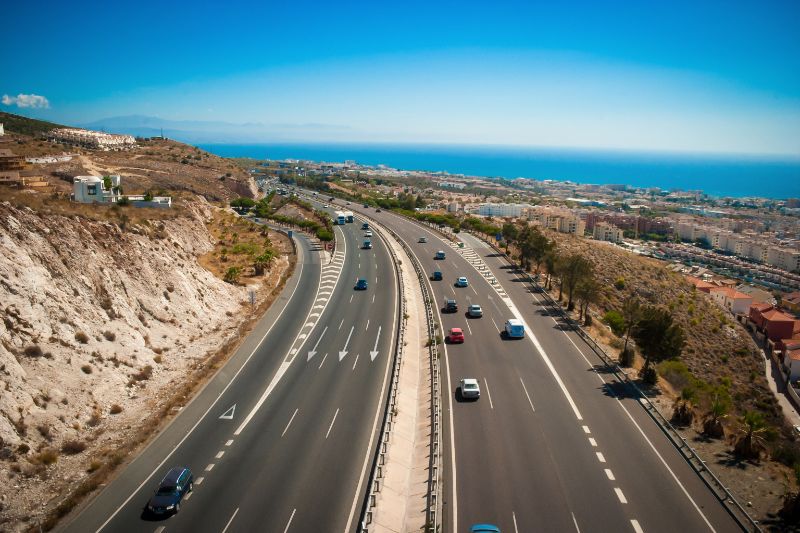
A part of the AP 7 near Malaga is now toll-free.
Staying overnight, camping and parking
You can’t just go ‘camping’ anywhere in Spain. Wild camping may be allowed under some conditions, and checks are not strict everywhere, but in principle, you’re only permitted to stay overnight at parking spaces designed for motorhomes, or at campsites or at vineyards or farms for example. Wild camping is not permitted at any of the national parks in Spain.
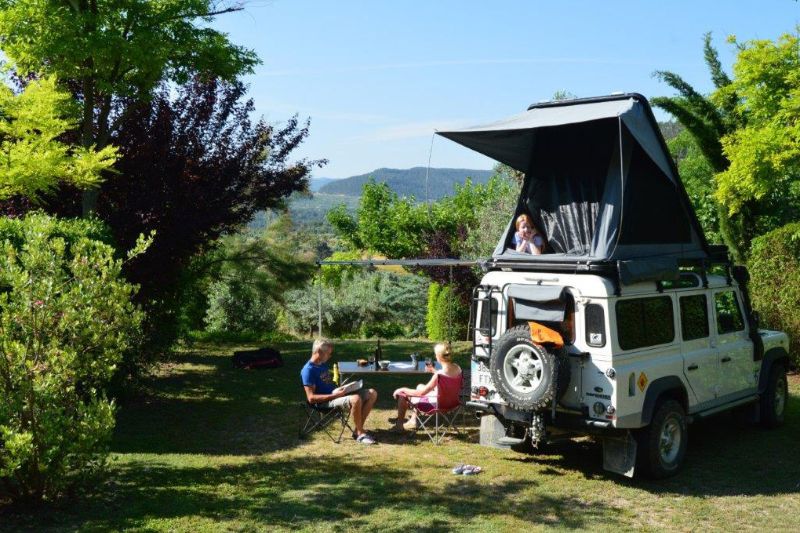
Stay at one of the beautiful small campsites in the spanish hinterland. (Photo: Campsite La Fresneda in Aragón)
Parking a motorhome is allowed anywhere, provided that the parking space is suitable and there’s no sign banning the parking of large vehicles. Eating and drinking and sleeping in a parked motorhome is fine (even cooking is fine), but you’re not allowed to convert a parking space into a ‘motorhome pitch’. That means that you can’t set up tables and chairs outside, that the awning must remain folded up, and that you can’t put up your TV dish. It’s also true that these rules are not enforced equally strictly all across Spain.
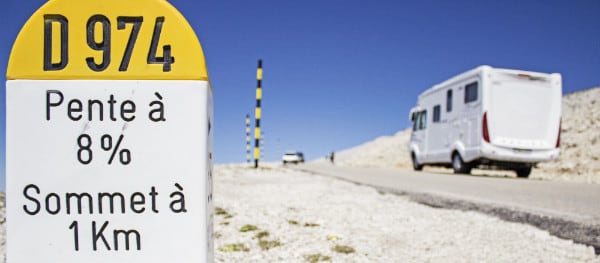
Driving with your motorhome through Spanish mountains
Uphill, downhill
The Spanish countryside is very diverse. From touristy beaches to the unspoiled hills, Spain has it all. If you’re driving through the hills in your motorhome, bear in mind that there are some traffic rules that differ from the normal rules. On slopes with more than 7% incline, vehicles going up always have priority over vehicles going down (unless the vehicle going up is close to a passing place), and on mountain roads, it’s mandatory to sound your horn on blind bends.
In areas like the Pyrenees and the Sierra Nevada, you can sometimes encounter wintery conditions. The use of snow tyres isn’t mandatory in Spain, but it is recommended for these areas in wintery weather. Snow chains may only be used on roads covered in snow or ice, and their use is mandatory if indicated by signs or by the police (maximum speed when using snow chains is 50 km/h). If you’re using studded tyres, the studs cannot protrude more than 2mm.
In Spain, motorhomes (<3500 kg) are seen as category 1 (M1) vehicles, and because of this, different speed limits apply to them outside of urban areas. A motorhome is not allowed to drive faster than 120 km/h in Spain. The following are the speed limits on Spanish roads.
Speed Limit in Urban Areas:
Effective immediately, a general speed limit of 30 km/h applies to most urban roads in Spain. The exact maximum speed in cities now depends on the number of lanes. On roads with two or more lanes in each direction, the speed limit remains unchanged at 50 km/h. On roads with a single lane for both directions, without a central road marking and with sidewalks at the same level (without a difference in height), the speed limit is 20 km/h.
Cars and Motorcycles:
- Within town: 30 km/h
- Outside town: 90 km/h
- Expressways: 100 km/h
- Motorways and Autovías: 120 km/h
Motorhomes up to 3.5 t:
- Outside town: 80 km/h
- Expressways: 90 km/h
Motorhomes over 3.5 t:
- Expressways: 80 km/h
- Motorways and Autovías: 90 km/h
Driving with kids in Spain
Children under 1.35 metres are not allowed to sit in the front, and are only allowed to sit in the back (in an approved and appropriately-sized child seat). Children who are taller than 1.35 metres are allowed to sit in the front and use a normal seatbelt. However, in Spain it is advised that children up to about 1.50 metres tall use an approved, appropriately-sized child seat or booster seat. Pets must either be restrained using a dog seatbelt, or they must be transported in a crate or box (of course, this should also be fixed somewhere so that it doesn’t move around in case of an accident). Neither passengers nor pets are allowed to walk around when the motorhome is moving.
Good to know
Finally, here’s some useful information and handy tips for those who are planning a trip to Spain:
- Spain has a number of environmental zones (including in Madrid and Barcelona) where only residents are allowed to drive. These zones are indicated with signs with the text ‘ Area de prioridad residencial ‘ and are only accessible for permit holders and drivers with special exemption (so don’t drive here in your motorhome!).
- In Spain, there are special petrol stations with additional amenities for motorhomes (Special Service Stations). For example, waste disposal for the toilet, water connections, and possibly technical help.
- Diesel ( gasóleo ) and petrol ( gasolina ) are easily available at petrol stations. LPG however is not easily available (the exception is in Madrid). See this list of petrol stations offering LPG in Spain.
- A warning triangle, a set of spare bulbs and reflective safety vests (for every occupant) are mandatory. Cars with Spanish registration plates must have two warning triangles on board.
- If you are carrying cargo (including bikes) you must have a warning sign of 50 cm x 50 cm.
- Drivers who wear glasses must have a spare pair with them.
- In Spain, it is not permitted to fill foreign gas cylinders. So, before you travel, search for a list of where you can buy gas cylinders and check what the exact rules are.
- Speed camera warnings for fixed speed cameras are allowed; radar detection devices are not allowed in Spain.
- The permitted amount of alcohol is 0.5 promille. Except for novice drivers who have had their licence for a maximum of two years; for them, the maximum amount is 0.3 promille.

What are your experiences of driving in Spain? Or do you have tips or suggestions for others? Then leave a comment under this message.
Want to stay informed with fun and useful camping news? Then sign up for the Eurocampings newsletter !
To always stay informed of the best offers and the newest selection, sign up for our newsletter and don't miss out!

- Author: Bram
- European cities, touristic beaches and impressive landscapes and countryside. As a European traveller, I have been to many places and I like writing about my travels so I can share my experiences and tips.
Other interesting blogs:
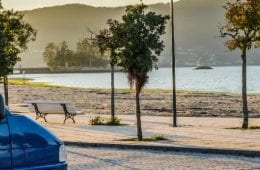
This is how you go on a haphazardly road trip through Europe!
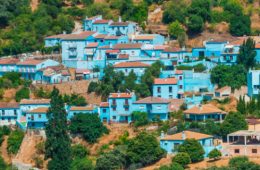
Long story short: Andalusia – Júzcar
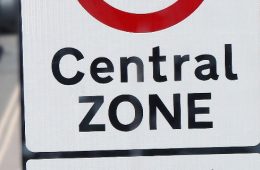
European Emissions sticker: regulations per country
40 comments.
Hi how are you? I hope we’ll. I wanted to know if you could help me with an enquiry:
I have a normal car driver license in Dubai, United Arab Emirates and I’m looking to visit Spain next month and rent a motor home less then 3500kg, is that an ok driver license to use?

Hi Nicolas,
A motor home less than 3,5 is ok for a normal car drivers licence in the EU. This is drivers license B. However, if you ar not an EU citizin, you need to obtain an international drivers permit to rent a car in Spain. You can find more information on this website: https://www.autoeurope.com/international-driving-permit-spain/ . Her is also some information: https://www.spain.info/en/travel-tips/driving-regulations/#ancla-1 I would advise you to apply as soon as possible. I wish you a great motorhome trip in Spain!
Kind regards, Marieke
will a Hymer motorhome be able to access narrow villages roads close to Huecija in Spain (Almeria)
That is entirely dependent on the van – mine can do narrow streets with relative ease but I’m always concious of the rear overhang and corners. Of more concern are the inclines, which it will do but with difficulty – normally in first – have you checked the route on the map for inclines? Where will you put the van when you get to where you want to go? Are you better trying to do it on a bike or even a rental car for the day?
I find sometimes it’s less stressful to leave the van behind and do the trail as a hike on foot!
Can I carry tin foods in my motorhome traveling to Spain
I am planning to visit Andalucia in a converted camper van, Sprinter type in September 2022. Can someone recommend books or resources for me to find cheap or free camping. Thank you
http://www.park4night.com is a very good source of information. Remember that in Spain generally, it is illegal to stay in the van anywhere other than the designated sites, and where you are, there are many, many tourist providers who don’t like motorhomes because you don’t have to pay for their hotel or campsite facilities! This means that wild camping can be difficult and even visiting a town can be challenging as your van may have no place to park – the dreaded bar across the carpark entrance!! proceed with caution!
In spain Is it legal to park my campovan which is not in use on a puplic road outside someone’s house
It has to be insured and ITV’d. We park ours outside our house on a public road, but it is a quiet area
Hello! Yes, you can park it provided it’s insured. The MoT (ITV) doesn’t have to be current as they can only do you if you are caught driving the vehicle. That being said, it is a good idea to have an ITV sticker that states the current year as it avoids problems with turbocharged neighbours – unless they lean in and inspect closely, any vehicle with a current year sticker ‘looks’ legal at a glance. The bigger problem is with neighbours who don’t like the look of your van and want it moved on – mine’s been spuriously blamed for damaging a car, causing damp in a garden wall, blocking the sun from windows, preventing people from crossing the street – the whole nine yards! Have to say that I don’t much like my neighbours!
Up in the mountains behind Málaga in the picnic areas, there is free water, we’ve used it many time, and it’s much nicer than the town
Thanks for that useful information. We’re thinking of relocating to Malaga after 20yrs in the Canaries and about to retire next year. After touring in a campervan, we are thinking to get a permanent place in the Malaga area ie a bit of land with a house.
Interesting guide for the motorhome rules, Thanks for sharing.
I have lived here for 20 years now and you state driving is the same as UK but on the opposite side of the road. The biggest difference is the right of way on a roundabout which is very different the outside lane can go left all the way around the roundabout and the person on the inside does not have right of way if someone is turning left and in the outside lane, the person on the inside lane would have to go around again. Many UK drivers get irate at Spanish drivers, beeping and shouting when they are the ones in the wrong.
Not entirely sure you’re correct about that – tho what you describe seems to be the default learning for drivers here. I think the left-hand lane practice conflicts with a rather confusing and seemingly incomplete attempt made by the Guardia Civil and the DGT several years ago to clarify the issue: https://www.diariomotor.com/dgt/normativa/decalogo-rotondas/ I try to drive as best I can like I learned how to do it in the UK, the one major difference that I can see is my using an indicator – there appears to be a national shortage of indicator bulbs here in Spain as drivers never tend to use them, particularly on roundabouts. You seriously would need a rapid-action crystal ball to work out the intentions of some drivers on larger roundabouts and – while Lulu may well be correct about the right of way – it defies logic to drive in the outside lane to perform a left turn at a two lane roundabout – what is the inside lane for then? Drivers who are lost and need a couple of spins to work it out?!!
Being retired, I would like to stay in Valencia for longer than 90 days, My residence will be a motor home on an official camp site, Question: will I be able to obtain a long stay visa to enable this?
Hi have left my Rv in Spain but need to bring it home can I travel to Spain to fetch it back to England
It is useful information for people to visit Spain. Thank you and keep it up!
I am wanting to travel around Lanzarote in a camper for 1 week, I have seen some places say it can be parked anywhere and then other say that they can only be parked on campsites, any ideas anyone?
We are going to move to Spain, and we are travelling there in our newly purchases Motor Home to explore the areas. How long are we allowed to stay in Spain before we have to leave with our vehicle. And how long is it before we can go back with our vehicle. We heard that you can only stay 9 Months before we have to take the vehicle out of the Country. Any advice anyone.?
We are currently in Spain with our motorcaravan and have been touring for 3 months, we have just been told by local person you only have 2 months before needing to take motor home our country. We will need to find out next week when offices are open but will let you knowcresukt.
My father is hoping to retire in Spain, he’d like to live in a motor home permanently. Is this not possible? Would he need to have a fixed address over there? Or live on a site with the motor home? Anyone have any updates or know of a informative website etc? Thanks
Regarding resident in Spain a years lease agreement for a rental property will do the job and owning a property is not compulsory.
So did you find out. I live in Spain but due to stupid Spanish laws I was hoping to take my motorhome over and leave 11 months later to not and then back again.
Why are they stupid?
By law in any EU country you may take a vehicle into another EU country providing it is road legal in the country of registration and remains so – meaning it must be taxed, hold a valid MOT, be insured; nor may you SORN it or declare it exported. You may also drive the car. However you must stay no longer than 6 calendar months and you must then remove the vehicle out of the EU country concerned. You are not allowed to renter that country for a period of at least 7 days. You may be asked to prove date of entry and exit. Your insurance may permit lo get periods – the law does not.
6 months in any eu land
Is there an upper age limit fur driving a camper an in Europe?
Are special tyres mandatary in spain
from my experience, if you have a tyre changed, their law is to have samne tyre on each side of the axle – ie, both front or both rear tyres, they cannot fit just one of a different make
This is correct.
My understanding is that you need TWO emergency triangles
Yes you do need 2 triangles
And at least one approved high visibility jacket preferably two that must be on before you step out of vehicle
Love Spain but can no longer go there until either they allow, or at least turn a blind eye, to my properly fitted, braked, A-frame towed car.
You can start going again, So long as the country you come from says its legal to have a A Frame, They have to except your country’s law in ref to the set up of your motorhome, you can download a legal text in Spanish stating the EU law, should you get stopped. enjoy!
Good site but nothing about watering the horse. I hang around Malaga since 2017 and l never found a free water for camper vans anywhere. This is so bad, nobody cares about the 1000′ of us who spend all our money in and around Spain without facilities.
There is always water in cemeteries with closes access (normally!!).
We have been staying in toromalenus right along Malagar end no charges we filled our water barrels and had shower on beach over road Mt toilet tank in manhole on park we stayed 5 weeks not posh 10 Starr rating
You will find you cannot use a A frame on UK plates as it is classed a third country now after brexit
Respond Cancel reply
Your email address will not be published. Required fields are marked *
Welcome to the ACSI Eurocampings blog
Do you also love going camping? Here you can discover our favourite tips for an unforgettable camping holiday. By campers, for campers.
Popular Posts

Latest comments
- Marieke on German emissions sticker: everything you need to know
- Andy Whysall on German emissions sticker: everything you need to know
- ann west on Camping packing list: mandatory items in the car when travelling
- John Williams on The best way to keep your motorhome or caravan’s water tank clean.
- Sue Long on The best way to keep your motorhome or caravan’s water tank clean.
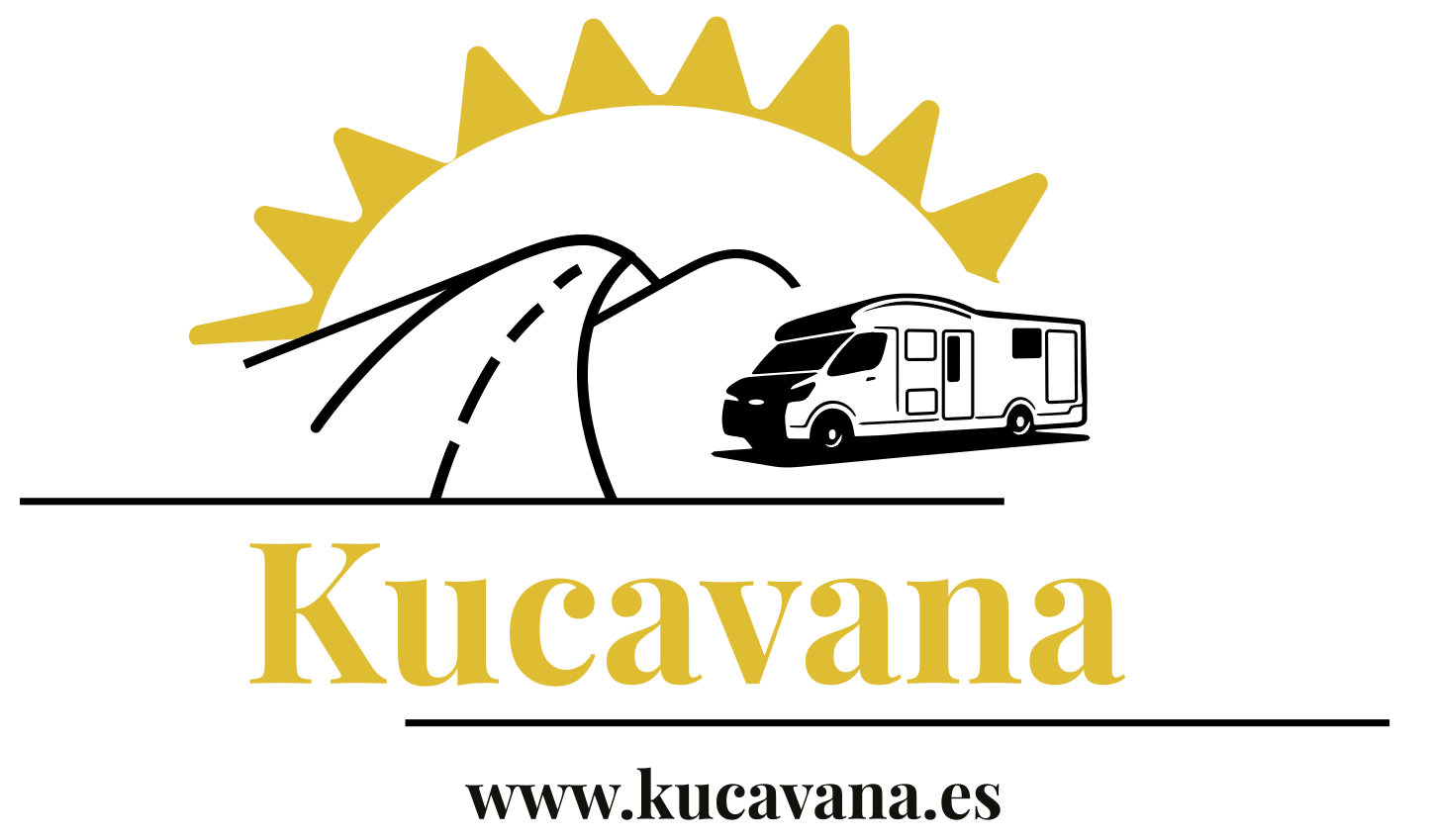
10 Routes through the North of Spain in a motorhome or camper
- Author of the entry: Kucavanera family
- Post publication: 30/06/2024
- Entry Category: Spain / Trips
- Post Comments: No comments
Table of Contents
Discover the best routes, specifically the 10 best motorhome routes in northern Spain. Motorhome and northern Spain in a motorhome, a great combination.
10 Routes through the North of Spain in a motorhome
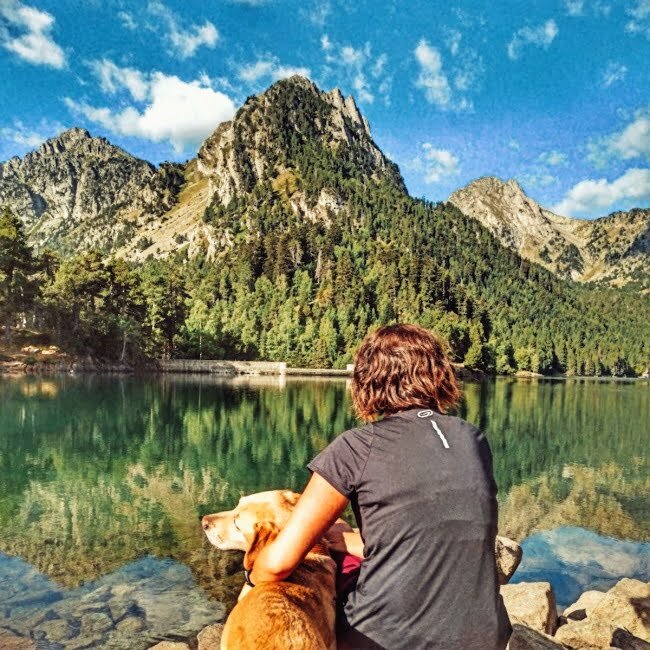
Plan and organize your trip to the north by motorhome in 5 clicks
- Plan your route well so as not to find surprises, we help you with our personalized route service with video call where we give you a personal masterclass
- 5% Discount on your health travel insurance by clicking here . The only travel insurance for motorhomes and campers that covers what vehicle insurance does not cover: replacement vehicle, interior theft, civil liability and accidents involving your pets, medical insurance and much more.
- Find and book activities at destination
- Buy what is necessary and useful for this trip by motorhome or camper: list of 50 things that we carry
We help you to set up your motorhome trip in a personalized way
If you do not have a motorhome and what you want is to rent one and start in this world, this is your service. Or, if you don't have time to organize your next motorhome or camper trip and you want someone to organize it for you with the utmost professionalism, this is also your service.
We advise, manage, solve doubts, give support and set up a route or organized trip in a motorhome personalized to your tastes and needs, so that you go calm, safe and your motorhome trip is unforgettable.
PRICE: Depending on the days of the organized motorhome trip to be assembled.
ACCESS HERE
ADVISE ON THE RENTAL
Route assembly personal, support on road.
The 10 northern Spanish routes by motorhome
Next, I show you 10 of the best routes through the north of Spain in a motorhome based on my own experiences. Beam Click on each image and you will be able to access the complete route and its detailed narration.
1 ROUTE MAGIC ROUTE THROUGH THE NORTH OF SPAIN BY MOTORHOME NORTH FROM EAST TO WEST
If, going along the coast, you go up to the north, you will be able to enjoy the Costa Brava with its thousand acts ivities to start this north motorhome route from east to west. We recommend certain coves that are not as crowded as Cristus Cove , with a cave from which you can go to the coastal path, La Cala has a direct bridge to the international campsite of Calonge , impeccable service and a huge campsite.
On a route like this you will be able to see and visit very magical places with a thousand activities to do.

2 THE TRANSPIRINAICA BY MOTORHOME OR CAMPER FOR 14 ROUTE DESTINATIONS IN NORTH MOTORHOME
Would you like to do a motorhome route through the north of Spain? What if it is a nature and mountain trip? How about a roadtrip through the Pyrenees full of activities ?
Below, we invite you to read about our experience on a 15-day trip with our camper van through the Pyrenees in a motorhome.
Click on the image below, remember, and access the full path.
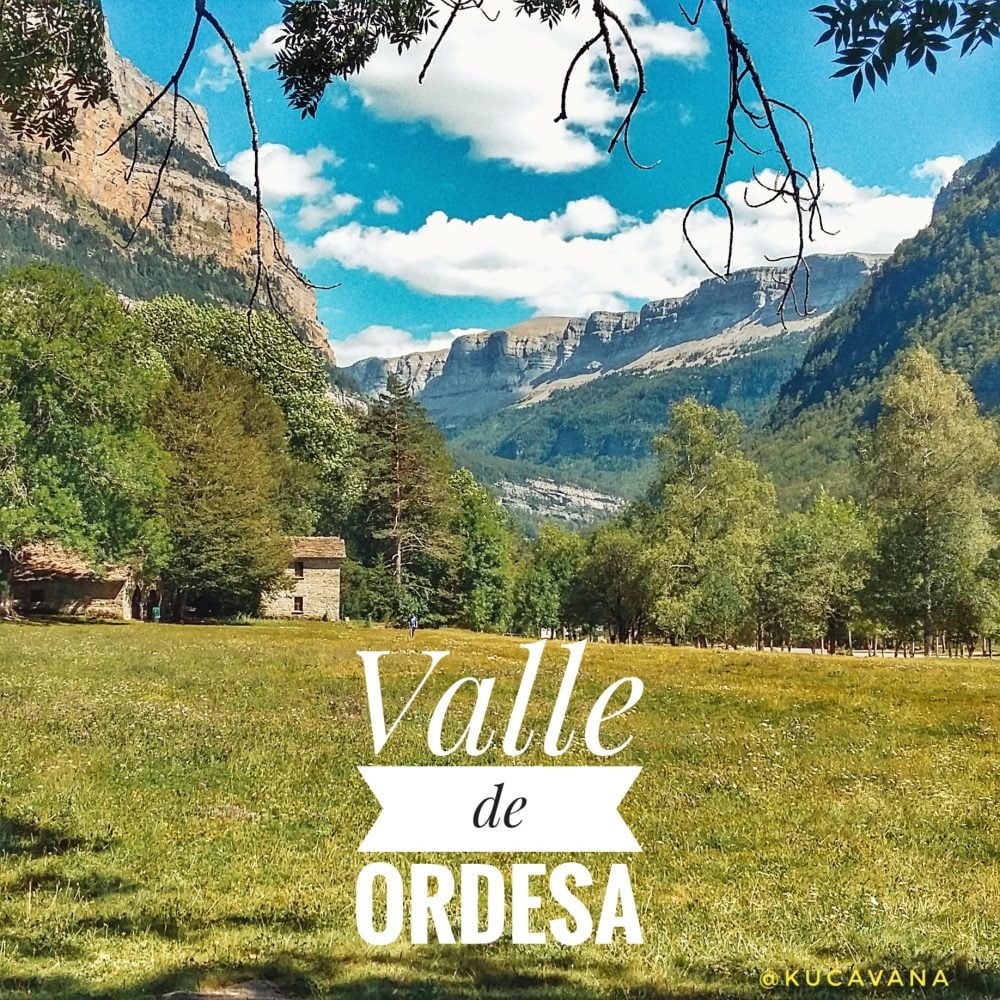
3 11 DESTINATIONS AROUND THE CATALAN PYRENEES IN CAMPER
For us, the Aran Valley was a little unknown, since we had been there but to ski and go through Vielha, but we did not know its towns or its mountains. Although we have to say, that we had many things left to see and visit….
Continue reading this route by clicking on the image below.
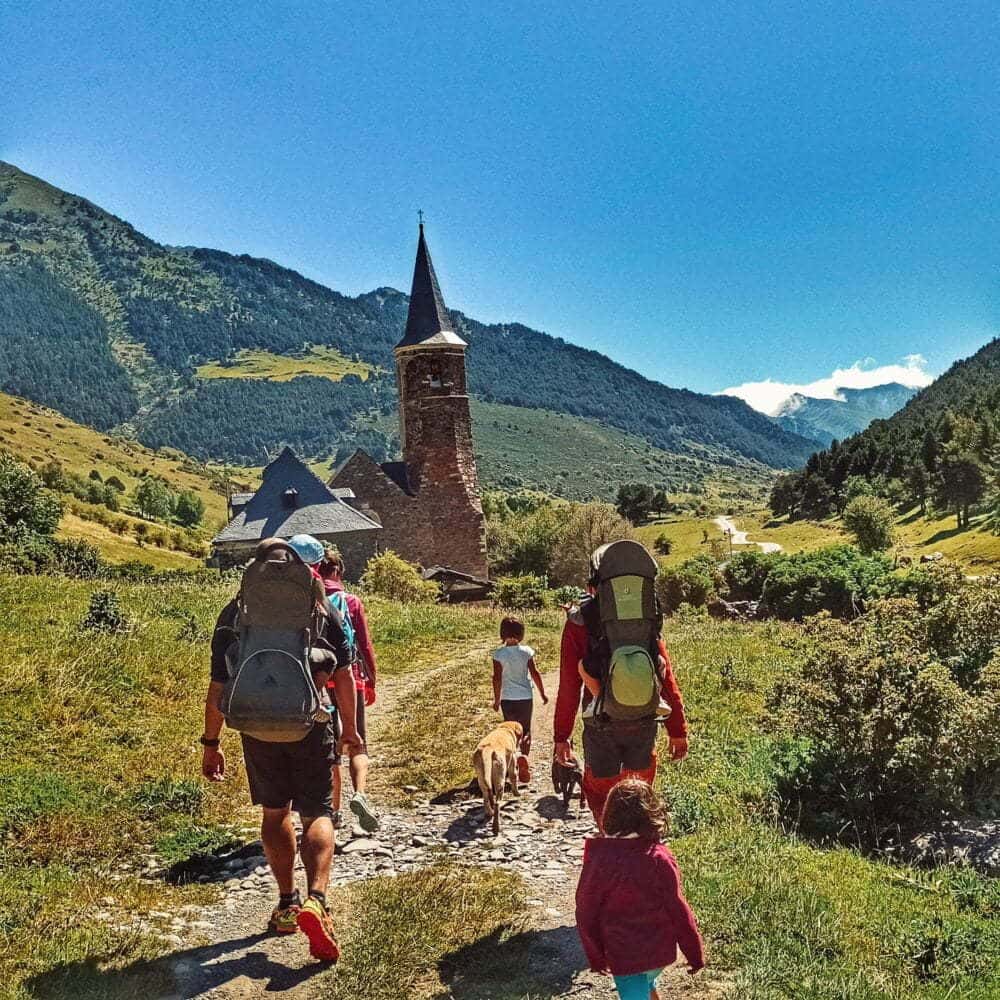
4 COUNCIL OF CABRALES IN ASTURIAS BY MOTORHOME OR CAMPER
If you go to this area an obligatory stop is the town of Camarmeña and Bulnes . It is a high mountain area full of routes, making it ideal for hikers and full of adventure and leisure activities what to do.
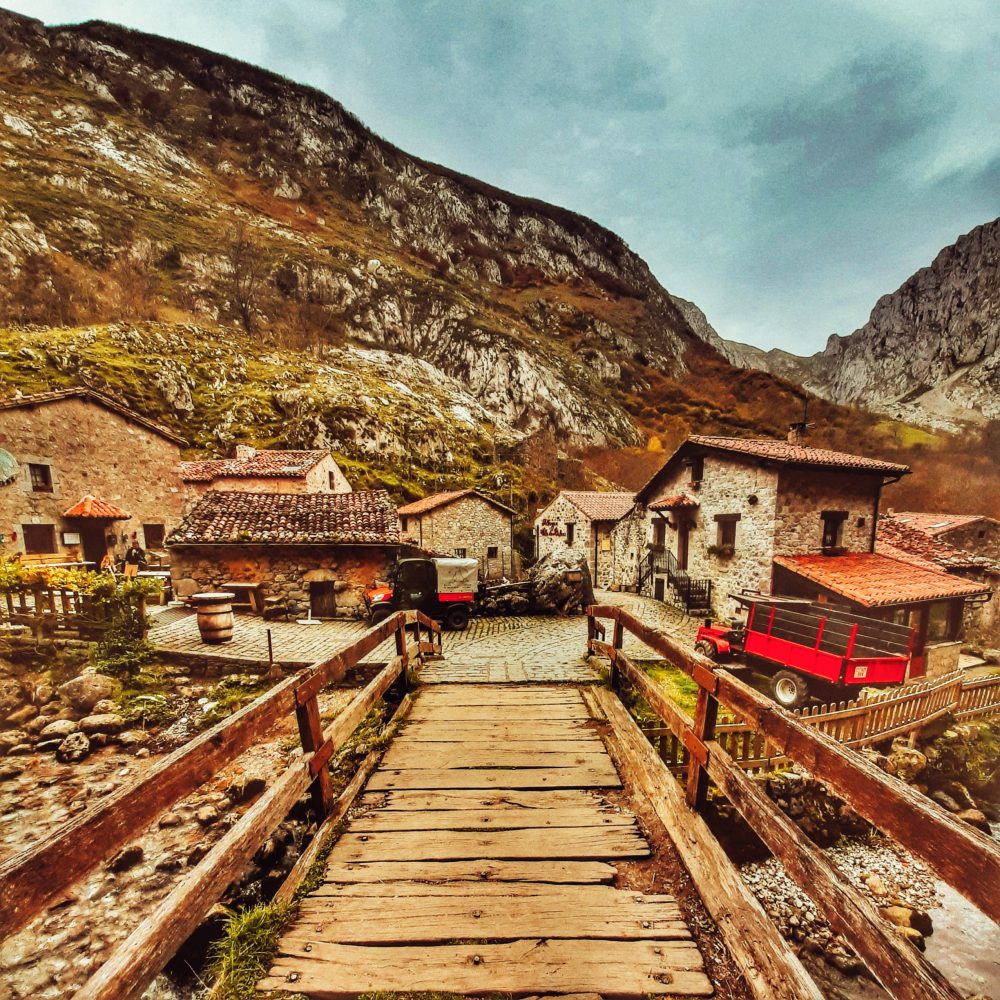
5 GETAWAY TO THE 2 BEST BEACHES IN CANTABRIA
Of all the trips we have made we want to recommend the one to Cantabria full of things to do , which has undoubtedly been one of the most incredible in terms of landscapes and gastronomy. And here our proposal is for a weekend getaway to Liencres for two of the best beaches that we set foot on in Cantabria by motorhome or van…
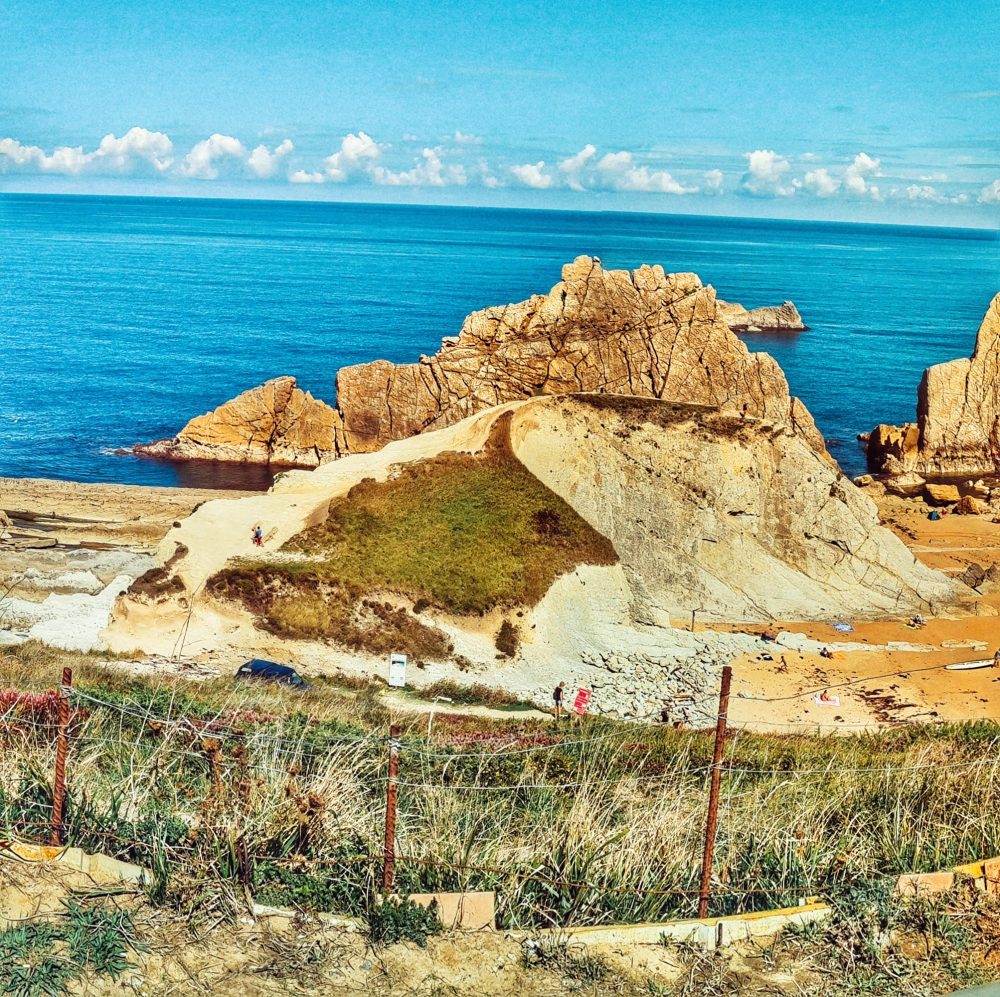
6 ROUTE THROUGH ANDORRA BY MOTORHOME
And now we will explain our entire route through these 6 essential things to do in Andorra in summer , without losing Caldea , on a trip Around Andorra in a camper van with or without children, in detail for each of these destinations...
Remember to click on the images to access the routes.
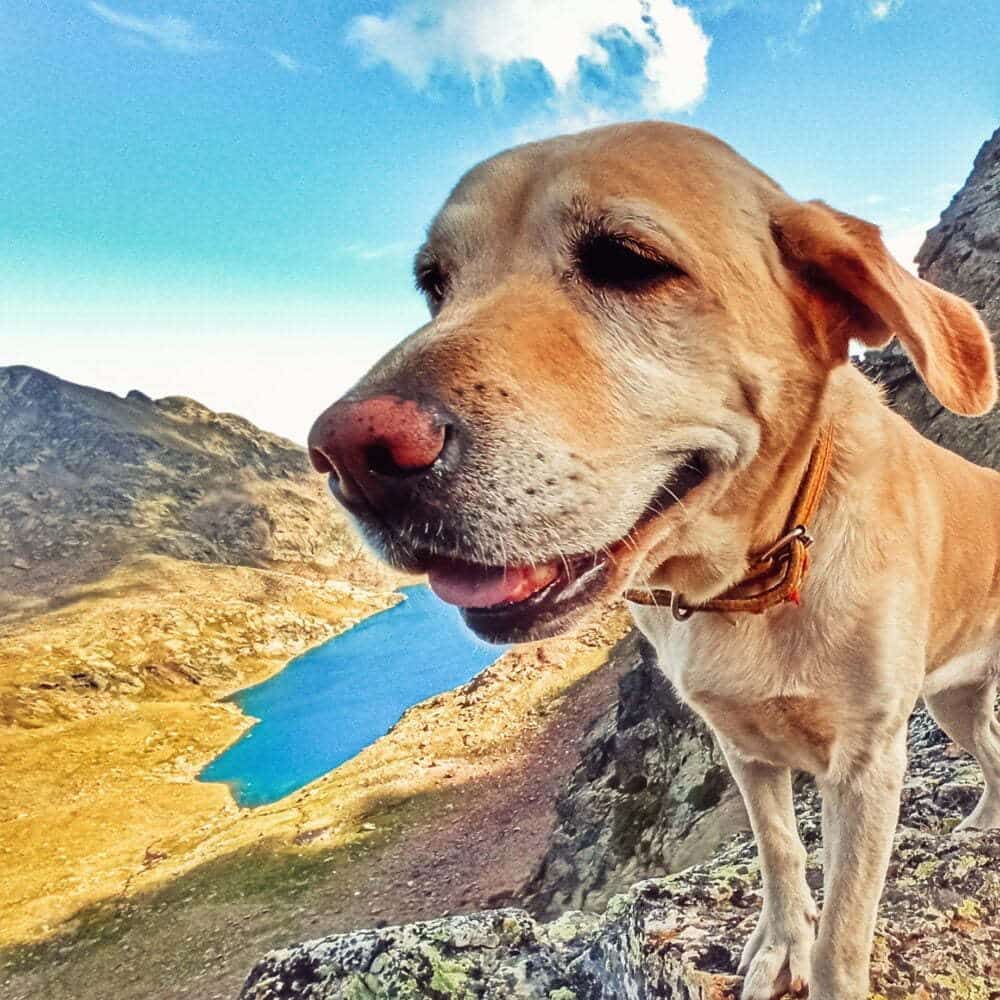
7 THE VALLEY OF TENA BY MOTORHOME OR CAMPER TO THE LONGEST ZIPLINE IN EUROPE
If what you are looking for is to enjoy the nature , incredible landscapes and eat well, el Pyrenees is always a good option .
Offers infinite activities for all tastes and today we want to show you some of them that can make your weekend wonderful ...
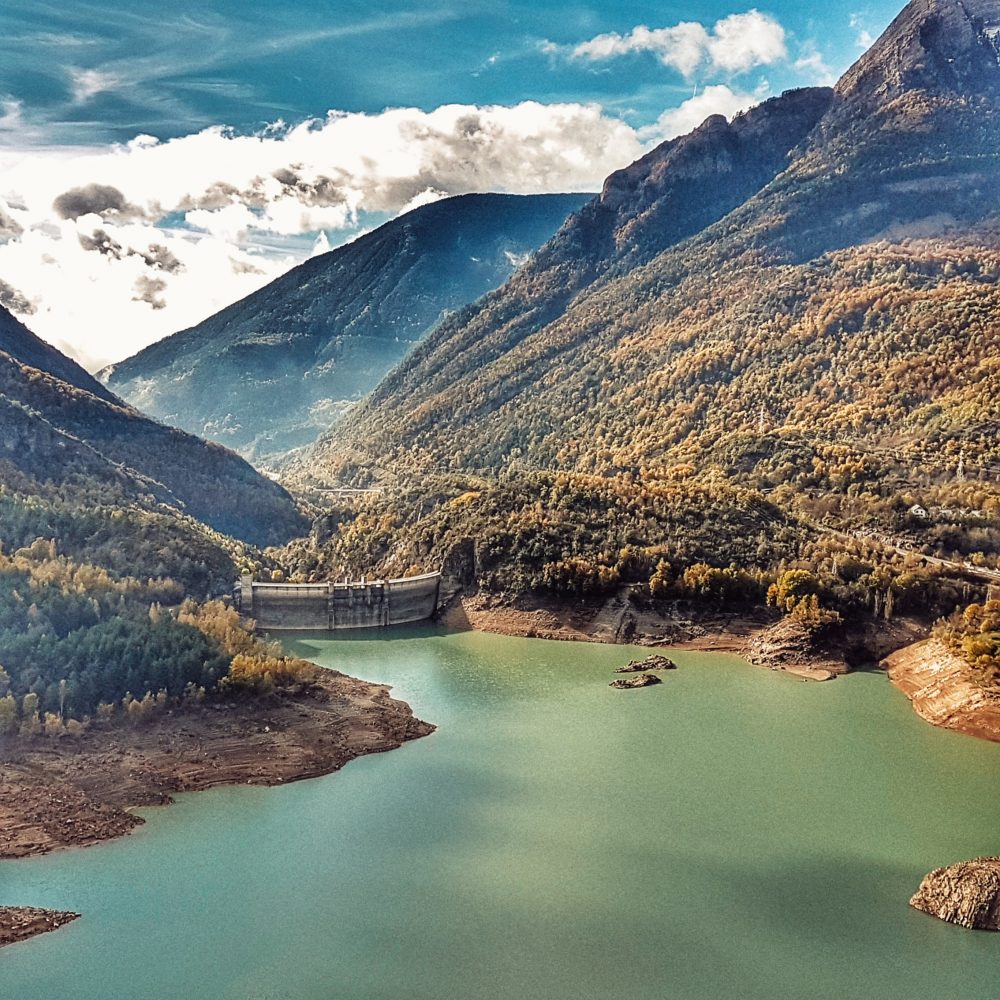
8 GALICIA BY MOTORHOME FOR 21 DESTINATIONS
Galicia in a motorhome is undoubtedly one of the great destinations for four-wheeled trips with the house on your back. A tourist route through Galicia in a motorhome or a trip to Galicia in a camper van is one of those adventures that motorhome drivers do not want to miss at least once in their lives...
Do not miss Islas Cies leaving your motorhome in Vigo or Cangas , ride on boat with tasting by the Vigo estuary and many other activities in Galicia by motorhome .
Access the full route by CLICKING on the image below.
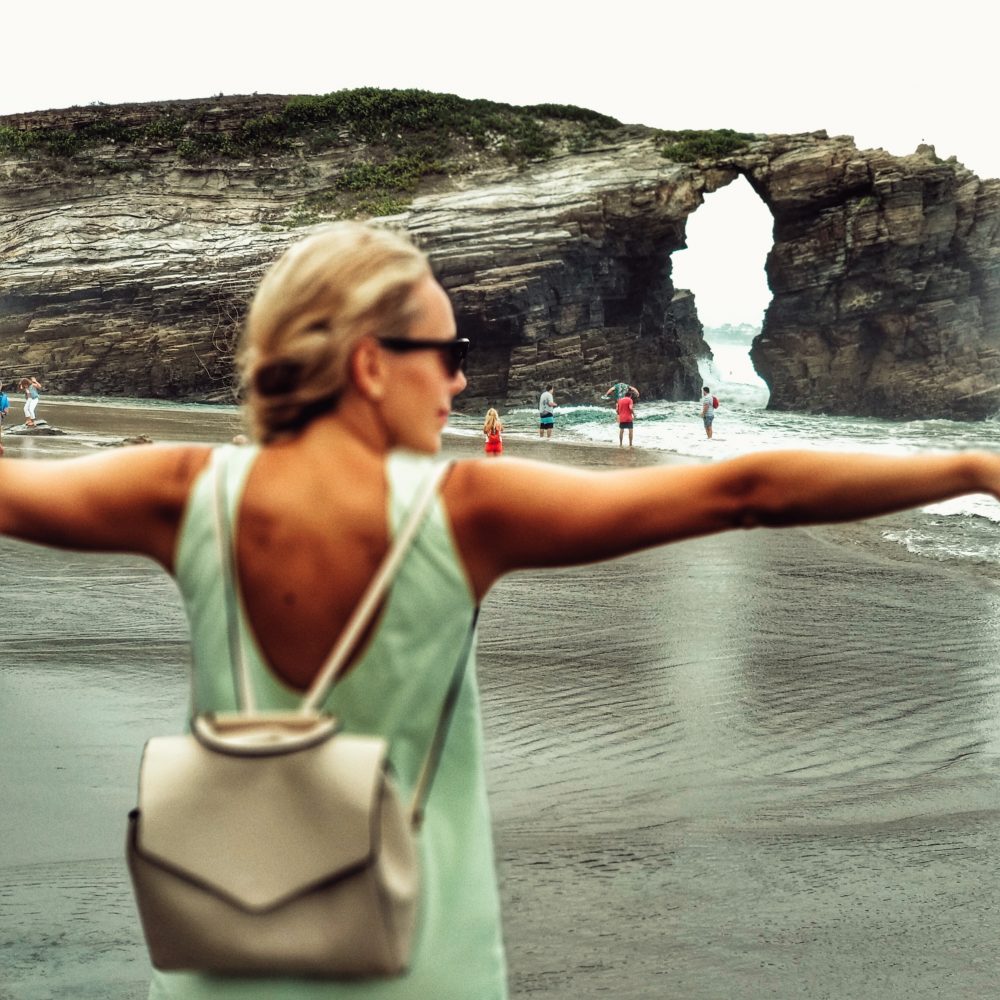
9 THE FRENCH CERDAÑA BY MOTORHOME IN 6 ESSENTIAL DESTINATIONS
We left Cerdanya, well, halfway, we moved to the French part to discover places on the other side of the Pyrenees. Some of the things that we highlight and recommend are ...
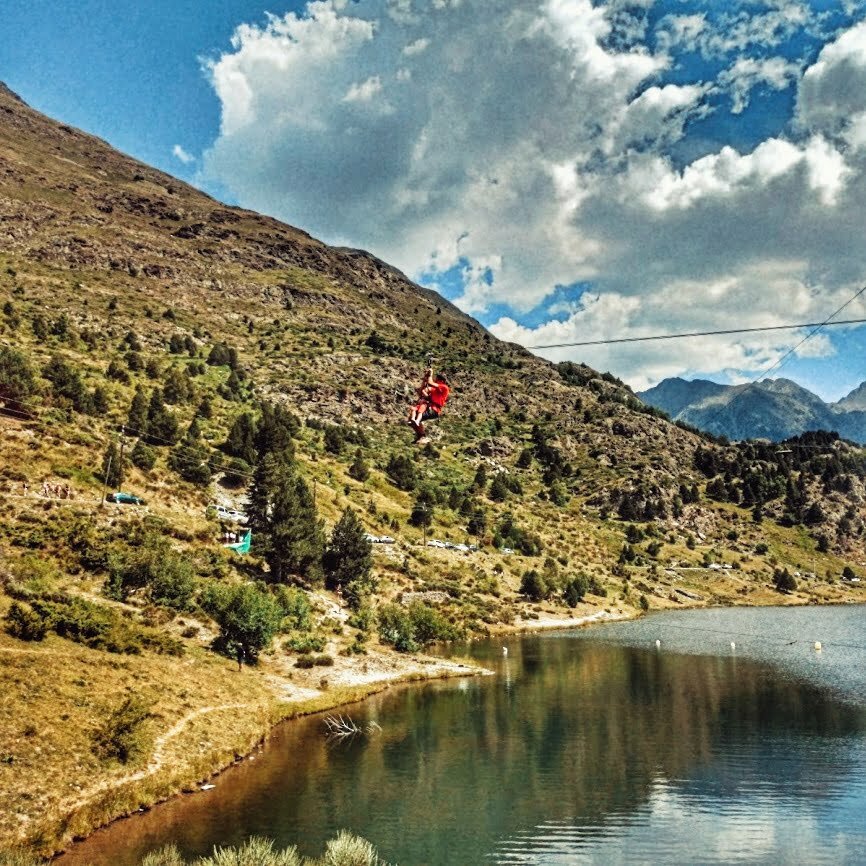
10 ROUTE THROUGH THE BASQUE COUNTRY BY MOTORHOME IN 7 DAYS
El The Basque Country in a motorhome or van is here no of activities and it is an explosion of wild nature, gastronomy and culture. One of those places that you should not miss on a route with a motorhome or campervan…
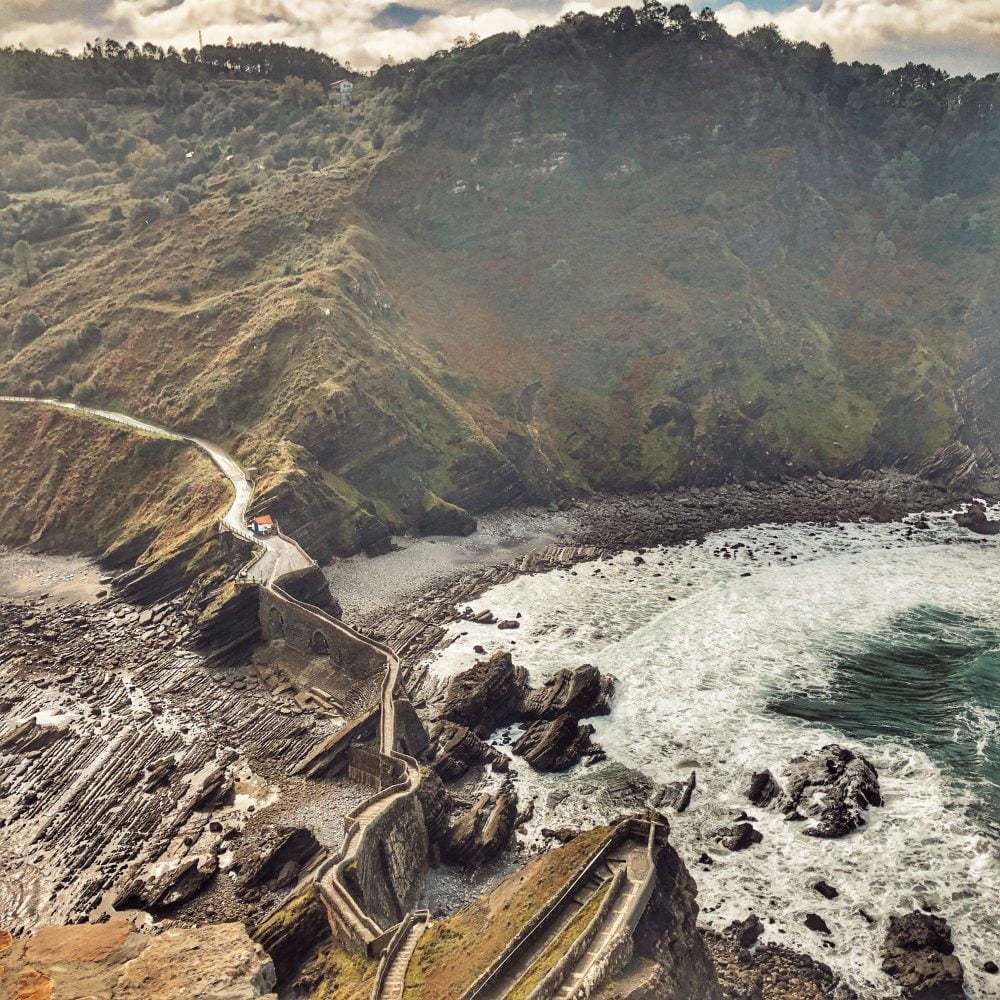
Route map and motorhome trips
Click on the map to see new routes and trips by motorhome or camper.
Blog search engine
Access the articles and content of our blog.
Other articles that may interest you
Manual for traveling in a motorhome, new motorhome areas for 2021, portugal and motorhome: goodbye to free overnight stays.
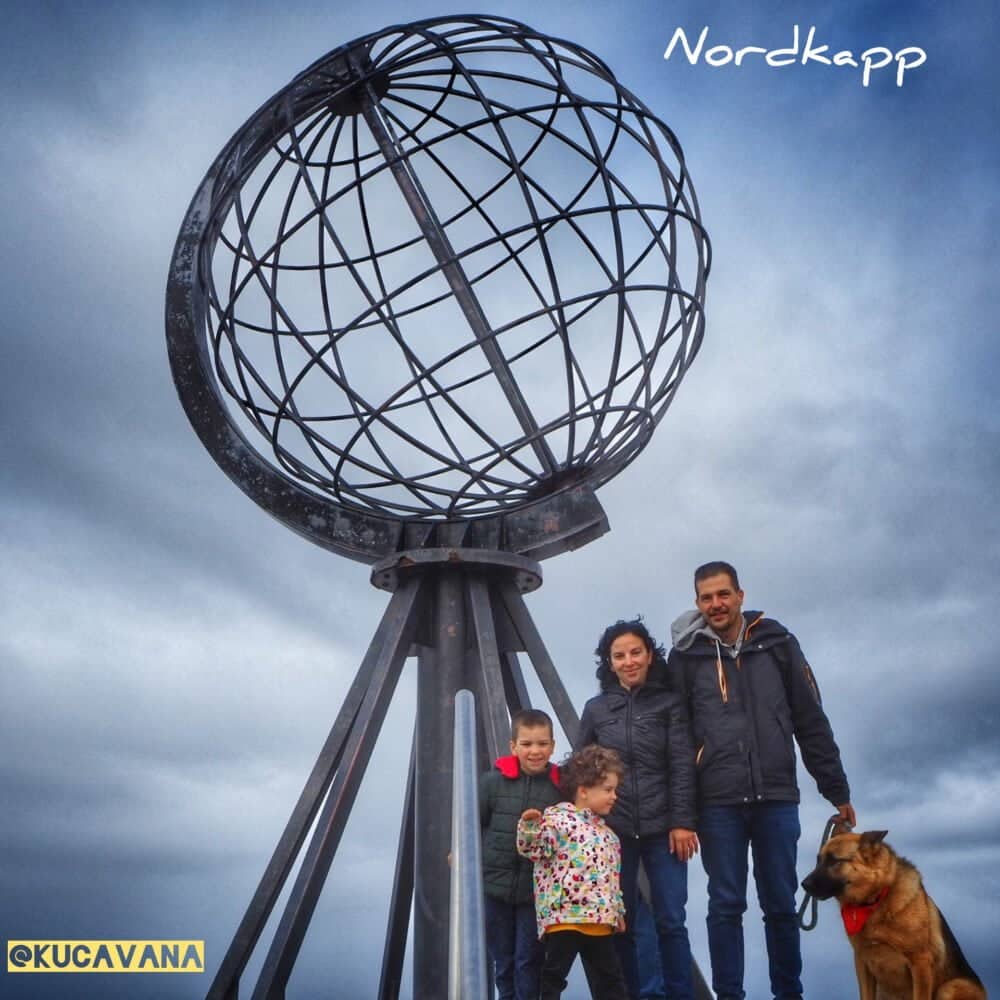
Don't miss anything
Receive every Friday, free of charge, in your email all the news from our blog.
Form action Subscribe Unsubscribe
Email address:
I have read and accept the terms and conditions
You might also like
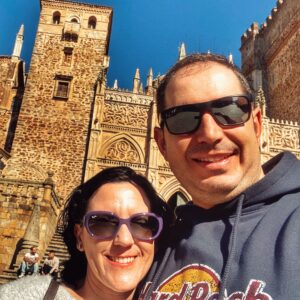
Extremadura in motorhome or van by Extremadura youtubers en route
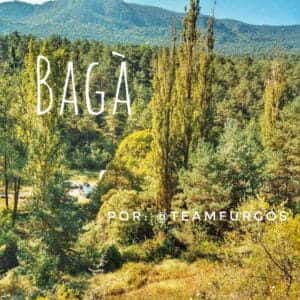
Bagà by van along the route of the Empedrats by @teamfurgos
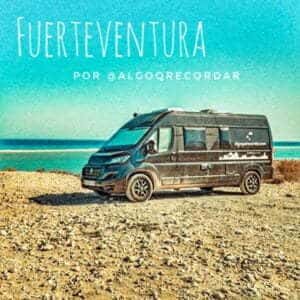
Fuerteventura in campervan by youtubers @algoqrecordar
Leave your comment cancel reply.
Subscribe to the mailing list!
To provide the best experiences, we and our partners use technologies like cookies to store and/or access device information. Consenting to these technologies will allow us and our partners to process personal data such as browsing behavior or unique IDs on this site and show (non-) personalized ads. Not consenting or withdrawing consent, may adversely affect certain features and functions.
Click below to consent to the above or make granular choices. Your choices will be applied to this site only. You can change your settings at any time, including withdrawing your consent, by using the toggles on the Cookie Policy, or by clicking on the manage consent button at the bottom of the screen.
Shopping Cart
Take your caravan or motorhome on the slow route to North-East Spain
An alan rogers suggested route.
We're often asked for suggested routes, and the way to Spain is one which crops up regularly. With this in mind, we've asked our campsite assessors to come up with their suggested route through France to the Catalan border. The following course assumes that you have already had a long journey to the Port of Dover or the Eurotunnel.
Day 0 - Calais/Coquelles to Escalles (23km/14m)
Exit the port on the N216 or follow the signs from the Eurotunnel and join the A16 south towards Boulogne. There is no toll in this section. For an overnight stop, exit at junction 40. Join the D243 westbound and pass through the village of Peuplingues. After the Escalles village sign, take the second turning on the left. Turn left at the green cycle route No.4 sign (to Wissant) on your left. The entrance to Camping les Erables (also known as Camping Maples) is then 400 m. on the left.
Day 1 - Escalles to Bonneval (371km/230m)

Retrace your route to join the A16 and continue south towards Boulogne. After junction 29 the toll starts. At junction 23 keep right to join A28 towards Rouen. There is no easy way through Rouen, and at weekends it can be very congested, so be patient. Continue on the A28 through the tunnels, following signs for Le Mans. After the 2nd, shorter tunnel, keep right as you cross the Seine, signposted Rive Gauche. Just after the river take the exit for the D18E (Quai Rive Gauche) and follow the road back around under itself. Continue on D18E to follow Le Mans signs with the railway line on your right, pass through several traffic light junctions. At the 2nd roundabout, with the Buffalo Grill opposite, take the second exit onto D18E.
Follow signs to Le Mans to eventually join A13 at junction 22 (no toll at this stage) follow signs Evreux. To avoid motorway charges leave A13 at the intersection onto A154/N154 signed Evreux. Continue on N154, past Evreux, until the junction with N12. Take the N12 towards Dreux. At Dreux follow signs for Chartres on the D828, eventually re-joining the N154 south. At Chartres take an anticlockwise route around the town on N1154 & N123. Leave at the D910/N10 exit, signposted for Tours/Blois. Continue on D910/N10 to Bonneval. For an overnight stop follow the sign to Bonneval and turn left at the crossroads in the centre of town, signposted camping (Dir. Orleans.) Join D27 then fork right onto D144 then right again onto C1. Camping du Bois Chievre is then on the right just after the swimming pool.
Day 2 - Bonneval to Chateauroux (211km/131m)

To return to N10, retrace your route to the centre of town, following the Toutes Directions sign at the main square. Turn left onto the N10 and continue to Vendome. Leave the N10 at Vendome, using the next junction after you cross the two branches of the River Loir, following signs to Vendome Z. I. Sud and join the D957 to Blois. At Blois, cross the A10 and take the 2nd exit to stay on the D957, entering the D956 towards Chateauxroux. Stay on the D956 past Contres, Selles-sur-Cher, Valencay and Levroux. For an overnight stop in Chateauroux, head to City Centre and pick up signs for Camping Le Rochat-Belle-Isle which is well signed. Signs for ‘Halls Exposition’ also take you to a recreational area where the site is next left after the municipal pool. Days 2 & 3 could be combined for a journey of 373km/232m
Day 3 - Chateauroux to Saint Germain Les Belles (162km/100m)
Retrace your route and join the A20 south at Junction 13 towards Limoges. For an overnight stop, just south of Limoges, exit the A20 at junction 41, following signs for Magnac-Bourg. Join the D31 when you see signs for Saint Germain Les Belles and follow the signs to the lakeside camping at Camping de Montréal .
Day 4 - Saint Germain Les Belles to Carcassonne (349km/216m)
Take the D7B to return to A20 at junction 42 and continue south to junction 68. Now join A62 south towards Toulouse. Here (at junction 15) it changes to become the A61. Continue on A61 towards Carcassonne junction 24. For an overnight stop, Join the N113 and pick up signs for La Cité. The site Camping de la Cité is well signed. Do not arrive between 12.00 & 14.00.
Day 5 - Carcassonne to Sant Pere Pescador (189km/117m)

Avoid the toll by taking D6113 towards Narbonne. From here you have the option of A9 toll road or D6009 which will take you to the Spanish border. For a first night in Spain (or even a more extended stay!) exit the E15 at Figueres (Junction 3) and join the N-11 south. Join the C-260, signposted to Roses, exit the C-260 at the 5th roundabout, taking the 2nd exit towards Sant Pere Pescador, joining the GIV-6216. Follow signs for Camping Las Dunas .
A suggested route through France, to Spain, for Caravans or Motorhomes
Sorry, this content can not be displayed.
The following consent is required: Required cookies, Functionality, Tracking & performance, Targeting & advertising.
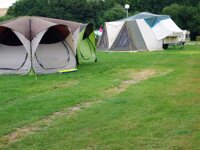
This campsite is now permanently closed.
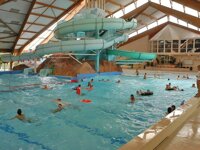
John Corrall
Lead Assessor
Former magistrate John Corrall and his wife Margaret now spend their days doing some judging of another kind – ensuring the campsites recommended by Alan Rogers are kept up to scratch.
Related Posts
Top 8 campsites in spain near barcelona, rob fearn | 26 feb 2021.

Escorted motorhome tours
Experience the ultimate road trip with Andytravelwriter’s Escorted Motorhome Tours. Discover breathtaking destinations, exciting excursions, shared meals and create memories that will last a lifetime!
Experience the Ultimate Motorhome Adventure
Embark on a journey through breathtaking destinations and iconic landmarks, all within the comfort of your own motorhome. We handle all the arrangements, from pet-friendly campsites to guided excursions and group meals. Relax, connect with fellow travellers, and immerse yourself in your adventure.
Detailed itinerary, ensuring an enjoyable experience.
Pet Friendly
All of our tours and campsites are pet friendly.
Exciting Excursions
Customized adventures, brimming with excitement.

Craft your next epic adventure: Explore an array of unforgettable journeys created just for you. With our fully Escorted Tours, every step promises breathtaking landscapes, vibrant cultures and unforgettable memories.
limited spaces
Go west, the live tour 2024.
- Northern Spain
Go West the Live Tour. 21 night escorted tour of Northern Spain.
Fully booked, join the reserve list, morocco feb 2025, 24 night escorted tour of morocco, the jewel of north africa., costa verde adventure 2025.
- Northern Spain & Portugal
14 night escorted tour of Northern Spain and Portugal.
Coming soon, ask for more information, go west, the live tour 2025, fully booked, morocco nov 2025, morocco 2026, completed tours, tour completed, testimonials.
Read what our customers have to say about their experience
Hi! I’m Andy Mckettrick, the bestselling author of ‘Go West’ – A handy guide to visiting Northern Spain in a Motorhome and ‘Flip Flops & Falafel’ – A handy guide to visiting Morocco in a Motorhome.
I was born within sight of The Shankly Gates, Liverpool and after a decade as a Joiner, nine miserable years as a Driving Instructor and ‘way too long’ running a B&B in North Wales, I relocated to Cantabria in Northern Spain. Having discovered my lovely Gordi in a Spanish wheelie bin over 9 years ago, we’ve been travelling together, virtually full-time throughout Europe and North Africa.
Our original trip was meant to last around 5 weeks but we didn’t return home until 18 months later! Once home, I knew I couldn’t go back to my old life. I wanted to travel. I wanted to make this our life. Three months later, Gordi & I were back on the road again and we haven’t stopped writing and travelling since.
I now offer fully escorted Motorhome Tours that are well organised, exciting and reliable with clear information and you even have your own dedicated European checklist for a seamless experience.
I’m really excited to talk through any part of the tour you’re interested in prior to your booking via phone or video call. This also gives you a good opportunity to meet Gordi and me!
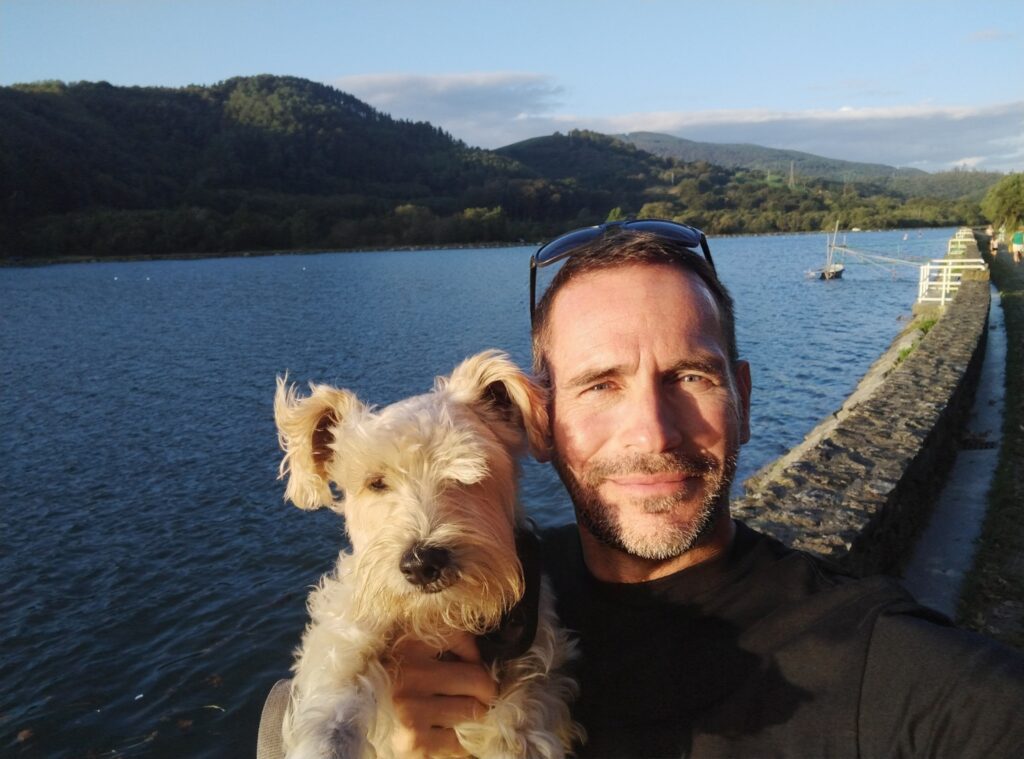
Embark on an unforgettable adventure
Embark on your next grand adventure: Dive into an assortment of unforgettable expeditions tailored exclusively for you. Our handpicked tours guarantee awe-inspiring scenery, rich cultural encounters and timeless memories with each and every stride.
Amazon Nº.1 Bestselling author
Skip the crowds, embrace the real. Hike to starlit vistas, sunrise awakenings, and campfire feasts in your rolling haven. Andy’s guides unlock epic adventures, all wheels welcome.
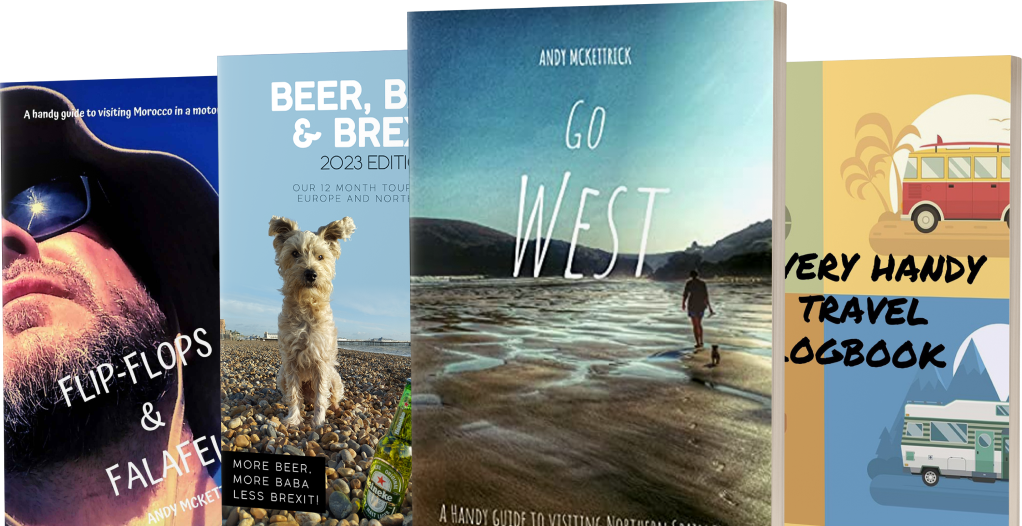
Embark on an unforgettable motorhome adventure with our fully organized and reliable tours. Contact us today for more information!
- +34 693803418

I would like more information
- Sign up\Login

15x the most beautiful motorhome stopovers in Spain to spend the winter
Area malaga beach, málaga.
Motorhome stopover Area Malaga Beach is located just a stone's throw away from the centre of Málaga, which is in the south of Spain. Here you can admire the beautiful Alcazaba, a former Moorish fortress that was built in the 11th century. Another famous attraction is the Gibralfaro Castle. This castle is close to the Alcazaba for a reason, as it was built to protect the fortress. At Area Malaga Beach you have almost all facilities such as electricity, sanitary facilities and the possibility to fill up and empty water. You overlook the beach and can therefore take a nice evening walk with a view of the setting winter sun. From the camper place also start several walking- and cycling routes through the beautiful Spanish surroundings. Discover even more beautiful Spanish beaches during your campervan trip. These beaches are among the most beautiful in the country.
Paraiso Camper, Calpe

- From the motorhome stopover you have a view of the beautiful Peñon de Ifach rock.
Camper Area Milucar, Torrox-Costa
In Andalusia's Torrox-Costa you will find Camper Area Milucar . Here you will spend the winter with a beautiful view of the sea. You can also spend a nice day out fishing. Or discover the surroundings via one of the many walking and cycling routes that pass by the camper village while enjoying the Spanish winter sun! There are various facilities at the campervan site. Wifi, the possibility to fill up and empty water and to clean the chemical toilet are included. You can also use electricity and sanitary facilities.
Valencia Camper Park, Valencia
Area camper massis del montgri, bellcaire d’empordà, area autocaravanas tropic, castell de ferro, playa altet, alicante, san antonio camper park, altea.
At San Antonio Camper Park you will spend the winter on the promenade of Altea on the Mediterranean coast. Here you can go for a nice walk along the coastline and recover after your walk with a drink on the terrace in the nearby marina. You can also head towards the Parque Natural de la Serra Gelada y su entorno litoral and discover the beautiful coastline on a walk. Or discover the charming old town of nearby Benidorm. Here you can admire, among others, the old church of Benidorm, Església de San Jaumu i Santa Ana, and the special apartment complex Intempo. This building is in an impressive N-shape. At the campervan site, almost all facilities such as electricity, sanitary facilities and wifi are available. During your campervan trip to Spain, you should also visit these five beautiful sights , which include the medieval city of Cuenca and the Segovía aqueduct.

- From the motorhome site in Altea, you can discover nearby Benidorm in no time at all.
Camperpark Carboneras, Carboneras
Autocaravaning park roses, roses.
In Roses, which lies close to the border between Spain and France, you will spend the night just outside the centre. Roses used to be a real fishing village. Nowadays, you can still enjoy the most delicious fresh fish from the port every day. There is 4 kilometres of beach, so you can take a nice walk along the water of the Bay of Roses. A few kilometres from the village you will find the ruins d'Empúries. This was already a commercial city in the time of the Greeks, and also in the time of the Romans, trade was conducted here in abundance. On the camperstop , almost all facilities are available, such as sanitary, electricity, wifi and the possibility to fill up or discharge water.
Las Moreras AC, Alcossebre

- During the winter months, you can enjoy a nice walk or bike ride in Alcossebre.
Area de Alcaidesa Marina, La Línea de Concepción
Monumento a colón, huelva, camper park playas de luz, isla cristina.
In Isla Cristina, on the border of Spain and Portugal, you will spend the night at Camper Park Playas de Luz . From the camper park you can start a walk or bike ride through the nature reserve Marismas de Isla Cristina. The area consists mainly of marshes. If you prefer the water, you can easily rent a kayak. You can hire bicycles at the campsite to explore the area. There are also facilities available such as sanitation, electricity and the possibility of filling and emptying water.
EmpordArea, Palamos
In the Catalan Palamos you spend the night at the camperstop EmpordArea . From the camper village you discover this cosy port town. You can enjoy the most delicious freshly caught fish and a walk along the bustling harbour. There are several beautiful beaches nearby that you can visit during a walk or bike ride. Routes start near the camper van site. In addition, you can spend a nice day fishing at a short distance from the camper village. On the campervan site, facilities such as sanitary facilities, electricity and wifi are available.

- Palamos is a cosy harbour town that you discover from motorhome stopover EmpordArea.

10x de beste camperplaatsen om het noorderlicht te zien!
Het noorderlicht zien is een droom van velen… Wat als we je vertellen dat je dit natuurfenomeen ook heel gemakkelijk kan bewonderen vanuit je camper! Er zijn een heleboel camperplaatsen waar jij van de prachtige ‘’aurora borealis’’ kunt genieten. Benieuwd welke camperplaatsen dit zijn? Lees dan snel verder!

Weekendje weg in Slagharen: de leukste tips + overnachten!
Slagharen is een dorp in de gemeente Hardenberg, gelegen in de Nederlandse provincie Overijssel. Velen zullen dit dorp kennen vanwege het bekende attractiepark, maar wist je dat er hier nog een legio aan andere leuke activiteiten te vinden is? Dit stukje Nederland leent zich perfect voor een weekendje (of midweek) weg. Ben je benieuwd wat er hier allemaal te beleven valt en waar je kunt overnachten met de camper? Lees dan snel verder!
De omgeving van Slagharen is ontzettend mooi en dat komt met name door het nabijgelegen Vechtdal. Door dit prachtige dal stroomt de Overijsselse rivier de Vecht. Deze rivier ontspringt in Duitsland en eindigt, na 60 kilometer door Nederland te hebben gelopen, in Zwolle.
Eigenlijk bestaat de gemeente Hardenberg uit talloze pittoreske dorpen die in het Vechtdal liggen, waarvan Slagharen er dus één is! Je vindt in deze groene gemeente maar liefst 13 (!) verschillende natuurgebieden. Dit betekent dat er hier talloze fiets- en wandelroutes zijn, maar aangezien de rivier de Vecht door het gebied stroomt kun je deze prachtige regio ook goed vanaf het water ontdekken!
Wandelen en fietsen
Zoals we eerder al gezegd hebben, zijn er een heleboel mooie fiets- en wandelroutes te vinden in deze regio. Ga bijvoorbeeld wandelen in het natuurgebied Collendoorn. Dit natuurgebied was tot 1988 een vuilnisstort en is sindsdien beplant, wat het nu tot een prachtig en bijzonder wandelgebied maakt.
Als je nog wat meer van de omgeving wilt zien, kun je een rondje door Rheeze wandelen. Dit dorp is een échte boerengemeenschap en tijdens je wandeling kun je op verschillende plekken stoppen voor een bakje koffie of een lekkere lunch! De wandelroute is 12,8 kilometer lang en duurt ongeveer 3 uur.
Ben je liever op de fiets onderweg? Dan kom je in gemeente Hardenberg ook zeker aan je trekken! Fiets het rondje Hardenberg – Breeze , een mooie fietsroute langs en over de Vecht van zo’n 43 kilometer lang. Een andere mooie fietsroute in deze regio is de Paarse Loper Lemelerberg . Deze route loopt door het Nationaal Park Sallandse Heuvelrug en is goed voor 3,5 uur plezier op de fiets.

- Ontdek de prachtige natuur van de Sallandse Heuvelrug met de fiets! © Ellen van Doel
Op pad met het hele gezin
Slagharen is ook een fantastische plek om met het hele gezin op vakantie te gaan! Leef je uit in Attractiepark Slagharen, een prachtig attractiepark met spannende achtbanen en nog veel meer andere attracties. Jong of oud: iedereen vermaakt zich hier.
Heb je zin in iets lekkers? Ga dan met de hele familie naar IJshoeve Bosman. In deze ambachtelijke ijssalon wordt boerenijs gemaakt van dagverse melk in heel veel verschillende smaken. Het water loopt je al in de mond wanneer je binnen komt lopen!
Net even wat anders
Ben je op zoek naar die ene activiteit die nét even wat anders is? Ook dat kan in Slagharen en omgeving! Zo kun je bijvoorbeeld gaan kanoën in de Hardenbergse wildwaterbaan, de eerste waterbaan van Nederland die gebruik maakt van het natuurlijke verval van een rivier. Dit is echt een bijzondere ervaring!
We snappen het als je toch liever iets rustiger aan doet, daarom raden we je ook aan om eens een kijkje te nemen in de tuinen Mien Ruys. Dit is een walhalla voor iedereen die houdt van tuinieren! Je vindt hier namelijk maar liefst 30 verschillende tuinen die allemaal even mooi zijn.
Overnachten
En, heb je al zin om naar Slagharen te gaan? Verblijf tijdens je weekendje weg bij Camperplaats Slagharen Bembom Hoeve . Deze gezellige camperplaats is het perfecte uitgangspunt voor alle bovengenoemde activiteiten en is ook een hele fijne camperplaats om te verblijven. De camperplaats ligt op een hoeve die zich bezighoudt met het fokken, showen en de verkoop van het Arabisch Volbloed Paard.

- Camperplaats Slagharen Bembom Hoeve.
Camperplaats Slagharen Bembom Hoeve heeft 15 camperplaatsen en 3 sanitaire units met ieder een douche, wastafel en verwarming. Aan faciliteiten dus geen gebrek! Aan het einde van de dag zie je de zon ondergaan vanaf de camperplaats, wat zorgt voor de allermooiste foto’s. Daarnaast is dit het perfecte moment om even uit te rusten en de schoonheid van de omgeving op je in te laten werken.

- Geniet van de zonsondergang bij de camper op de Bembom Hoeve!
De camperplaats is het hele jaar geopend en je verblijft hier al voor maar €20 per dag (incl. 2 personen)! Dus, waar wacht je nog op? Ontdek de prachtige omgeving van Slagharen en ga genieten op Camperplaats Slagharen Bembom Hoeve !
Ontdek meer...
Overnachten | Wandelen en fietsen | Natuur

Gerelateerde producten

Facile-en-Route Campergids Europa
(Detail-) informatie over honderden camperplaatsen door o.a. Italië, incl. reis- & routetips!

Capitool reisgids Nederland
Inspiratie voor je camperreis door Nederland.

150 mooiste camperplaatsen in Nederland
Deze handzame campergids bevat de 150 mooiste, leukste en meest bijzondere camperplaatsen in Nederland.
Wat is het noorderlicht?
De dansende, felgekleurde lichten in de nachtlucht, beter bekend als het noorderlicht, fascineren mensen over de hele wereld. Het is ook niet gek dat ''het noorderlicht zien'' bij veel mensen een plek op hun bucketlist inneemt. Maar waar komt het prachtige natuurfenomeen eigenlijk vandaan?
Heel simpel gezegd: het noorderlicht ontstaat wanneer elektrische deeltjes van de zon botsen met de atmosfeer van de aarde. Dit gebeurt het hele jaar door, wat betekent dat noorderlicht eigenlijk altijd aanwezig is. Het moet echter donker zijn om het noorderlicht goed te kunnen zien, daarom is de donkere winterperiode – en in het bijzonder de poolnacht – de perfecte periode om het noorderlicht te zien. Daarnaast is het ook erg belangrijk dat je naar afgelegen gebieden reist. Hoe minder lichtvervuiling van de stad, hoe groter de kans dat je het noorderlicht zult zien!

- ''Het noorderlicht zien'' staat bij veel mensen op hun bucketlist!
Het noorderlicht in Noorwegen
Het noorden van Noorwegen is in de wintermaanden het grootste deel van de dag donker, perfecte omstandigheden om het noorderlicht te zien dus! In het noorden van het land vind je camperplaats Sommarøy , waar je op een klein eiland verblijft. Iets noordelijker ligt Oksfjord Båtforening , een camperplaats bij een jachthaven. Hier heb je een hele grote kans op het zien van het noorderlicht!
Wil je niet zo noordelijk reizen? Dan heb je in Trondheim nog een redelijke kans om het noorderlicht te zien, mits de omstandigheden perfect zijn. Zorg dat je jezelf buiten het stadscentrum begeeft, hier heb je namelijk het minste last van lichtvervuiling. Klæbu, gelegen op 30km afstand van de stad, is één van de beste plekken om het noorderlicht te zien in de buurt van Trondheim. Vanaf de camperplaats Sandmoen Bobilparkering ben je binnen no time in het prachtige landelijke gebied.
Eeuwig aurora in Finland
Nergens is het noorderlicht zo lang te zien als in Fins Lapland. Van augustus tot april kun je de aurora borealis hier bewonderen. Als je geluk hebt kom je tijdens je vakantie in Fins Lapland het noorderlicht ''gewoon'' tegen.
BestPark Arctic Circle ligt, zoals de naam al zegt, vlak bij de poolcirkel. Bij deze camperplaats verblijf je middenin Fins Lapland. Iets naar het zuiden ligt Aneen Loma , een camperplaats aan het water. In de buurt van de camperplaats kun je allerlei outdoor activiteiten ondernemen, zo kun je bijvoorbeeld skiën in de omgeving van deze camperplaats. Één ding is zeker: het noorderlicht zul je hier in de winter zien!
Helemaal bovenin Finland vind je Nomadic Naali , waar je met je camper middenin de wildernis verblijft. Naast het zien van het noorderlicht kun je hier ook husky-tochten maken, onder begeleiding van de lieve honden van de camperplaats. Ook kun je op avontuurlijke tocht met de kano, om de omgeving nog beter te leren kennen! Let op: deze camperstop is geopend van medio mei tot medio oktober. Je kunt dus wel het noorderlicht zien, maar dit is maar tijdens een beperkte periode.

- Bij Nomadic Naali kun je tochten maken met de liefste husky's!
Een authentieke noorderlicht-ervaring in Zweden
Beleef een authentieke noorderlicht-ervaring in de noordelijkste regio van Zweden! In Zweeds Lapland heb je van september tot maart kans om het noorderlicht te zien. Sterker nog, in deze regio laten de kleurrijke lichten zich bijna dagelijks zien! Daarnaast is Lapland zelf een waar winter wonderland, bedekt met een dik pak sneeuw. Er zijn geen mooiere omstandigheden voor het bewonderen van het noorderlicht!
Bij Gällivare verblijf je middenin Zweeds Lapland in een heerlijke, rustige omgeving. Extra leuk: bij deze camperplaats verblijf je helemaal gratis! Nog iets noordelijker ligt Ryssäjoki Naturrastplats . Deze camperplaats ligt ver verwijderd van de bewoonde wereld, en is dus de ideale plek om het noorderlicht te zien!
Ongelofelijk: het noorderlicht in Schotland
Ja, ook in Schotland kun je het noorderlicht zien! Je moet weliswaar een beetje geluk hebben, maar in de meest noordelijke puntjes van het land laat het lichtspektakel zich ook hier van tijd tot tijd zien!
De Shetlandeilanden, gelegen boven het vasteland van Schotland, zijn waarschijnlijk de beste keus wanneer je het noorderlicht wilt zien. Toch bestaat er een kans dat de lucht zich voltrekt aan dikke wolken, waardoor je het licht niet kan zien. Gelukkig kan je ook in dit ''rampscenario'' genoeg beleven in deze prachtige omgeving die zich leent voor mooie wandelingen en fietstochten. Verblijf met je camper bij Gardiesfauld , gelegen aan het water.
In het meest noordelijke puntje van Schotland, Dunnet, heb je de meeste kans om het noorderlicht te zien zonder naar de eilanden van Schotland af te reizen. Dunnet Bay Club Campsite is een rustige camperplaats met fantastische uitzichten over de kust van Schotland.

- Waar ga jij met de camper naartoe om het noorderlicht te zien?
En, is je keuze gevallen op Noorwegen, Zweden, Finland of Schotland? Met de Camperstop Advisor vind je nog veel meer camperplaatsen in al deze prachtige landen. Misschien kun je aan het einde van de winter eindelijk ‘’het noorderlicht zien’’ van je bucketlist afstrepen…
Camperroutes | Bezienswaardigheden

Facile-en-Route Campergids
(Detail-) informatie over duizenden camperplaatsen door heel Europa!

ANWB camperboek Noorwegen
Deze gids bevat allerlei handige tips en routes voor een camperreis door Noorwegen!

ANWB camperboek Zweden
Handige tips en routes voor een camperreis door Zweden!
Gerelateerde artikelen

3x hiking from the motorhome stopover in Austria!

More inspiration

Looking for green in the Black Forest!

Make the Maβen clink at the German Oktoberfest!

Where to go with your motorhome in September?

4x national parks in northern Spain!

Travelling to Alto Douro by motorhome!

6x staying the night on the Danish coast!

Where to go with your motorhome in August?

Back to the Middle Ages in Graz!

Discover the 5 most beautiful playas in Spain!

Motorhome route: follow the Meuse River through three countries with your motorhome!
As a registered user you can make use of all the functionalities of Camperstop.com. Create an account or log in.
Hrmm. Looks like you're using an older browser, which means some site features may not work they way they should. For the full gadventures.com experience, we recommend upgrading to the most recent version of your browser . It's worth it! Honest!
View all tours
North America
Central america & caribbean, south america, north africa & middle east.
Few travellers make it to this icy continent, but the lucky ones who do get to explore a frozen Eden ruled by the elements and teeming with wildlife.
G Adventures Land
G adventures sailing & cruises, g adventures private travel.
Whether it’s a family retreat or a girls trip, you can surround yourself with a hand-picked crew and customize a tour that fits you all perfectly.
The Geluxe Collection
Our new line of premium active adventures is officially here. With perfectly paced itineraries, one-of-a-kind accommodations and elevated dining, this is adventure at its finest.
National Geographic Journeys
Go deeper into the cultures and habitats of the places we explore. More is included and you’ll enjoy greater hands-on exploration, interactions with local experts, and freedom to roam.
National Geographic Family Journeys
Are you an adventure-loving family in search of meaningful ways to discover the world together? These tours are specially designed for travellers seven and up and their inquisitive families.
Jane Goodall Collection
Step deeper into the animal kingdom while respecting all of its inhabitants. Our incredible collection of wildlife-focused tours is endorsed by the world-renowned ethologist.
Roamies by Hostelworld
The thrill of adventure. The awesomeness of hostels. Get ‘em both on these immersive small group trips for 18 to 35-year-old travellers.
Why choose us
As the leader in small group travel for 30 years, we know how to do it right: flexible itineraries, freedom to roam, safety, peace of mind, and locally based guides.
Change the world just by having the time of your life. When you travel with us, you become a force for good by acting responsibly and creating positive impact.
Together with our non-profit partner, Planeterra, we ensure local communities touched by our tours benefit from our visits in as many ways possible.
Trees for Days
Leave your destination even greener than you found it! For every day on tour, we’ll plant a tree in your honour and ensure that our forests get to live their best lives.
Travel resources
Last minute deals.
Looking to have the time of your life in the next 90 days or so? You can save big if you’re ready to book now.
Loyalty discount
Back home from a G Adventures tour? Submit a quick trip evaluation to save 5% on your next tour with us.
Student discount
Got proof that you’re pursuing higher learning? Then we’ve got a travel voucher with your name on it.
All travel deals
New ways to save pop up all the time. Here’s where you’ll find every hot deal in one easy place.
Complete Spain: South to North Adventure
14 days, madrid to bilbao.

- Full itinerary
- Tour details
In Spain, a land bursting with flavour, artistry, and passion, there's no such thing as going halfway. Start in the south, where the Andalucian capital of Seville will ignite your soul with the heart-pounding rhythms of flamenco. Then head north to explore the vibrant Basque and Catalan regions: soak up the energy of Barcelona, sip your way through Logroño’s wine country, indulge in San Sebastián’s legendary cuisine, and marvel at Bilbao’s striking architecture. With each region offering its own unique character, style, and language, this adventure through Spain's diverse landscapes and cultures is the full package.
Madrid to Bilbao
Need a flight we can help..
Call us to book your flights! We'll find you the best option!
Is this tour for me?
Travel style: classic.
All of the highlights, culture, access, and I-can’t-believe-we-did-that moments, all at a great price.
Service Level: Standard
Comfortable tourist-class accommodations with character; mix of public and private transport.
Physical Rating: 2 - Light
Light walking and hiking suitable for most fitness levels. Nothing too challenging.
Trip Type: Small Group
Small group experience; Max 16, avg 12.
Age requirement: 12+
All travellers under age 18 must be accompanied by an adult.
Check Your Visa Requirements
Before booking, use our handy entry requirements tool so you know which documents you need to enter and travel through the countries on your trip.
See how your trip uplifts communities
In a number of impactful ways, your adventure directly benefits the local people and places we visit.
Help us spread love around the world with Trees for Days. Together with Planeterra, we'll plant one tree in your name for every travel day.
Trees planted for this trip: 14

Places visited
Day 1 madrid.
Arrive any time.
Exclusive Inclusions:
Day 2 madrid.
Take a brief orientation walk with your CEO, then enjoy a full day to explore this bustling capital. Discover Plaza Mayor or opt to visit the famous Royal Palace. Indulge in delicious Spanish tapas or get your art fix at the Prado Museum.
Meals included:
Day 3 madrid/granada.
Journey south to Granada. Upon arrival enjoy an orientation walk. Wander through the whitewashed historic quarter of the Albaicin; with its narrow lanes and fantastic views, it's a great place to watch the sunset.
Day 4 Granada
Enjoy a guided visit to the architectural masterpiece, the Alhambra. In the evening, opt to go for a stroll and check out the local tapas and wine bars.
Day 5 Granada/Cordoba/Seville
Travel to Seville via picturesque Cordoba. Go for a stroll through the historic Jewish quarter and visit the iconic Mezquita de Cordoba (mosque). In the early evening, continue towards Seville and end your day with free time to get to know the city.
Day 6 Seville
Spend a day enjoying this city and its Moorish influence. Opt to explore the district of Santa Cruz, the Alcázar palace or the world's largest Gothic cathedral. In the early evening, end your day with a dramatic flamenco performance.
Day 7 Seville/Barcelona
Hop on the train and get comfortable on the journey north to Barcelona. Take an orientation walk, including visits to the Gothic Quarter and Las Ramblas. In the evening participate in a G Adventures supported paella cooking class, followed by a group dinner to round out the day.
Day 8 Barcelona
Get out and explore all that Barcelona has to offer, or choose to journey further afield to the surrounding beaches and countryside to get a true taste of Catalan life.
Day 9 Barcelona/Logroño
Travel by train to the La Rioja wine region of Spain and the city of Logroño, visiting a local winery shortly after arriving for a tasting. In the evening, set off with your CEO on a tavern crawl to sample small plates of food, called pintxos, very delicious and typical to this part of Spain, which will serve as a light dinner.
Day 10 Logroño
Take advantage of a free day in Logroño to discover wine country as you please. Options include a day tour to the nearby town of Haro, visit wineries or see some of the sights in the city like the cathedral or the Museum of La Rioja.
Day 11 Logroño/San Sebastian
Travel through the Navarre region today from Logroño to San Sebastian with many stops on the way. First, stop in the town of Obanos for a hike along a portion of the famed Camino de Santiago trail. Continue by bus to the town of Olite to visit the grand palace then stop in Pamplona for a bit of free time to explore. End the day's travels on the coast at San Sebastian and check into the hotel.
Day 12 San Sebastian
Start the morning with an orientation walk of San Sebastian with your CEO before enjoying the rest of the day free to get the most out of the city's vibrant centre, waterfront and the incredible food. Some options to choose from could be a visit to a local cider house, take a bike or a walking tour or join a cooking class.
Day 13 San Sebastian/Bilbao
Catch a morning bus from San Sebastian to the city of Bilbao. Set off with your CEO on an orientation walk before enjoying the rest of the afternoon free to explore. Choose to visit the stunning Guggenheim Museum, or climb the Mallona Stairs to Parque Etxebarria for beautiful views over the city.
Day 14 Bilbao
Depart at any time.
What's Included
- Your G for Good Moment: Mescladis Paella Cooking Class and Dinner, Barcelona
- Your Welcome Moment: Welcome Moment - Meet Your CEO and Group
- Your Discover Moment: Barcelona
- Your Foodie Moment: Pintxos (Tapas) Experience, Logroño
- Your Foodie Moment: Wine Tasting at a Local Winery, Logroño
- Orientation walks in Madrid, Granada, Barcelona, San Sebastian and Bilbao
- Albaicin quarter visit
- Alhambra guided tour
- Mezquita Mosque and Jewish quarter visit in Cordoba
- Flamenco show performance
- Hike a portion of the Camino de Santiago from Obanos to Puente la Reina
- Entrance and visit to the royal palace of Olite
- Visit Pamplona
- All transport between destinations and to/from included activities
Accommodations
Hotels (13 nts).
13 breakfasts, 2 dinners Allow USD445-580 for meals not included.
Transportation
Public bus, private vehicle, train, taxi, walking.
Staff & experts
CEO (Chief Experience Officer) throughout.
Available extras (Add these to your tour when you book)
My own room - from $1419.00.
If you're travelling solo and would prefer to have your own private room throughout your trip, select this option during the online booking process.
Make it a private tour
Book this tour as a private departure, with your own CEO and all the benefits of a G Adventures group tour.

COMMENTS
Book with the World's Nº1 Campervan Rental. Easy and Fast Booking Online! The Adventure of a Lifetime. Plan your Campervan Trip with us!
Motorhomes < 3,500 kg (also relevant for those touring Spain by car or campervan) On roads where there is no pavement so that vehicles and pedestrians share the road: 20 km/h. On roads with single carriageways, the speed limit established may not be exceeded by more 20km/h when overtaking. In urban areas: 30 km/h.
If you're towing with your motorhome or campervan in Spain and the overall train length is 12m or more you must have at least one yellow reflector on the rear, sized 130cm x 25cm (or two sized 50cm x 25cm). Red/ white warning board sign - for bike racks or anything overhanging the end of the motorhome or campervan.
Discover the diversity of Spain with this campervan route from Barcelona to Murcia. Enjoy sun, sea, sand, culture, history and nature at the country's most stunning spots.
The best motorhome routes in Spain. 1 Route through Cabo de Gata in a motorhome. 2 Route along the Costa Brava in a motorhome. 3 Route through the Valencian Community in a motorhome. 4 Route through the Rías Baixas and the best of Galicia by motorhome. 5 Route through Asturias and Cantabria in a motorhome.
This motorhome trip starts in Vigo and takes you along the coastline to beach at Praia Das Catedrais. You'll drive through hilly green landscapes, past romantic vineyards, beautiful bays and bustling towns on the Atlantic coast. Read more. Discover the best motorhome routes in Spain. Spain has a lot to offer to campervans.
3. 4. SEE OUR VANS. Between the Mediterranean Sea, the Atlantic Ocean and the Sierra Nevada, discover the wonders of Andalusian culture on a road-trip in Spain. Explore the region in your camper van, from Cordoba to Seville, via Tarifa, Cadiz, Granada, Malaga, Marbella, Cabo de Gata, Ronda and Nerja…. The Costa del Sol is an ideal destination ...
on November 1, 2023 at 11:00 AM. Just back from a month-long motorhome trip throughout northern Spain, I'm beyond excited to share all the juicy details of this epic adventure and insider tips for you to make it happen. Picture this: cruising down charming country roads, discovering hidden gems, and soaking in the awe-inspiring beauty of ...
Below are examples of route options for a road trip around Spain, designed to help you calculate the timing and distances for your journey. The fourth option extends your motorhome adventure into Spain by including a drive through Portugal. Each route starts in Barcelona, likely the most convenient arrival point. 1.
Best Motorhome Routes in Spain. 1. The Northern Coast (Basque Country to Galicia) The northern coast is the perfect route for those seeking both adventure and tranquillity on one journey. This route runs through the Basque Country to Galicia, offering an array of dramatic cliffs, cultural cities, and charming fishing villages.
In Spain, the additional load outside the motor home can be a maximum of 2.55 meters wide and it may not extend outside the vehicle. The additional load at the rear of the motorhome may not exceed 10% of the length of the vehicle. Or 15% if the load cannot be divided. It is compulsory to indicate the load with a 50x50 cm reflective panel, with ...
Highlights of a motorhome journey to Spain. Just outside southern Málaga, you will find the Caminito del Rey. This used to be the most dangerous hiking trail in the country, but nowadays you can safely hike through a beautiful gorge! The path was created for workers of hydraulic power plants in the towns of Gaintanejo and El Chorro.
4. Ferry Crossings - Top Tips Winter Motorhome Trip to Spain. When it comes to reaching the Spanish Mediterranean coast there's basically two options - drive through France or catch a ferry to Northern Spain. First is the ferry crossing options from Plymouth and Portsmouth to Santander and Bilbao - both of these ports are in Northern ...
Motorhome stopovers in Spain. The country is full of beautiful motorhome stopovers. Take, for example, the campervan site Playa de San Juan in Alicante, where you are a few minutes' walk from the beach, or go to the beach near Málaga from campervan site Area Malaga Beach. The north of Spain is also beautiful to explore with the motorhome.
Spain is home to a variety of destinations that are perfect for spending the night in a motorhome, offering you the opportunity to experience the best of nature, heritage and local culture "on the go". These itineraries boast first-class rest areas and campsites, equipped with all the services and committed to environmental sustainability.
More than 50 routes and motorhome trips in Spain: get inspired! Plan and organize your trip through Spain by motorhome in 5 clicks. Motorhome trips in Catalonia. Motorhome trips in Spain within Aragon. Motorhome trips in Andalusia.
Route through the Cantabrian area. From the beach of Hondarribia in the Basque Country, passing through Cantabria, Asturias and reaching Cape Ortegal in Galicia we can make one of the most spectacular motorhome routes in Spain. Following the coast of the Cantabrian Sea we can enjoy fishing villages like Cudillero in Asturias, hidden beaches ...
Driving our large motorhome through the scenic, but rather winding, narrow roads of the Picos de Europa mountain range was a little challenging in places, but it turned out to be one of the best and most beautiful road trips we have done during our recently four months touring France, Spain and Portugal by motorhome.. Bordering Asturias, Cantabria and Castilla y León, the Picos de Europa ...
Los Picos de Europa - Oviedo (80 kilometres) From the rugged Picos de Europa you travel by motorhome to the city of Oviedo. Oviedo's most famous landmark is the Santa María del Naranco, a church that is also on the World Heritage list. King Ramiro I, who ruled Asturias from 842 to 850, stayed here during the summer.
Speed Limit in Urban Areas: Effective immediately, a general speed limit of 30 km/h applies to most urban roads in Spain. The exact maximum speed in cities now depends on the number of lanes. On roads with two or more lanes in each direction, the speed limit remains unchanged at 50 km/h. On roads with a single lane for both directions, without ...
5 GETAWAY TO THE 2 BEST BEACHES IN CANTABRIA. 6 ROUTE THROUGH ANDORRA BY MOTORHOME. 7 THE VALLEY OF TENA BY MOTORHOME OR CAMPER TO THE LONGEST ZIPLINE IN EUROPE. 8 GALICIA BY MOTORHOME FOR 21 DESTINATIONS. 9 THE FRENCH CERDAÑA BY MOTORHOME IN 6 ESSENTIAL DESTINATIONS. 10 ROUTE THROUGH THE BASQUE COUNTRY BY MOTORHOME IN 7 DAYS.
Blog. Take your caravan or motorhome on the slow route to North-East Spain. 31 October 2019. Read time: 4m 6s. We're often asked for suggested routes, and the way to Spain is one which crops up regularly. With this in mind, we've asked our campsite assessors to come up with their suggested route through France to the Catalan border.
Hike to starlit vistas, sunrise awakenings, and campfire feasts in your rolling haven. Andy's guides unlock epic adventures, all wheels welcome. Experience the ultimate road trip with Andytravelwriter's Escorted Motorhome Tours. Discover breathtaking destinations, exciting excursions, shared meals and create memories that will last a lifetime!
The cold winter months are here again. Time to travel to sunny Spain with your motorhome and get an extra vitamin D boost! These motorohome stopovers in Spain are open all year round and are situated in beautiful, sunny locations. With temperatures averaging above 15 degrees, these motorhome stopovers are the ideal place to spend the winter!
In Spain, a land bursting with flavour, artistry, and passion, there's no such thing as going halfway. Start in the south, where the Andalucian capital of Seville will ignite your soul with the heart-pounding rhythms of flamenco. Then head north to explore the vibrant Basque and Catalan regions: soak up the energy of Barcelona, sip your way through Logroño's wine country, indulge in San ...